N7 AMD 8845HS 2x 10GbE NAS Motherboard Review
The MINIROUTE N7 NAS motherboard, also sold under the CWWK brand, is a compact Mini-ITX board built around the AMD Ryzen 8845HS processor, targeting power users and professionals seeking a dense, high-performance platform for NAS or compact server deployments. With its Zen 4 architecture, integrated AMD Ryzen AI NPU (delivering up to 16 TOPS), and 8-core/16-thread configuration, the board aims to bridge the gap between consumer-grade ITX systems and commercial turnkey NAS solutions. It supports up to eight SATA drives via dual SFF-8643 ports, offers dual 10GbE RJ45 connections using Aquantia AQC113 controllers, and features modern expansion options including PCIe Gen 4, USB4 (40Gbps), and dual NVMe M.2 slots. The system is designed to accommodate DDR5 SO-DIMM memory up to 96GB (2×48GB), and includes support for triple 4K/8K video output. With a retail price of around $489–$509 depending on configuration, the N7 represents a fully DIY-focused solution, delivering a dense hardware feature set for users willing to assemble and fine-tune their own NAS stack. This review evaluates its physical design, storage implementation, hardware layout, connectivity, system performance under various workloads, and its broader viability as a platform for UnRAID, Proxmox, or ZimaOS deployments.
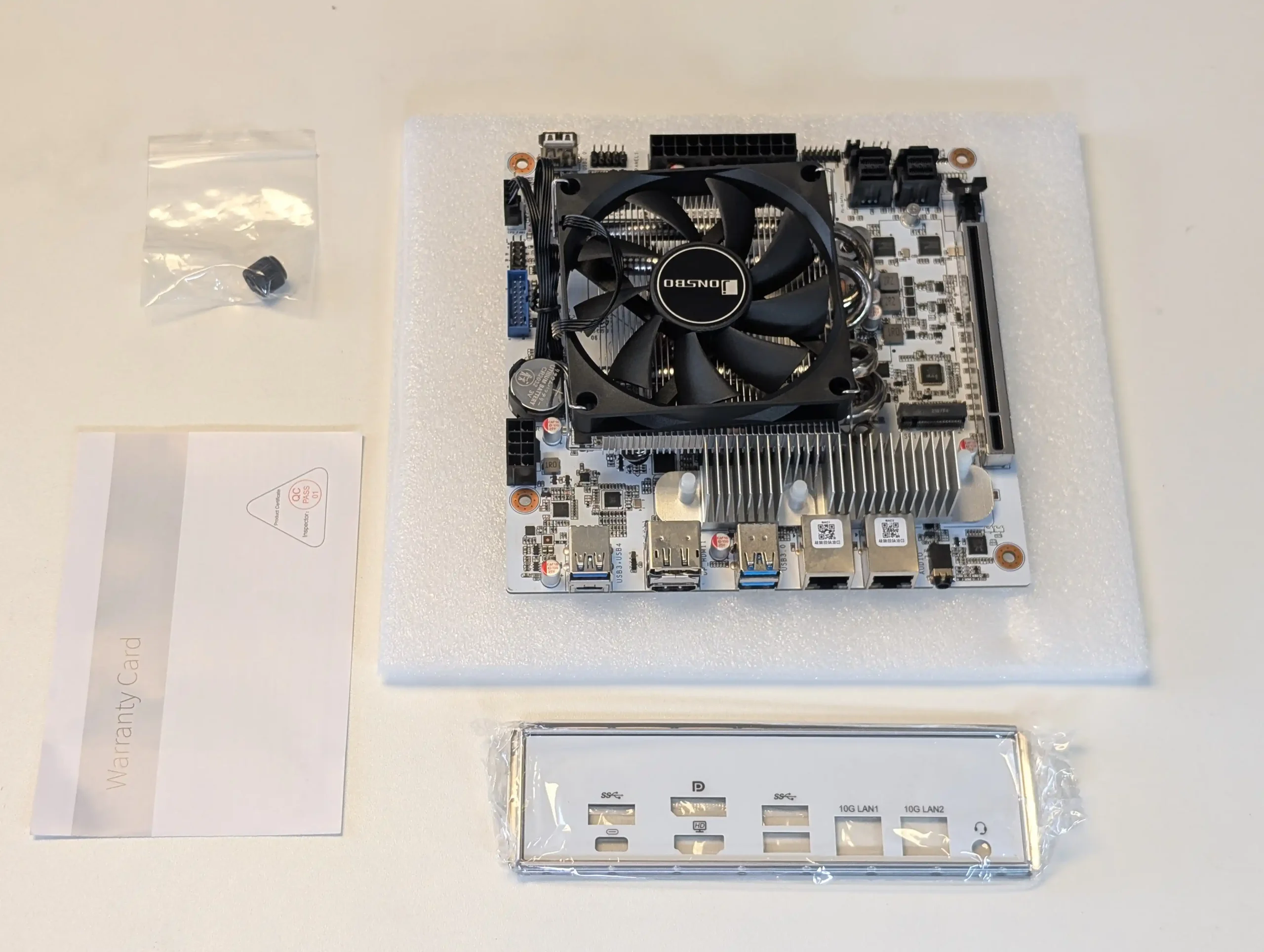
N7 AMD 2x 10GbE NAS Motherboard Review – Quick Conclusion
The MINIROUTE N7 (also marketed under the CWWK brand) delivers an unusually comprehensive blend of performance, connectivity, and storage capacity within the compact constraints of a Mini-ITX form factor, positioning it as one of the most capable motherboards in the DIY NAS and small-server market segment. Centered around the AMD Ryzen 8845HS processor, it provides 8 high-performance Zen 4 cores and 16 threads, along with full PCIe Gen 4 support, dual independent 10GbE RJ45 ports, native 8-bay SATA connectivity via SFF-8643, and dual M.2 NVMe slots running at full PCIe 4.0 ×4 speeds. This combination allows users to build a system capable of high-throughput file sharing, virtualized infrastructure, Docker containers, multimedia handling, and even AI-enhanced workloads if supported by the chosen software environment. Its inclusion of USB4 (40Gbps), bifurcation-ready PCIe x16 slot, and triple display outputs (HDMI, DisplayPort, USB-C with DP Alt Mode) gives it rare versatility, allowing it to serve simultaneously as a NAS, hypervisor, and local-access media or control interface. These features, delivered without the need for PCIe add-in cards or external HBA controllers, simplify the build process and reduce total system cost when compared to equivalent prebuilt systems or workstation boards.
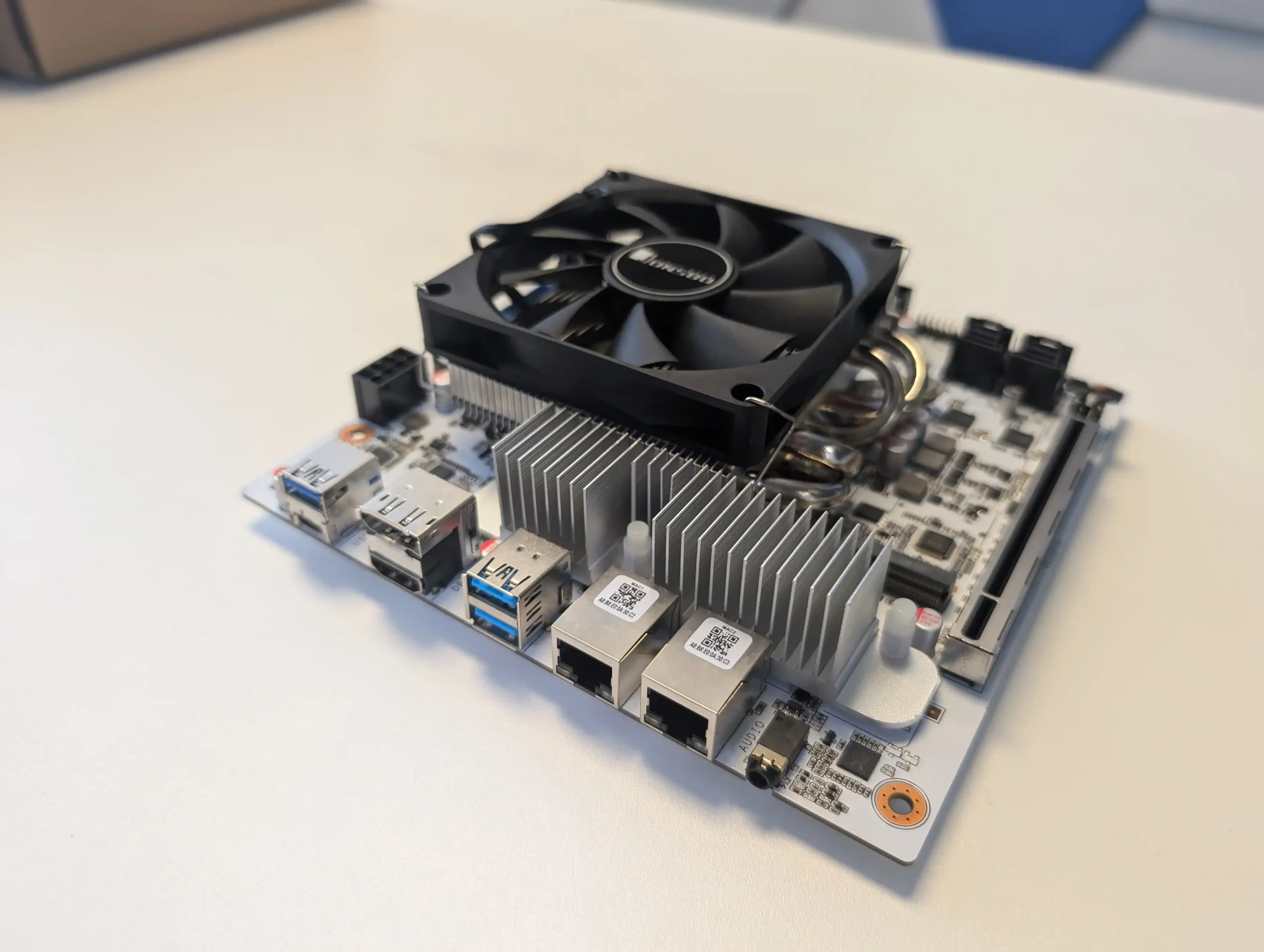
However, these strengths come with notable considerations. The board’s baseline power consumption is significantly higher than what one might find in ARM-based or low-power x86 embedded solutions, and thermals can become a concern under sustained load unless paired with an appropriate LGA1700-compatible cooler and adequate case airflow. Official ECC memory support is absent, which may limit its suitability for enterprise deployments requiring strict data integrity, even though ECC modules are detected in BIOS and several Linux-based NAS OS environments. The SFF-8643 connectors, while efficient and space-saving, add complexity for first-time builders who are unfamiliar with breakout cables or SAS-style drive setups. Despite this, experienced users will find the trade-offs acceptable in light of the raw capability the board offers. Whether you’re deploying TrueNAS SCALE with multiple VMs, using Proxmox for containerized services, or running UnRAID with GPU pass-through and AI indexing, the N7 provides enough bandwidth, I/O, and compute power to support demanding workloads in a footprint small enough to fit in virtually any modern NAS enclosure. For builders who prioritize flexibility, performance, and dense integration over energy efficiency or plug-and-play simplicity, the N7 emerges as one of the most forward-looking DIY NAS platforms currently available.
| Where to Buy? |
N7 AMD 2x 10GbE NAS Motherboard Review – Design and Storage
The MINIROUTE N7 adheres to the Mini-ITX standard with a footprint of 17 × 17 cm, making it compatible with a wide range of compact NAS and SFF (Small Form Factor) enclosures. Despite its small size, the board manages to integrate an unusually dense set of components, routing power and data traces efficiently around the central CPU socket and key interface headers. The board requires both a standard 24-pin ATX and 4-pin CPU power connector, which is a practical choice for users reusing off-the-shelf ATX PSUs. The component layout is designed for vertical airflow, which aligns well with tower-style NAS chassis using top-down cooling. Passive heat dissipation is supplemented by a large copper heatsink preinstalled over the CPU and chipset area, although users will need to add a compatible LGA1700 cooler for effective thermal management in prolonged workloads.
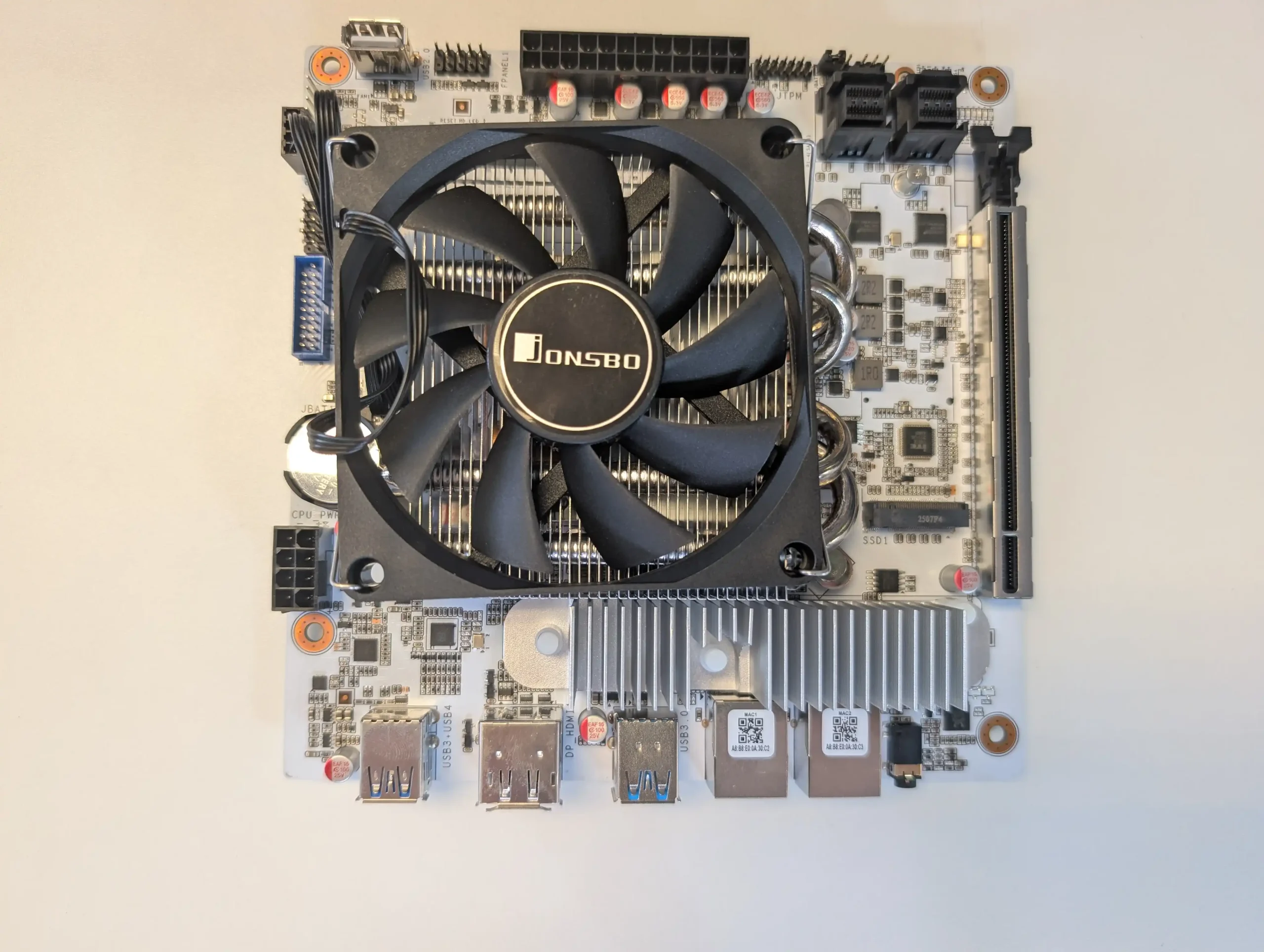
Drive connectivity on the N7 is handled via two onboard SFF-8643 ports, each supporting up to four SATA 3.0 devices through breakout cables. These mini-SAS connectors route through onboard ASMedia ASM1164 controllers and offer up to 6Gbps per port, enabling up to eight storage devices across a single board without the need for a separate HBA card. Each SFF-8643 port is linked to a PCIe Gen 3 x1 lane, which limits peak throughput to just under 1GB/s per group of four drives.
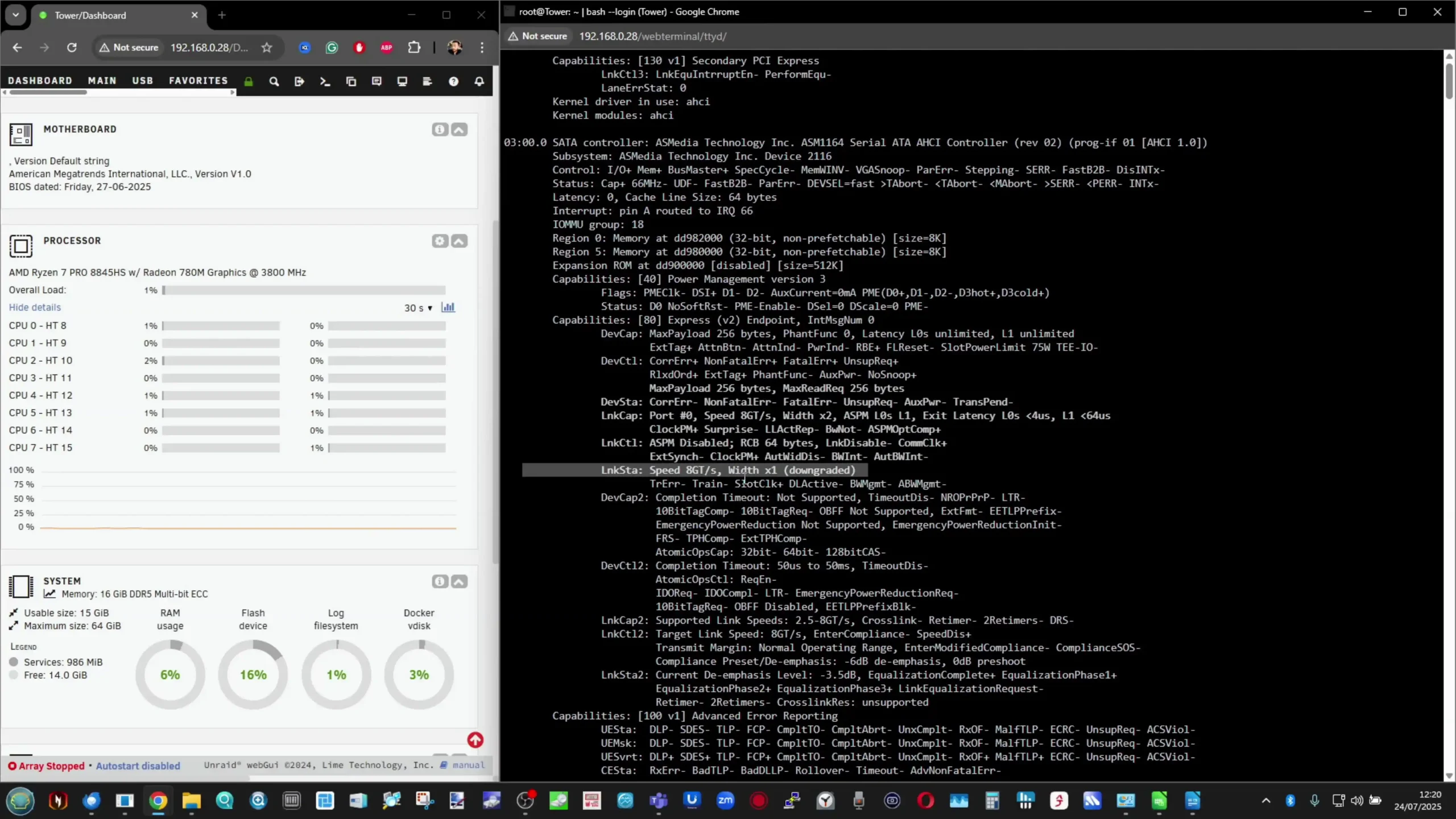
While this isn’t a bottleneck in typical NAS workloads involving sequential reads/writes from hard drives, it may constrain performance with large SSD arrays or heavy mixed IOPS usage. Included in the box are two breakout cables for converting the 8643 ports to 4 × SATA each, streamlining setup and making the N7 more appealing for users assembling 6- to 8-bay NAS systems without additional add-ons.
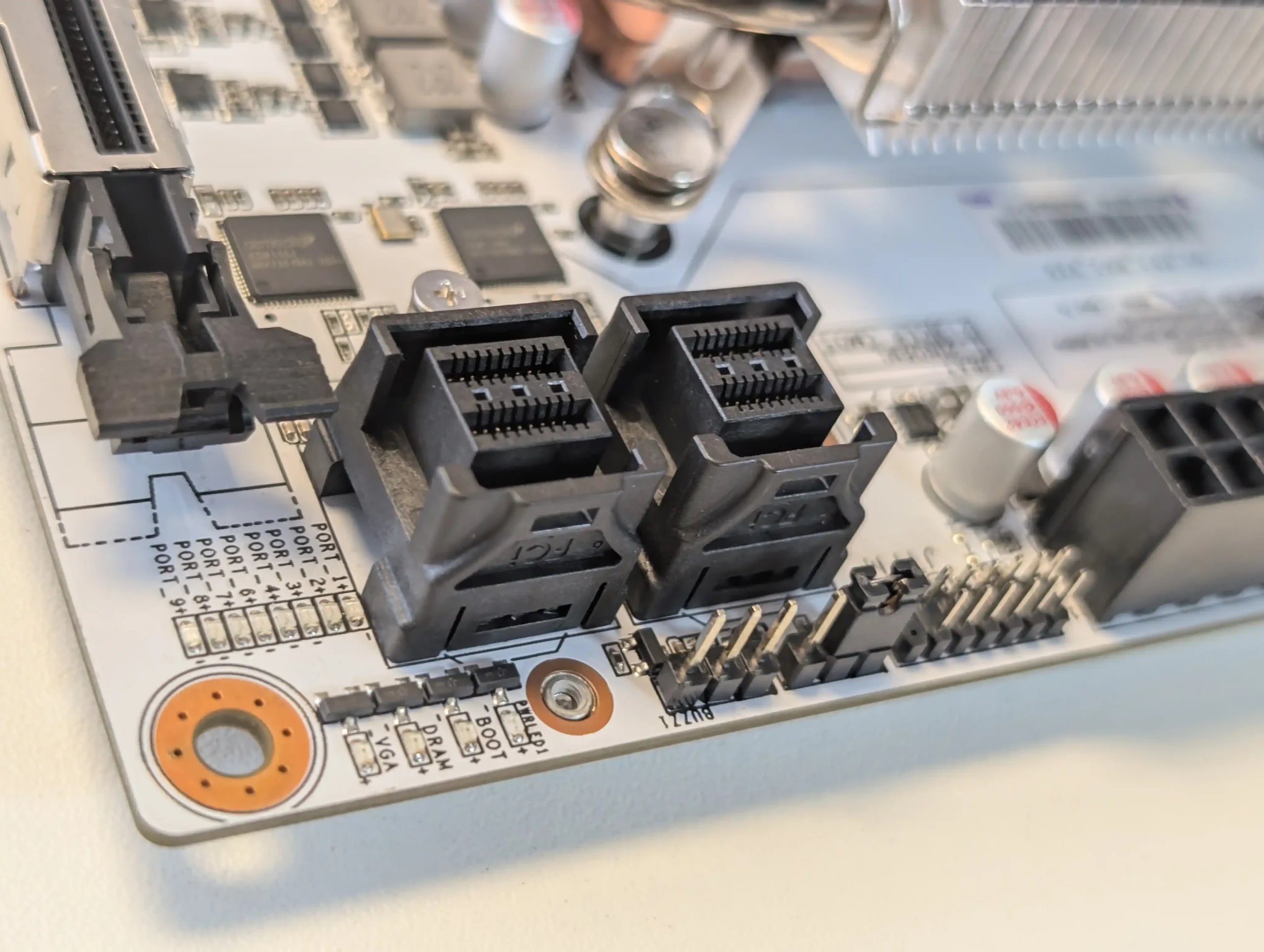
The N7’s decision to use SFF-8643 instead of individual SATA headers is a deliberate choice that favors a clean internal cable setup, particularly in compact NAS cases with limited clearance or rear-mounted drive cages. This design also supports the use of add-on expansion modules such as CWWK’s 6-bay carrier boards or U.2 and M.2 SATA-to-SFF adapters, adding deployment flexibility for those planning to use a mix of HDDs and SSDs.
During physical inspection and test installation, the SATA connectors routed cleanly to the front of the board, minimizing crossflow interference for cooling and allowing for unobstructed access to RAM and NVMe slots. This layout, while compact, doesn’t obstruct airflow or block RAM or PCIe slot access even when all drive connections are populated.
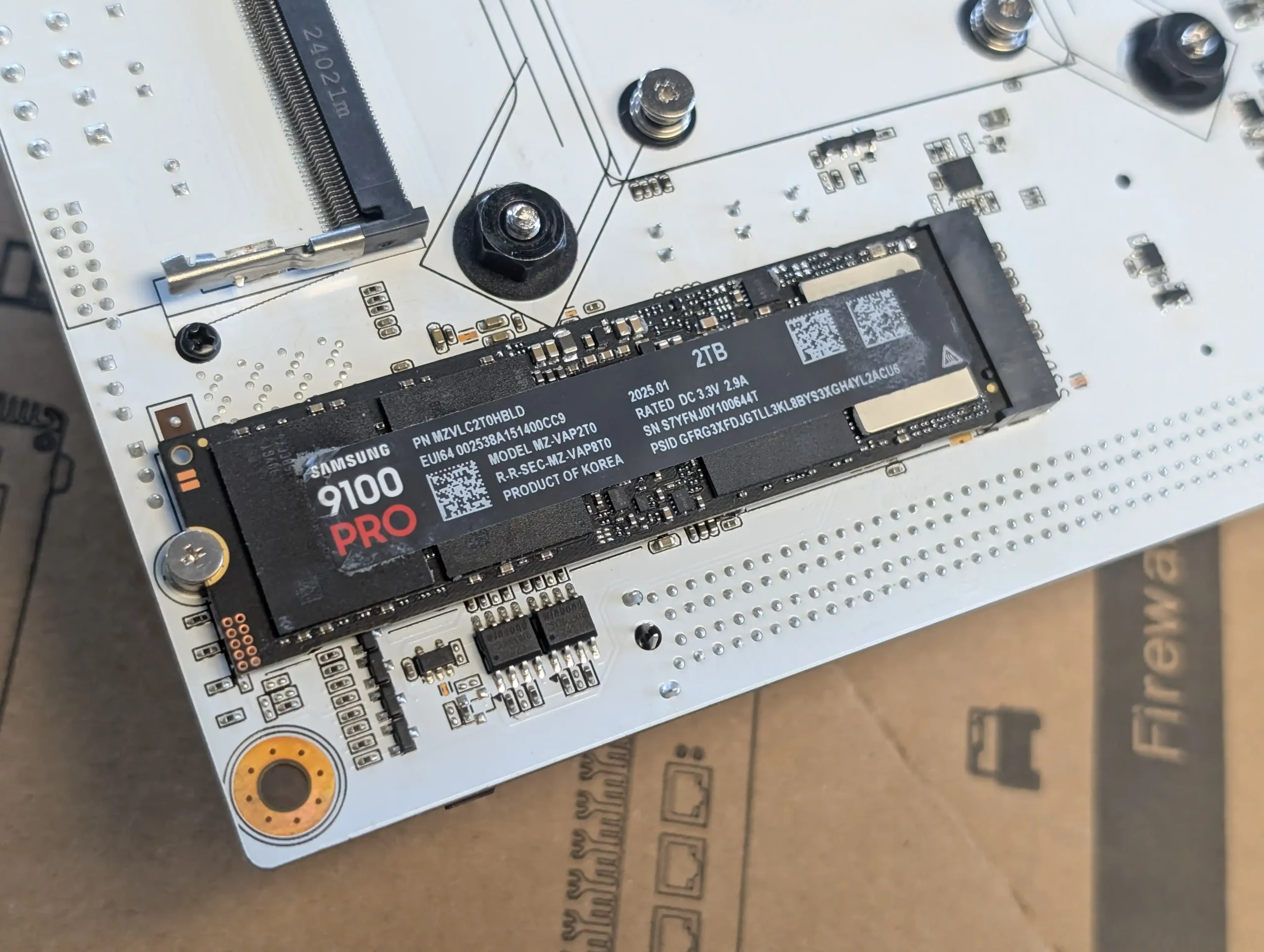
Storage expansion is also supported via two M.2 NVMe slots: one mounted on the top side of the board and one underneath. Both slots support 2280-length drives at PCIe Gen 4 x4 speeds, providing ample bandwidth for SSD caching or fast boot devices. These NVMe drives are independent of the SATA controller and do not share lanes with the PCIe or USB4 ports, according to observed behavior during SSD testing. Read speeds on Gen 4 drives approached 5.1 GB/s, while write speeds hovered around 4.6 GB/s under sequential workloads. Thermals for these slots will depend on case design and airflow, as there are no included heatsinks for the M.2 bays—something users building 24/7 systems will want to address through motherboard-side or chassis-side cooling accessories.
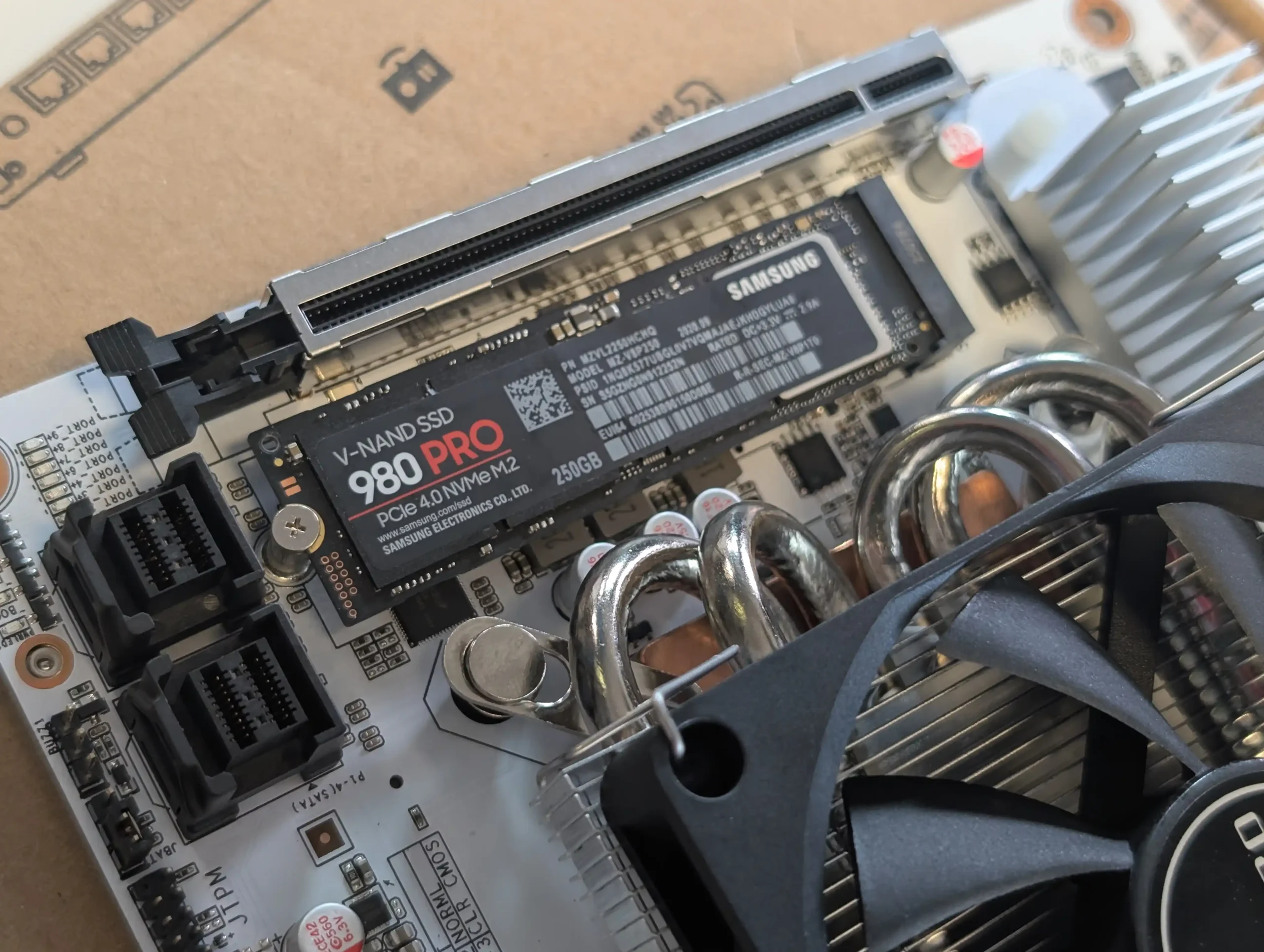
The storage layout and capacity potential make the N7 particularly well suited for software-defined storage platforms like TrueNAS SCALE, UnRAID, and ZimaOS. RAID arrays, SSD cache pools, and hybrid tiered storage setups can all be constructed using the eight SATA and two NVMe interfaces. Although bandwidth on the SFF-8643 links is limited compared to dedicated HBA cards, the simplicity and integration on a Mini-ITX board are notable advantages. For users building an 8-bay NAS that includes SSD-based caching or boot storage, the N7’s native options reduce both hardware complexity and overall build cost. The only notable storage-related limitation is the lack of support for hardware RAID or U.2 ports natively, but given its price and form factor, the board aligns well with the needs of most advanced DIY NAS builders.
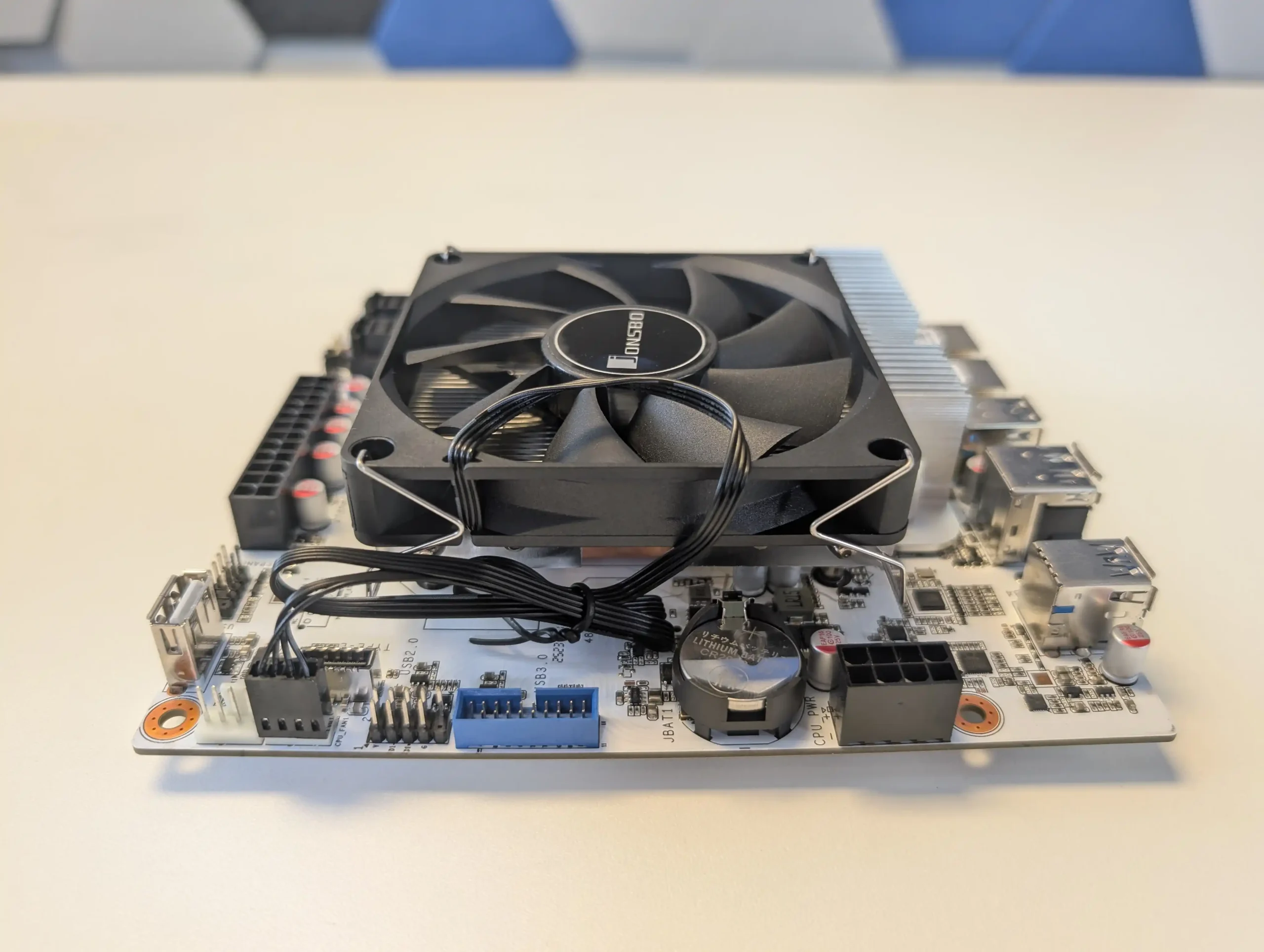
N7 AMD 2x 10GbE NAS Motherboard Review – Hardware
At the center of the N7 motherboard is the AMD Ryzen™ 8845HS processor, a Zen 4-based 8-core, 16-thread CPU designed for high-efficiency performance in mobile and embedded systems. With a base clock of 3.8GHz and a maximum boost clock of 5.1GHz, this chip provides considerably more computational headroom than most processors found in pre-built NAS devices or ITX boards at this price point. Its multithreaded performance is particularly well-suited for tasks like virtualization, multi-user services, parallel Docker workloads, and software-defined storage management.
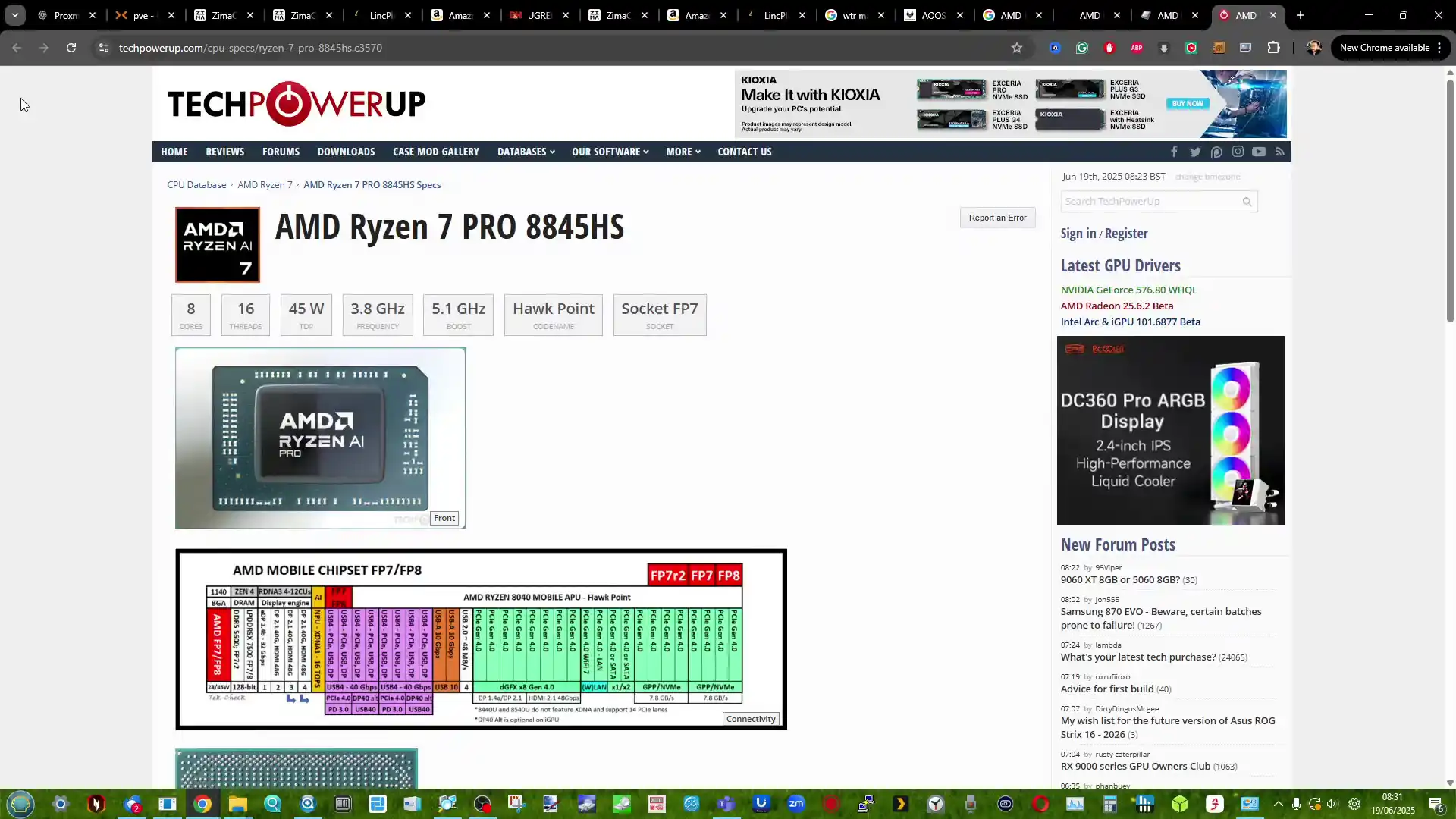
The CPU also integrates AMD’s Radeon 780M graphics engine, based on RDNA 3 architecture, with 12 GPU cores clocked at up to 2.7GHz, which is more than adequate for media playback, transcoding, or even light GPU-accelerated applications under supported environments.
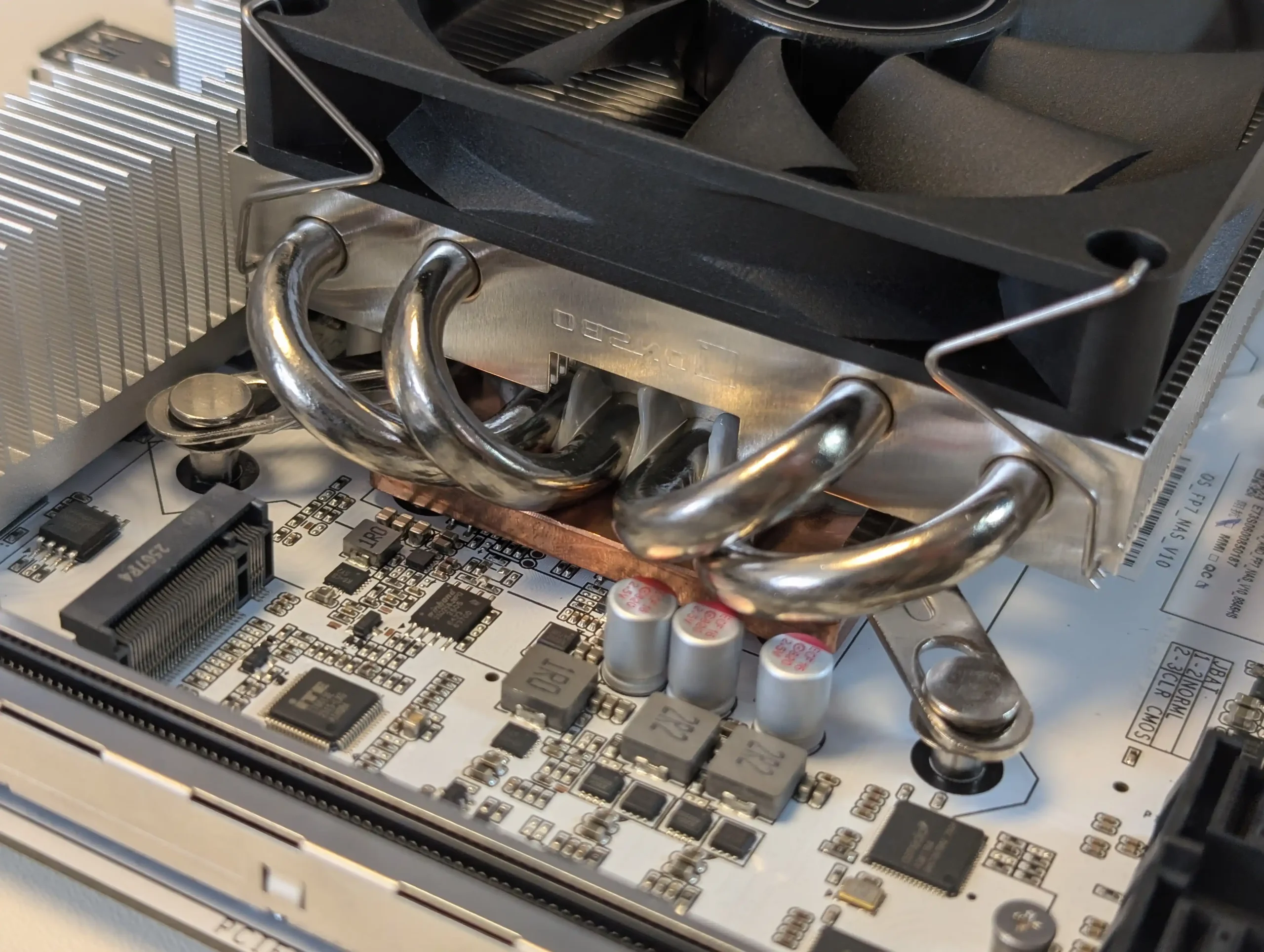
Furthermore, the inclusion of the AMD Ryzen AI engine adds another dimension to its capabilities, offering up to 16 TOPS of local inference performance—opening the door for AI-driven surveillance, metadata tagging, and potentially video analytics if supported by the NAS OS or containers used.
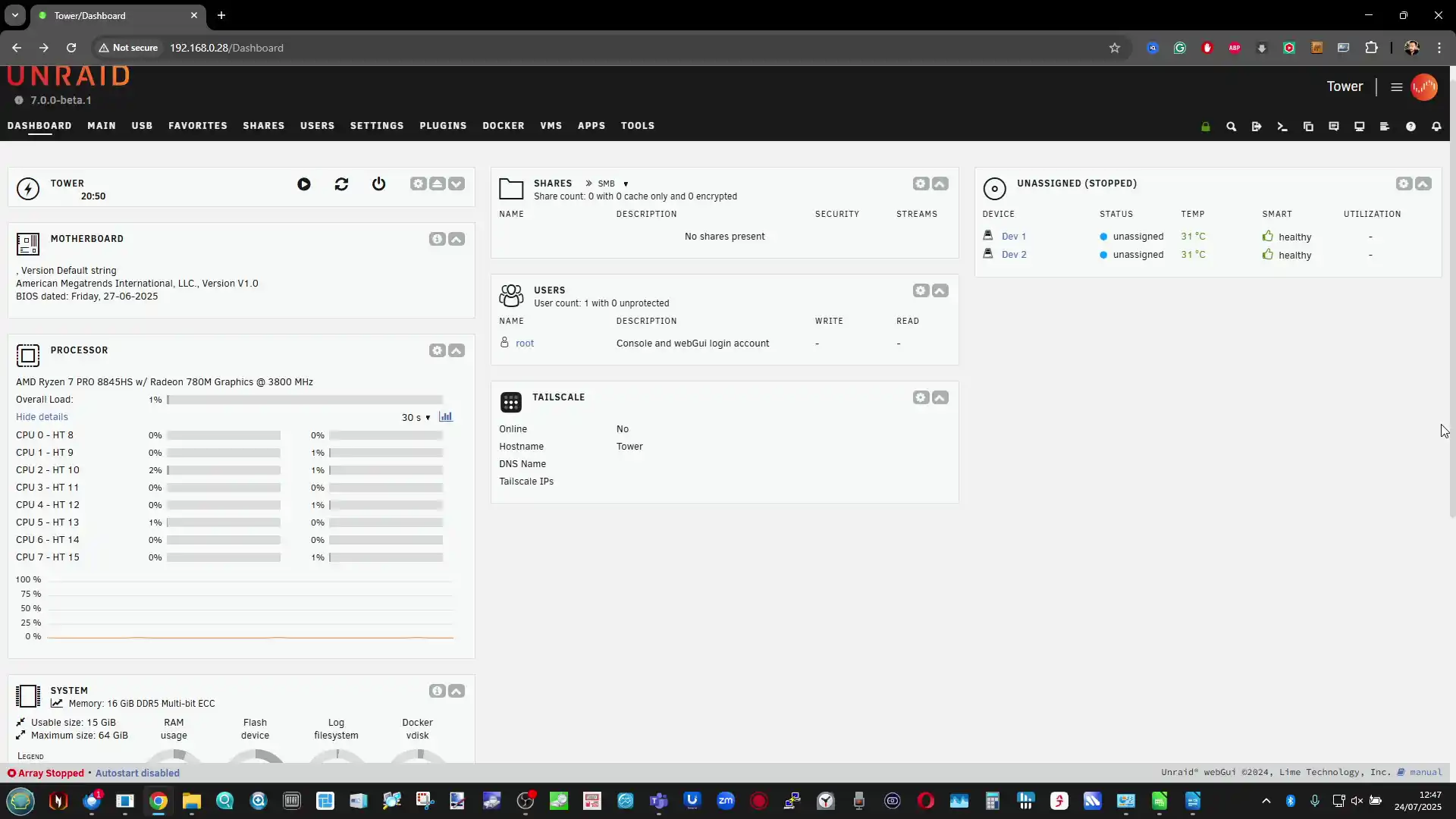
Memory support is provided through two DDR5 SO-DIMM slots, with default 5600MHz support and capacity up to 48GB per stick, enabling a maximum of 96GB of RAM. This high memory ceiling is advantageous for power users running memory-intensive services such as RAM-cached storage, ZFS-based deduplication, large-scale container deployments, or multiple virtual machines. Although the board does not officially support ECC memory, testing on platforms such as UnRAID and ZimaOS showed that ECC modules are recognized and initialized, albeit without clear confirmation of active error correction.
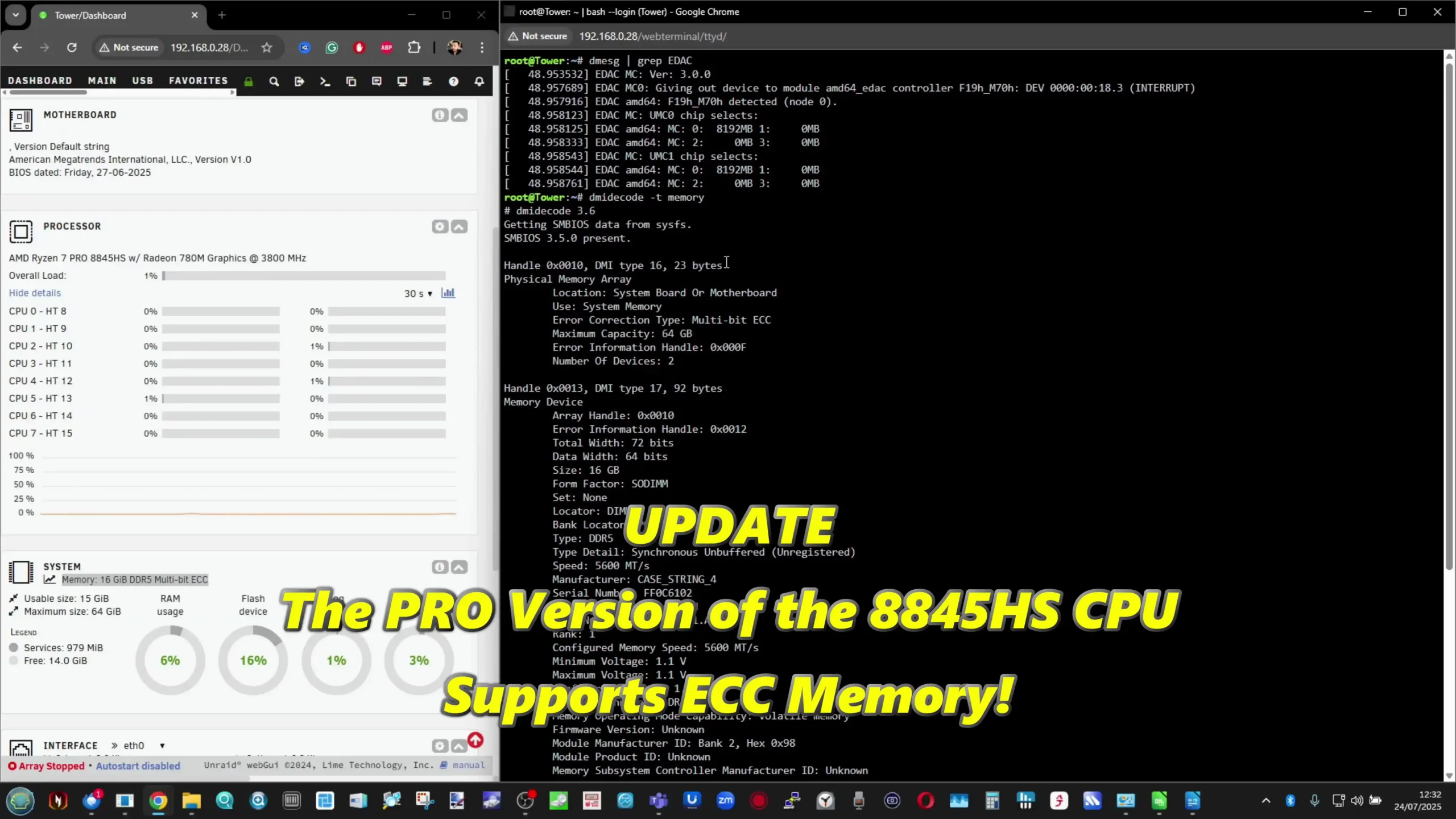
Later investigation showed that the PRO version of the 8845HS CPU does in fact support ECC, whereas the standard 8845HS here does not – which is a shame that there is not a separate configuration that includes this CPU available from the brand at an additional cost for users who consider ECC support a ‘deal breaker’. The SO-DIMM slots are well-positioned and unobstructed, allowing for tool-free upgrades or swaps without removing other components, which is especially important given the compact ITX layout and potential space constraints in NAS enclosures.

What sets the N7 apart from most Mini-ITX NAS boards is its thoughtful PCIe lane distribution, which takes full advantage of the 20 available PCIe Gen 4 lanes provided by the Ryzen 8845HS.
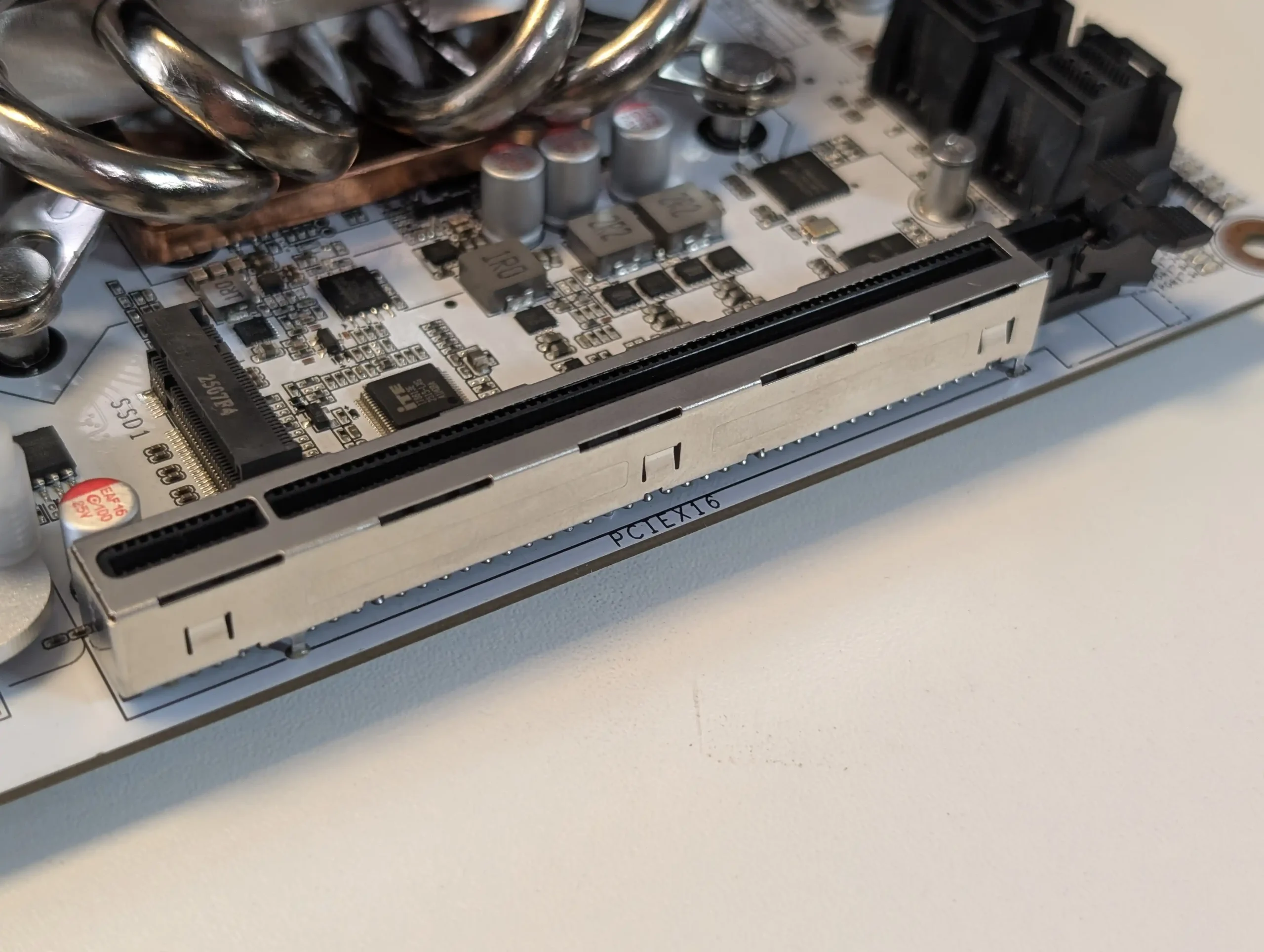
The full-length PCIe slot operates at Gen 4 x8 by default, but also supports bifurcation into dual x4 via BIOS for users installing expansion cards like dual-NVMe adapters or multi-port network cards.
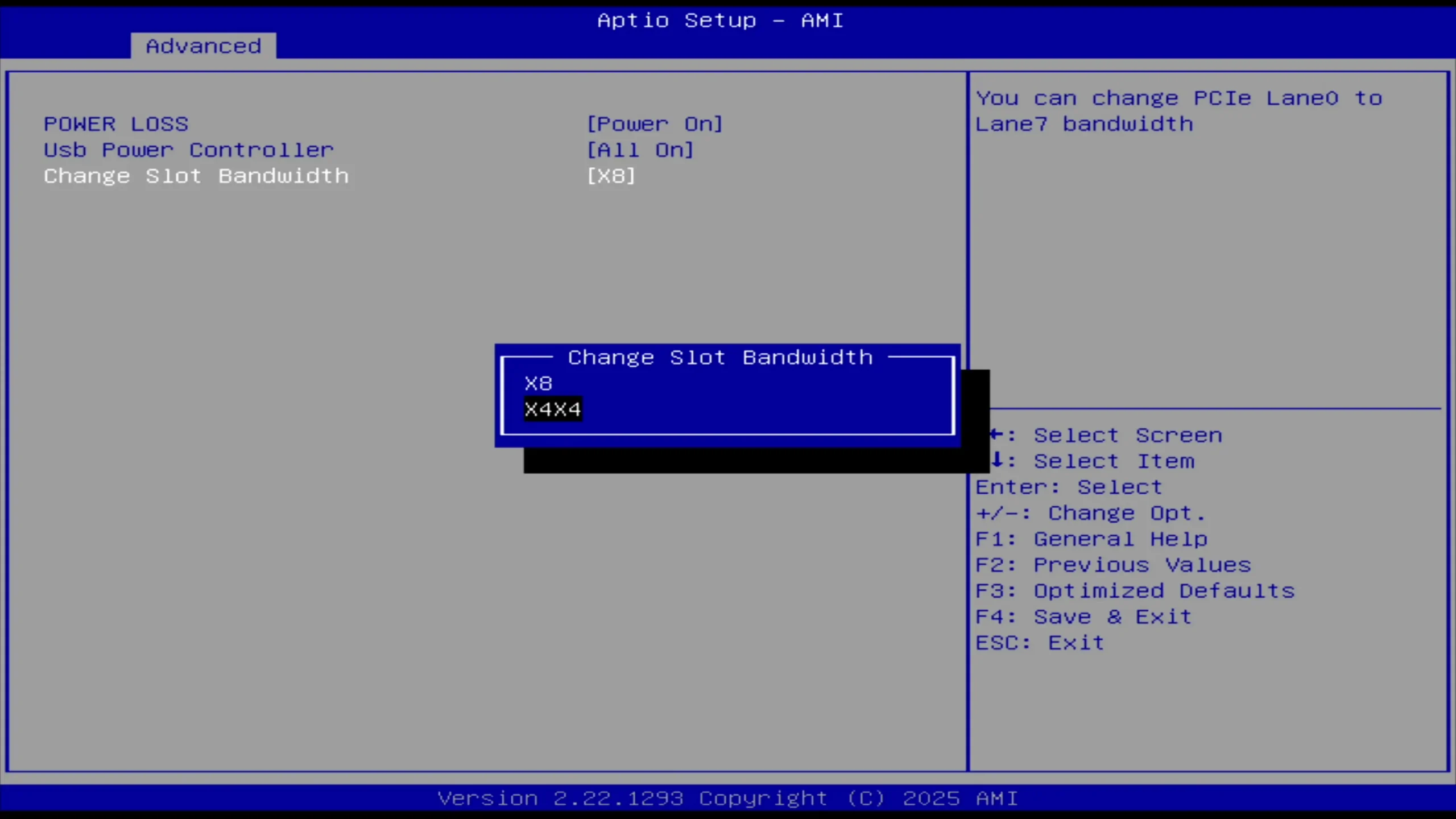
Each M.2 NVMe slot is also connected via a dedicated PCIe Gen 4 x4 lane, ensuring maximum bandwidth of up to 8GB/s for modern SSDs, without any shared bandwidth with SATA or network interfaces.
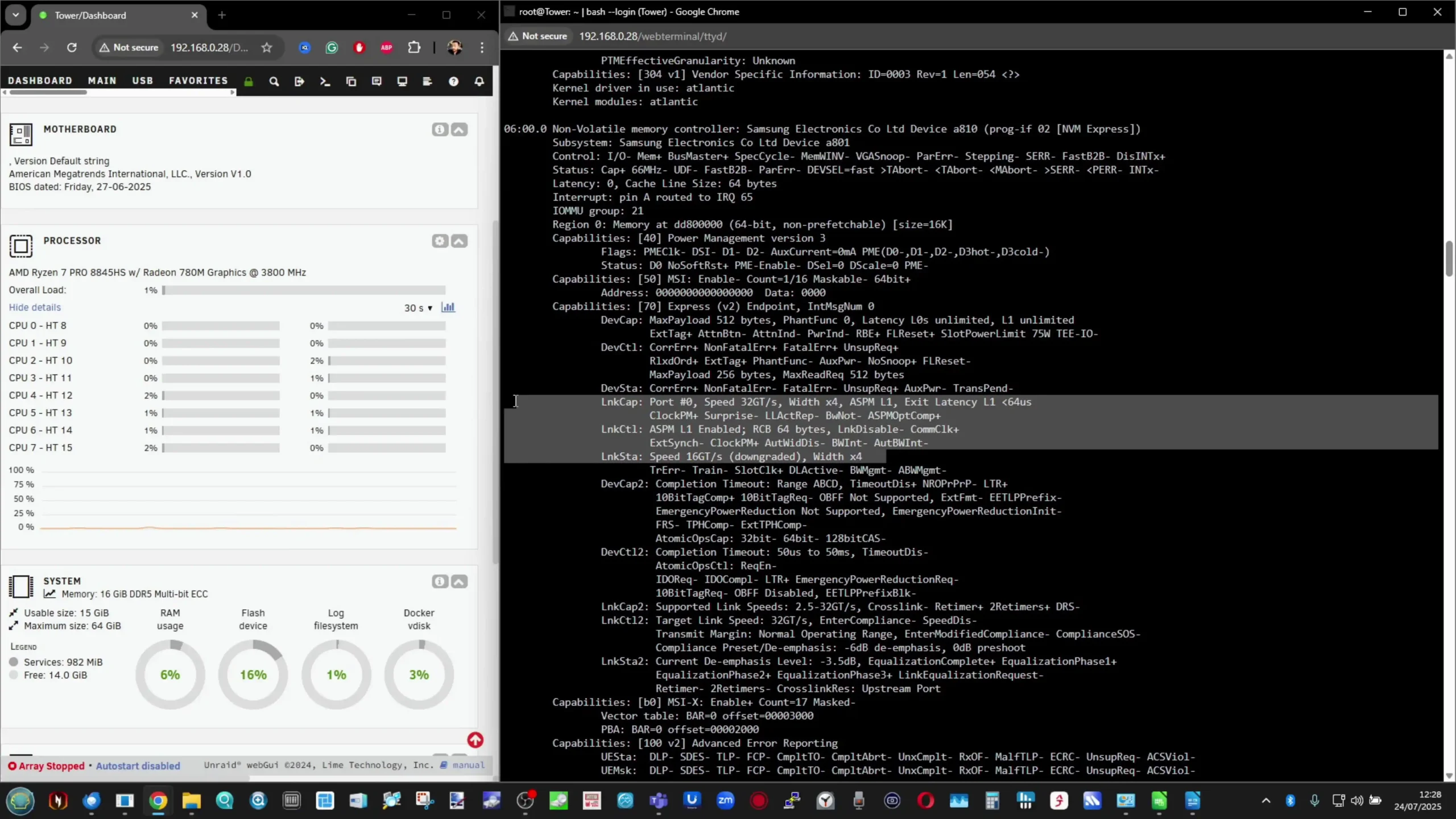
The two onboard 10GbE RJ45 ports are served by separate Aquantia AQC113C controllers, each connected via their own PCIe Gen 4 x1 link, giving up to 2GB/s per port and ensuring full-duplex throughput without crosstalk.
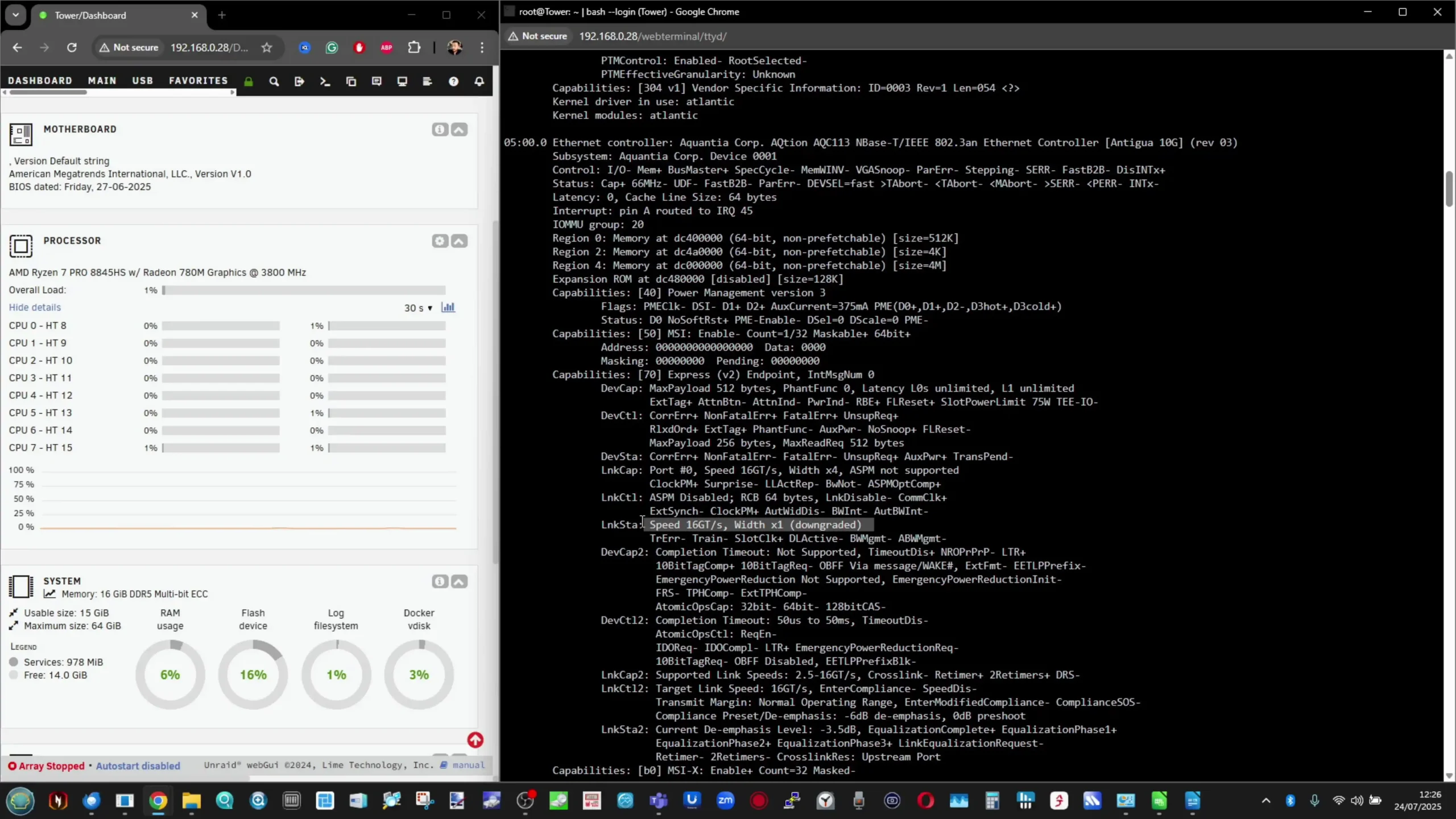
This dedicated lane allocation across network, storage, and expansion interfaces is rare in compact boards and critical for users seeking consistent performance under concurrent high-load scenarios like multi-user file access, SSD-based caching, and active VM hosting.
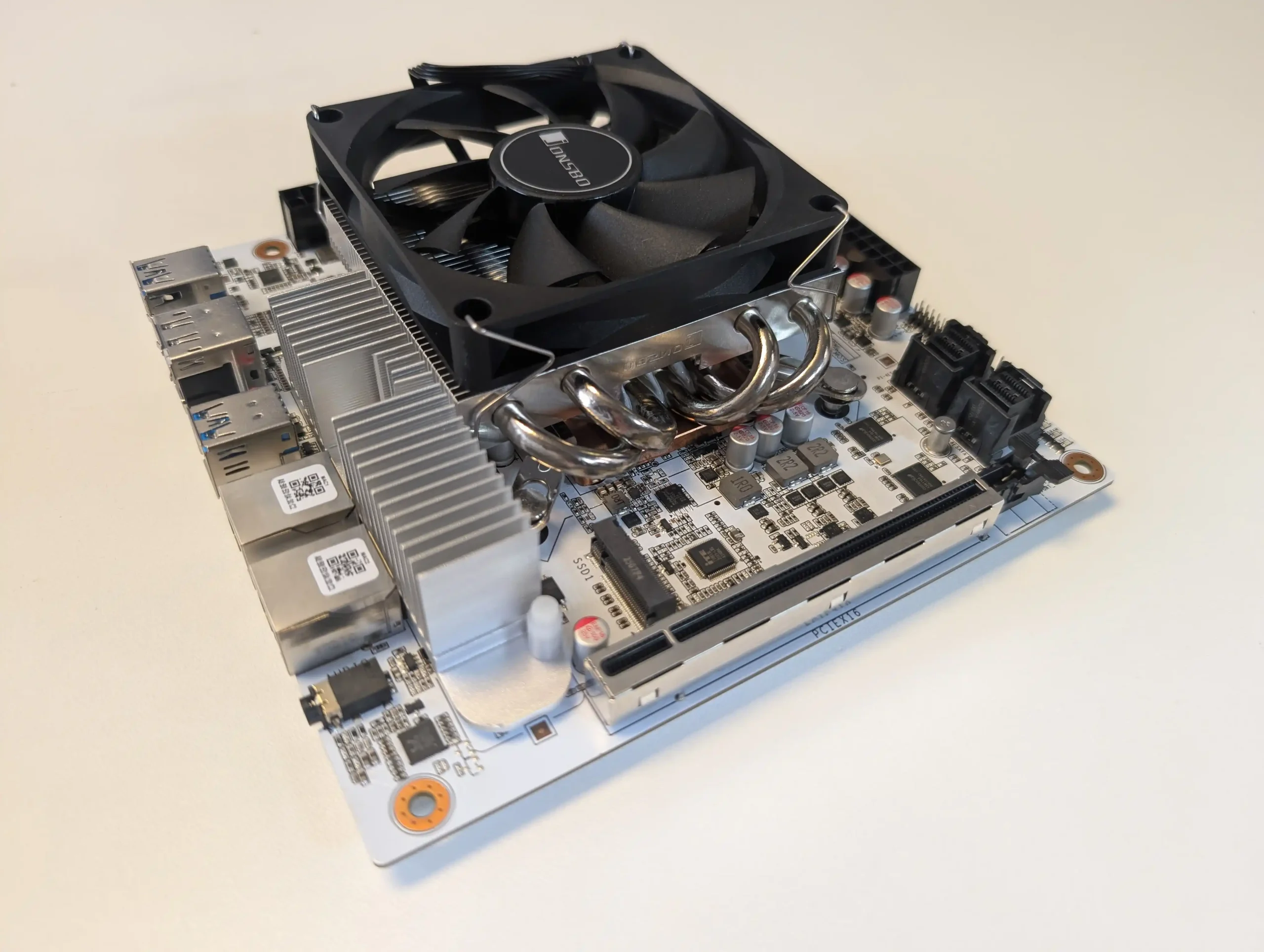
| Category | Specification |
|---|---|
| Model | MINIROUTE N7 / CWWK N7 NAS ITX Motherboard |
| Form Factor | Mini-ITX (17 × 17 cm) |
| Processor | AMD Ryzen™ 8845HS (8 cores / 16 threads, Zen 4, up to 5.1GHz) |
| GPU | AMD Radeon™ 780M (12 cores, up to 2.7GHz) |
| AI NPU | AMD Ryzen™ AI Engine (up to 16 TOPS) |
| Chipset | SoC (Integrated, no discrete chipset) |
| Memory Support | 2 × DDR5 SO-DIMM (up to 96GB total, 5600MHz, non-ECC officially) |
| M.2 Slots | 2 × M.2 2280 NVMe (PCIe Gen 4 ×4 each; top + rear-mounted) |
| SATA Ports | 2 × SFF-8643 (8 × SATA 6Gb/s total via included breakout cables) |
| SATA Controller | 2 × ASMedia ASM1164 (PCIe Gen 3 ×1 each) |
| PCIe Slot | 1 × PCIe x16 (Gen 4 ×8 signal; bifurcation to 2 × x4 supported) |
| Ethernet Ports | 2 × 10GbE RJ45 (Aquantia AQC113C-B1, auto-negotiating 10/5/2.5/1GbE/100M) |
| USB Ports | 1 × USB4 Type-C (40Gbps), 3 × USB 3.2 Gen1 (5Gbps) |
| Internal USB | 1 × USB 3.0 header, 1 × USB 2.0 header, 1 × Type-E header |
| Audio | 1 × 3.5mm combo audio jack |
| Display Output | 1 × HDMI, 1 × DisplayPort, 1 × USB-C (Alt Mode); up to 8K supported |
| Power Input | 24-pin ATX + 4-pin CPU |
| Cooling | Passive copper heatsink (LGA1700-compatible; cooler not included) |
| Package Includes | 2 × SFF-8643 to 4×SATA cables, I/O shield, screws, warranty card |
N7 AMD 2x 10GbE NAS Motherboard Review – Ports and Connections
The MINIROUTE N7 motherboard delivers a well-rounded set of connectivity options, with a clear emphasis on high-speed networking and data transfer—features that are increasingly essential in modern NAS environments. Dominating the rear I/O are two 10GbE RJ45 ports, each backed by an Aquantia AQC113C-B1 controller and connected via independent PCIe Gen 4 ×1 lanes. This design ensures that each network interface operates without contention, allowing for sustained full-duplex bandwidth on both ports simultaneously.
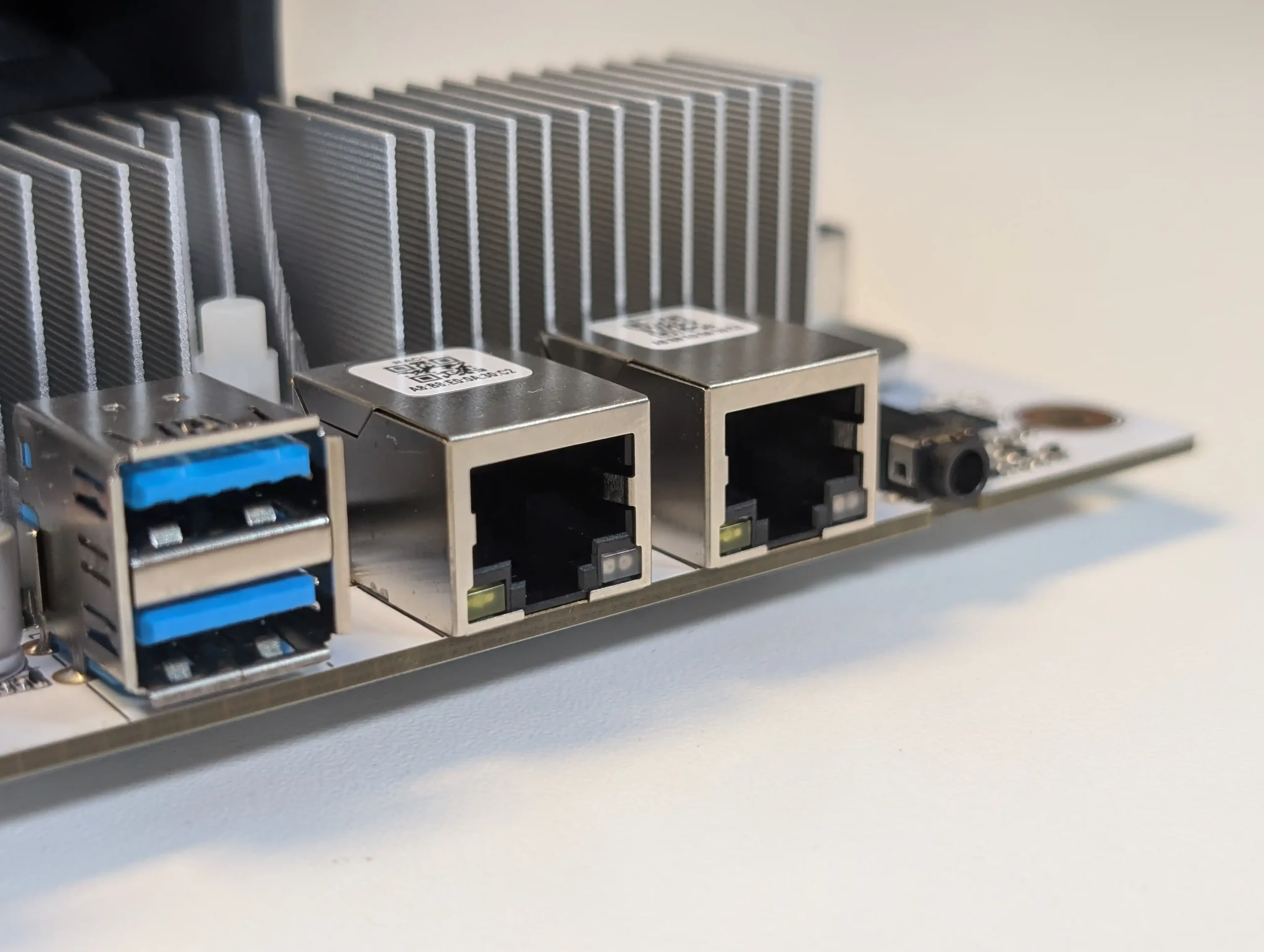
The ports support all major Ethernet standards from 100M up to 10Gbps, enabling the board to adapt to diverse infrastructure including SMB networks, prosumer switches, and enterprise environments with 10GBase-T. For users setting up link aggregation (LACP), isolated network zones (i.e., separation of iSCSI and SMB), or even point-to-point replication between servers, these dual interfaces offer deployment flexibility typically absent on most consumer-grade ITX boards. While copper 10GbE does introduce higher thermal output compared to SFP+, the choice improves compatibility for users relying on standard RJ45 cabling and avoids the cost of optical transceivers.
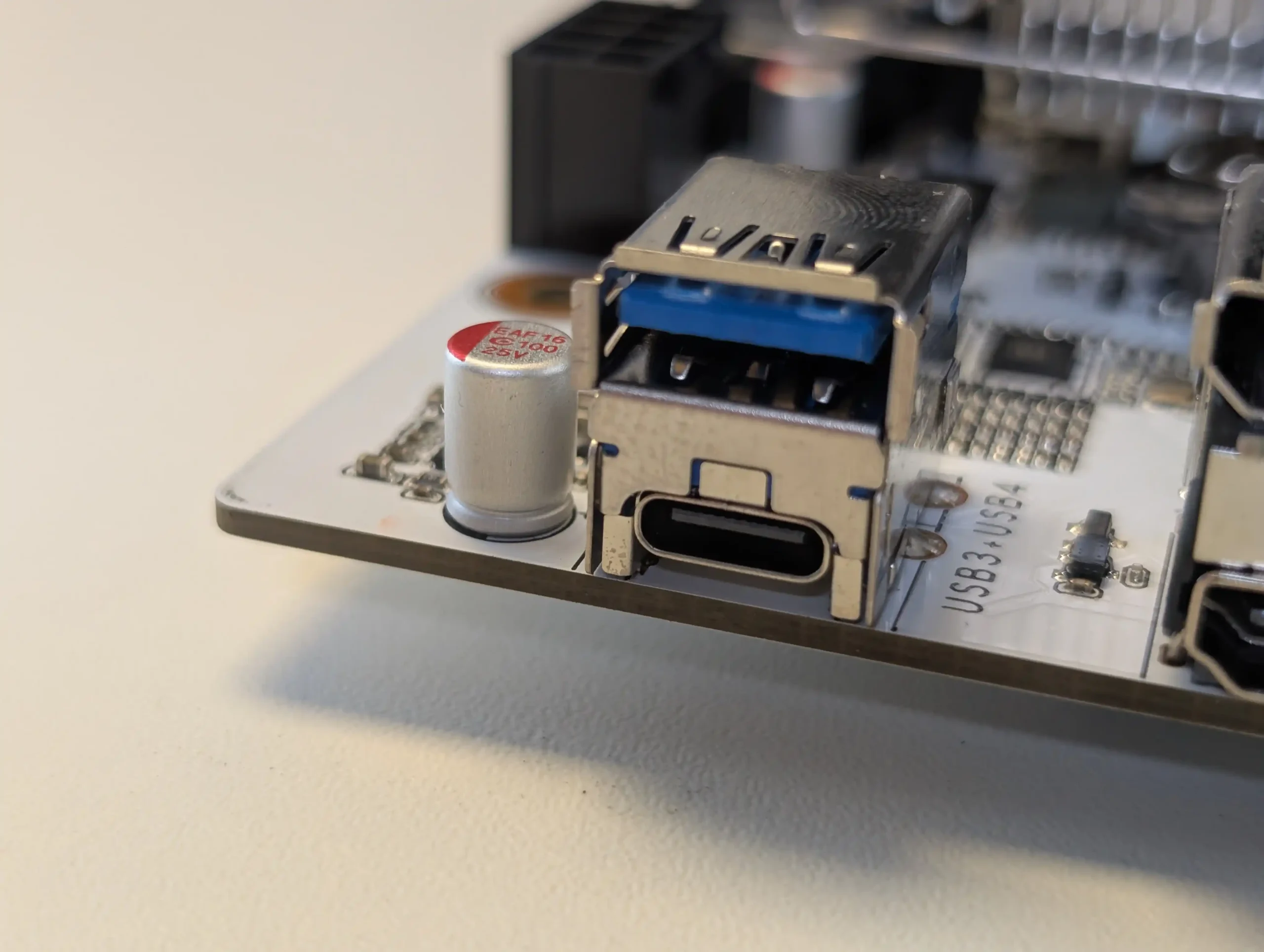 |
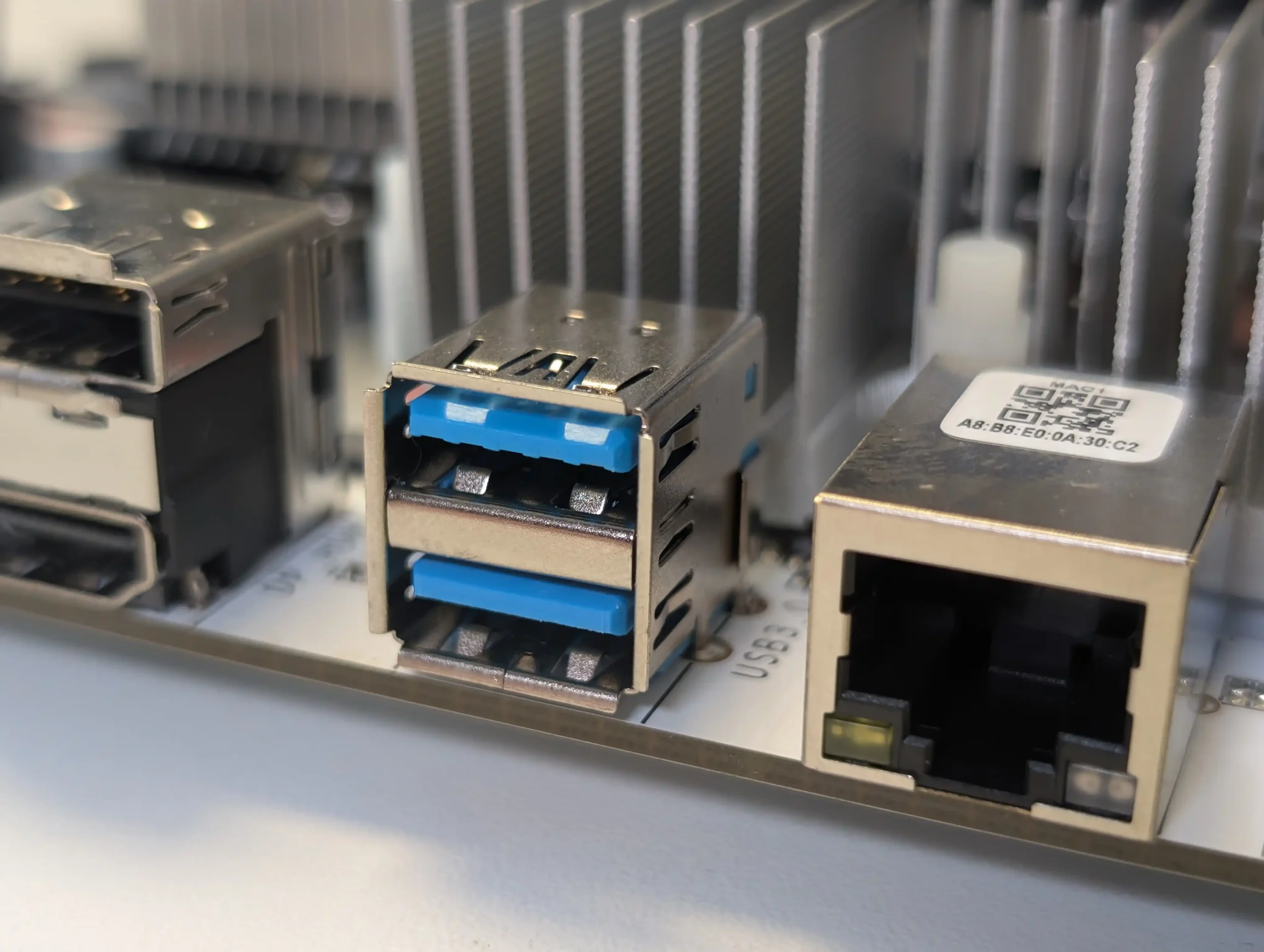 |
On the USB front, the N7 integrates a versatile mix of legacy and next-generation interfaces to accommodate a range of peripheral scenarios. The single USB4 Type-C port supports up to 40Gbps data throughput, enabling fast access to NVMe-class external storage or high-resolution display output via DP Alt Mode. It also opens the door for emerging use cases such as external GPU enclosures, dock expansion, or USB4-to-10GbE adapters—particularly valuable for users running Linux distributions like ZimaOS or Proxmox, where hardware passthrough and device mapping are becoming more accessible.
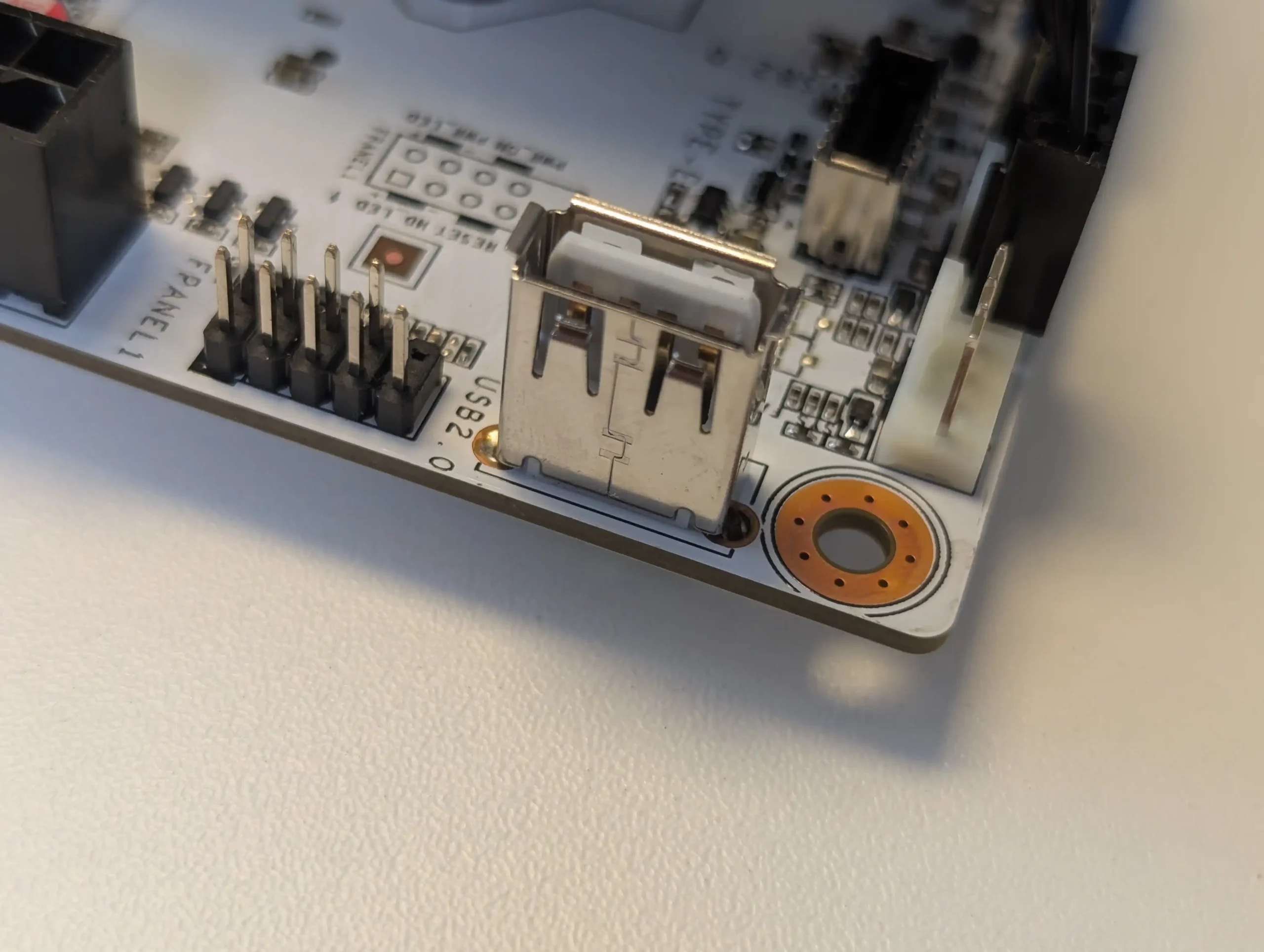
Three additional USB 3.2 Gen1 (5Gbps) Type-A ports are located on the rear I/O and work as expected for more common devices like USB storage drives, UPS interfaces, or external backup systems. Internally, the board offers a USB 3.0 header for front-panel case ports, a USB 2.0 header for basic boot/recovery drives, and a Type-E header compatible with front-panel USB-C or TPM modules. During testing, USB Ethernet dongles including Realtek-based 2.5GbE and 5GbE models were recognized immediately under supported NAS OS environments, and native USB boot was stable across ZimaOS, UnRAID, and TrueNAS.
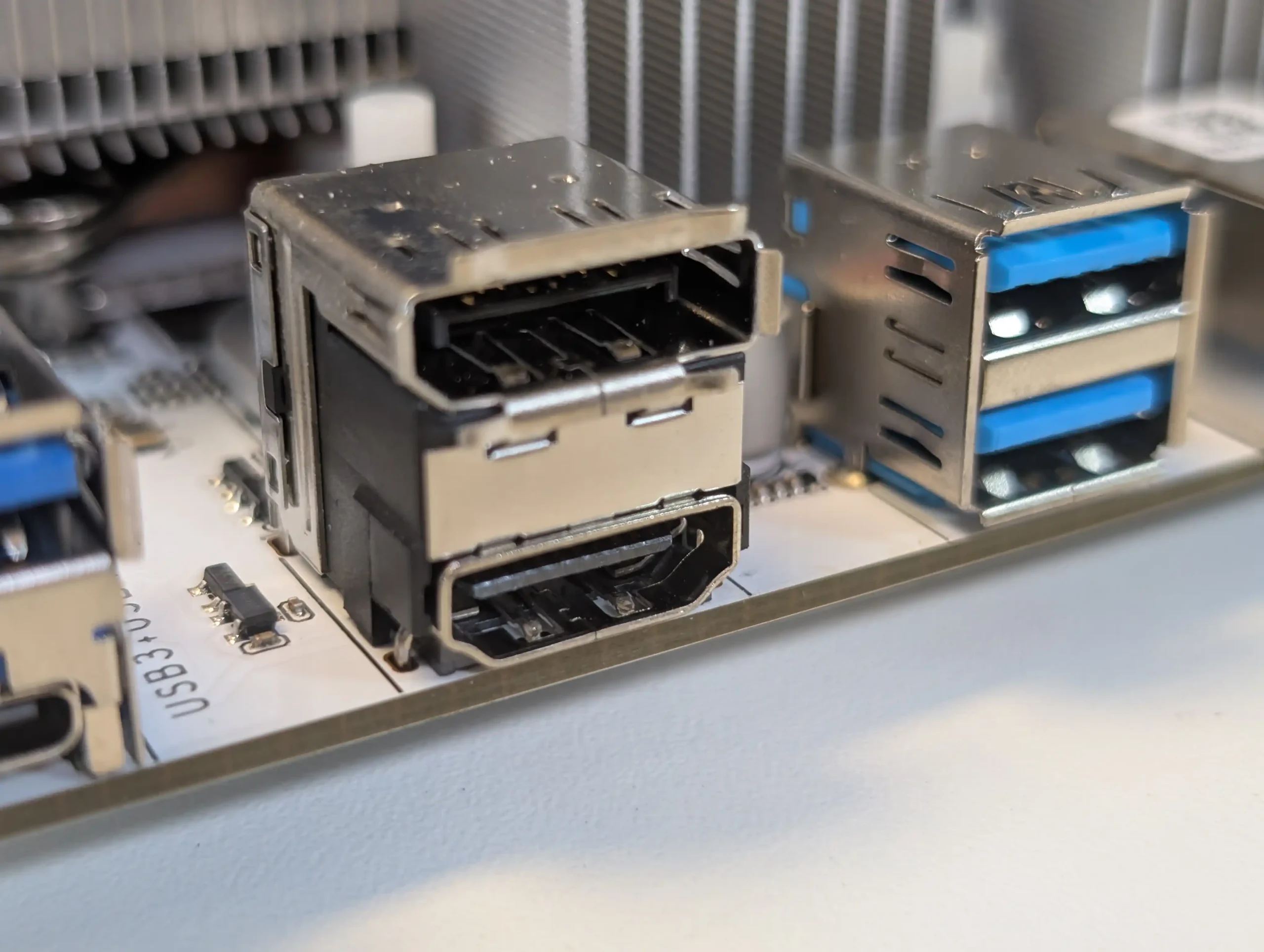
Display and peripheral audio output are also included, which broadens the board’s versatility beyond a pure headless NAS application. The board features three display output options: HDMI, DisplayPort, and USB-C via DP Alt Mode, all of which are powered by the integrated Radeon 780M GPU. These outputs can drive up to three displays concurrently, with resolutions up to 4K on all three or up to 8K on select single-display configurations.
This makes the board suitable for tasks like media center builds, HTPC-NAS hybrids, or running direct-access GUIs for NAS software like UnRAID’s web dashboard or Proxmox’s virtual console. The inclusion of these outputs also benefits users setting up the board as a temporary workstation or using the NAS in roles that require visual monitoring, such as security recording or local video playback via Jellyfin. Finally, a 3.5mm combo audio jack is available for users needing direct analog audio output—for example, for alerts, monitoring systems, or simple desktop playback. While not essential for most server roles, these extras enhance the board’s adaptability for multi-role deployments.
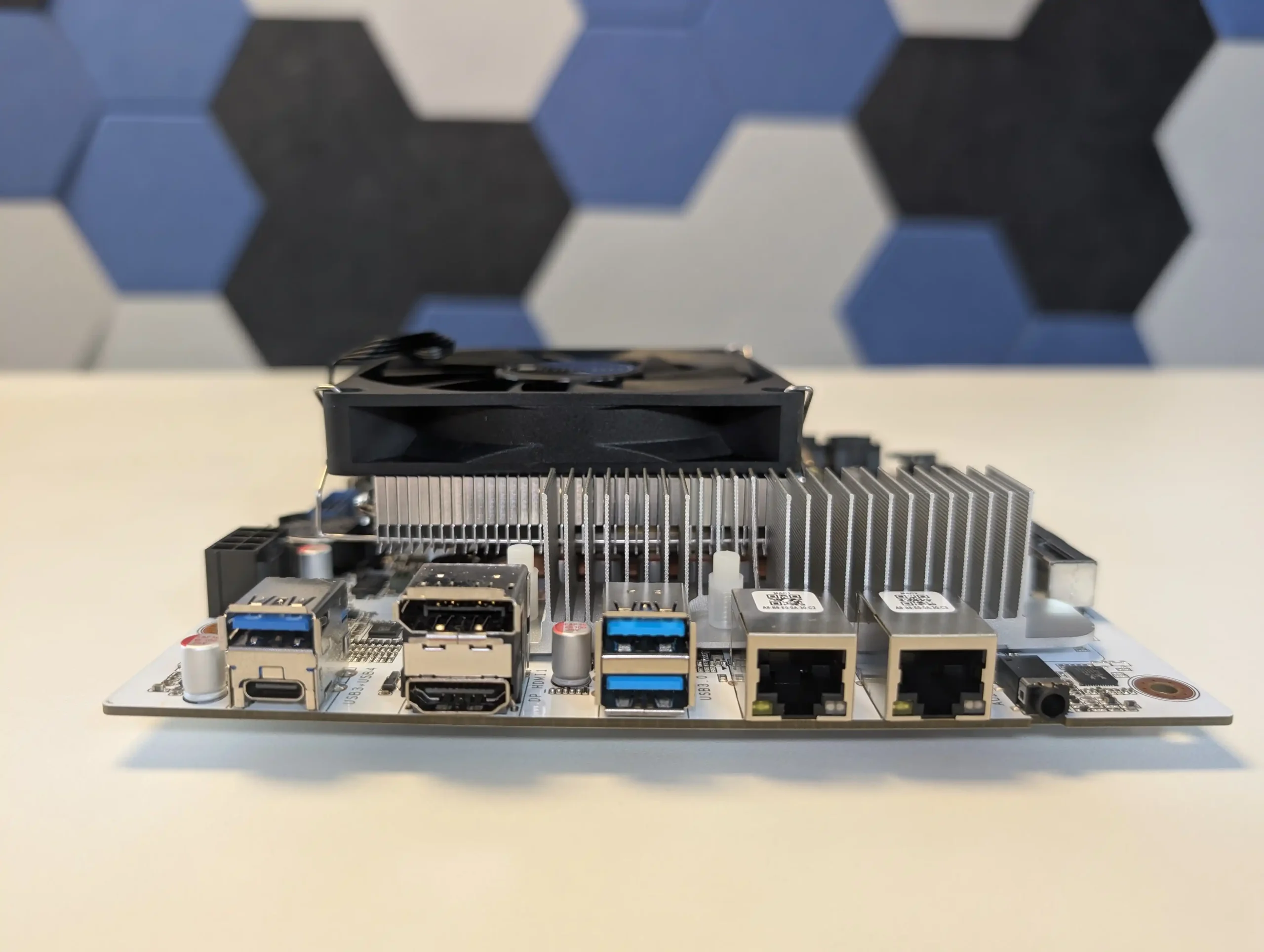
N7 AMD 2x 10GbE NAS Motherboard Review – Heat, Power and Speed Tests
The N7 motherboard, powered by the Ryzen 8845HS, exhibits performance characteristics closer to high-end desktop platforms than typical NAS or embedded ITX systems. Under idle conditions with no SATA drives connected, the system consumed around 25W of power—measured with the CPU utilization below 5%, one 10GbE port active but unused, and two NVMe SSDs idle. This baseline power draw is significantly higher than what one would expect from Intel N-series or low-wattage embedded solutions, but within expectations for an 8-core Zen 4 processor with multiple PCIe 4.0 devices powered.
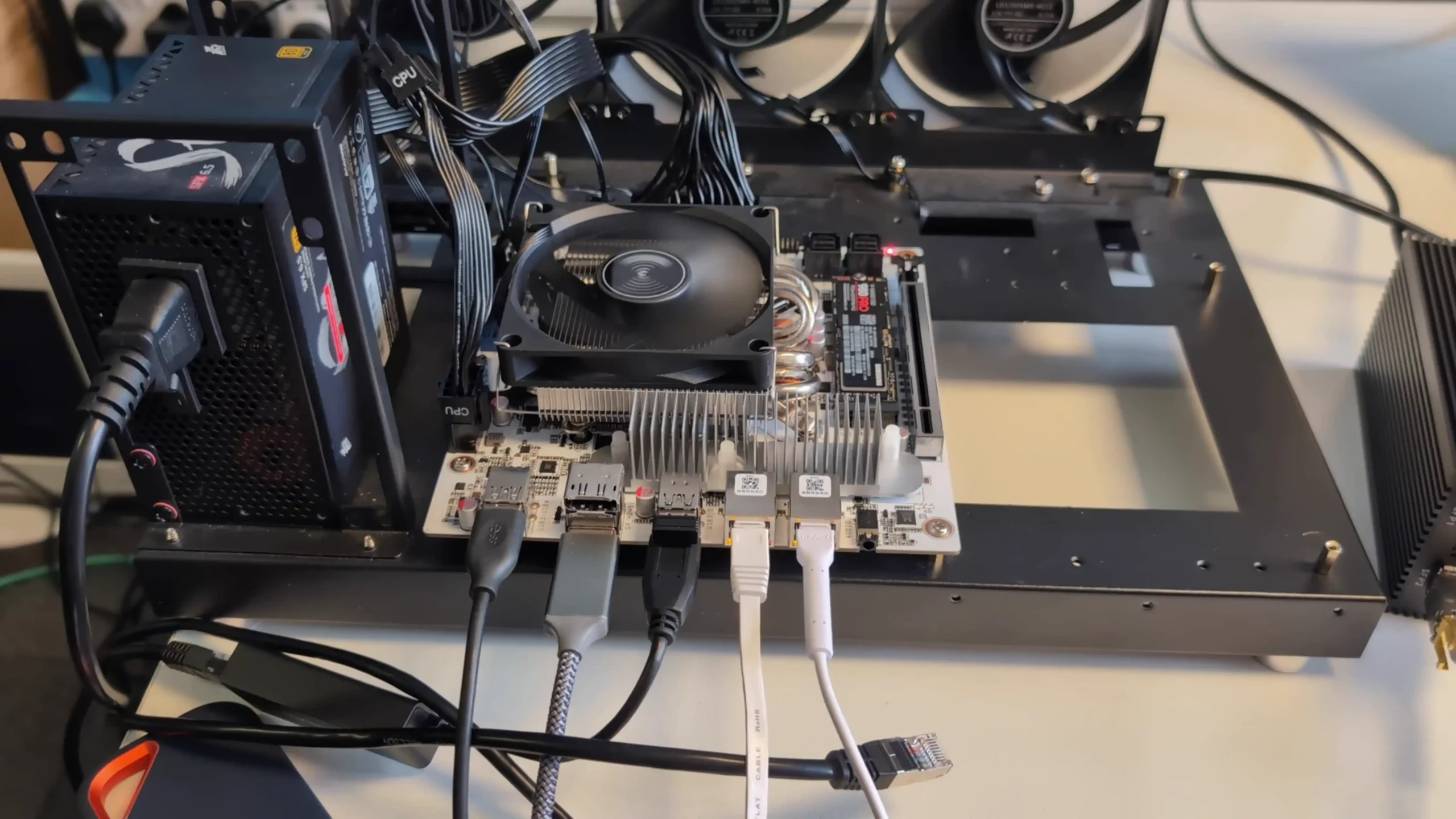
During light workloads—such as file transfers, basic Docker container activity, and periodic system logging—power consumption rose to 35–40W, depending on active network interfaces and connected USB peripherals. Once under sustained load, such as running active VMs, accessing both NVMe drives simultaneously, and saturating both 10GbE ports, power consumption reached 62–64W, and could climb higher when SATA HDDs were connected. With full 8-bay drive setups, users should expect total system draw to increase by an additional 40–80W depending on drive type and workload.
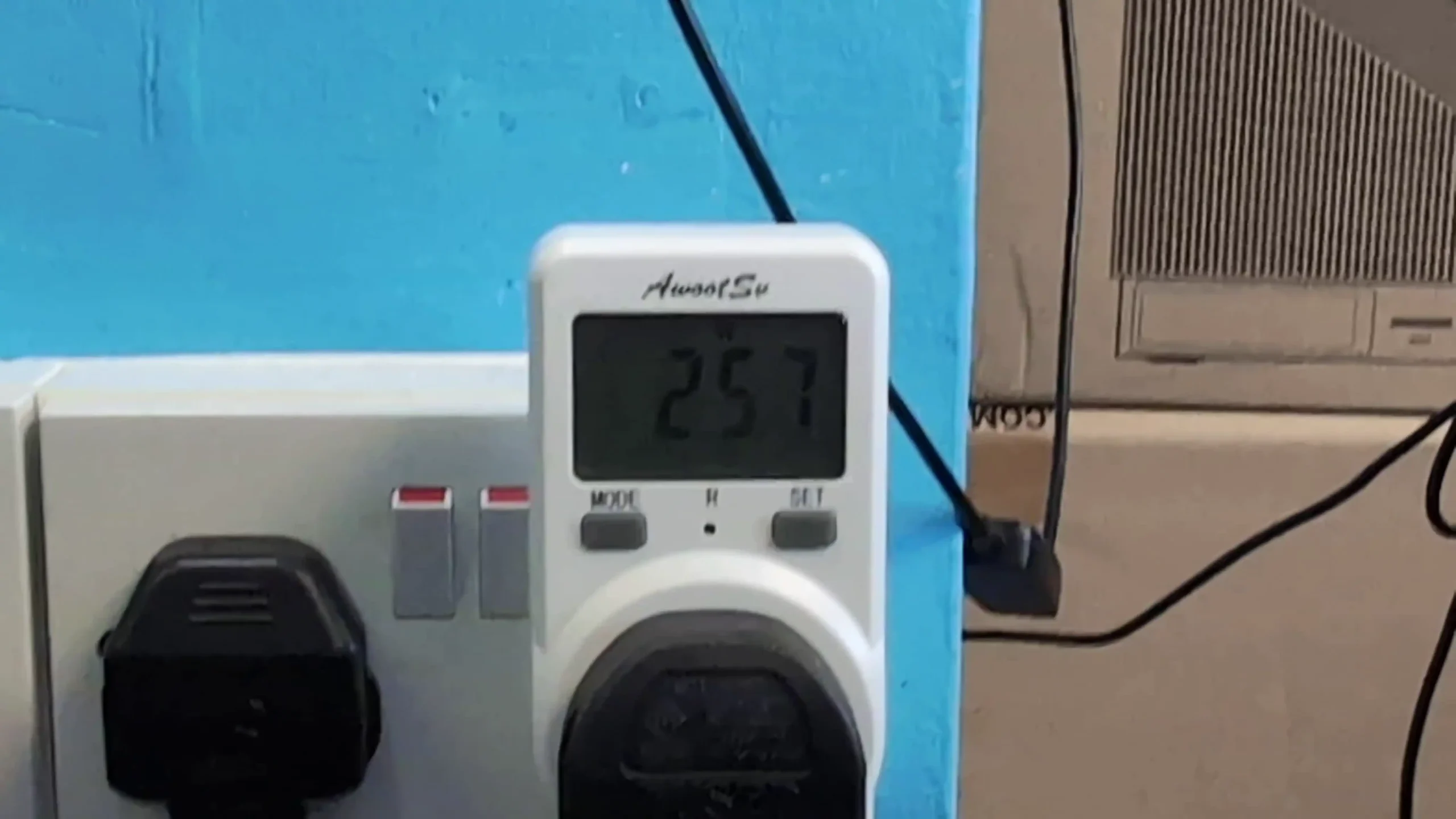 |
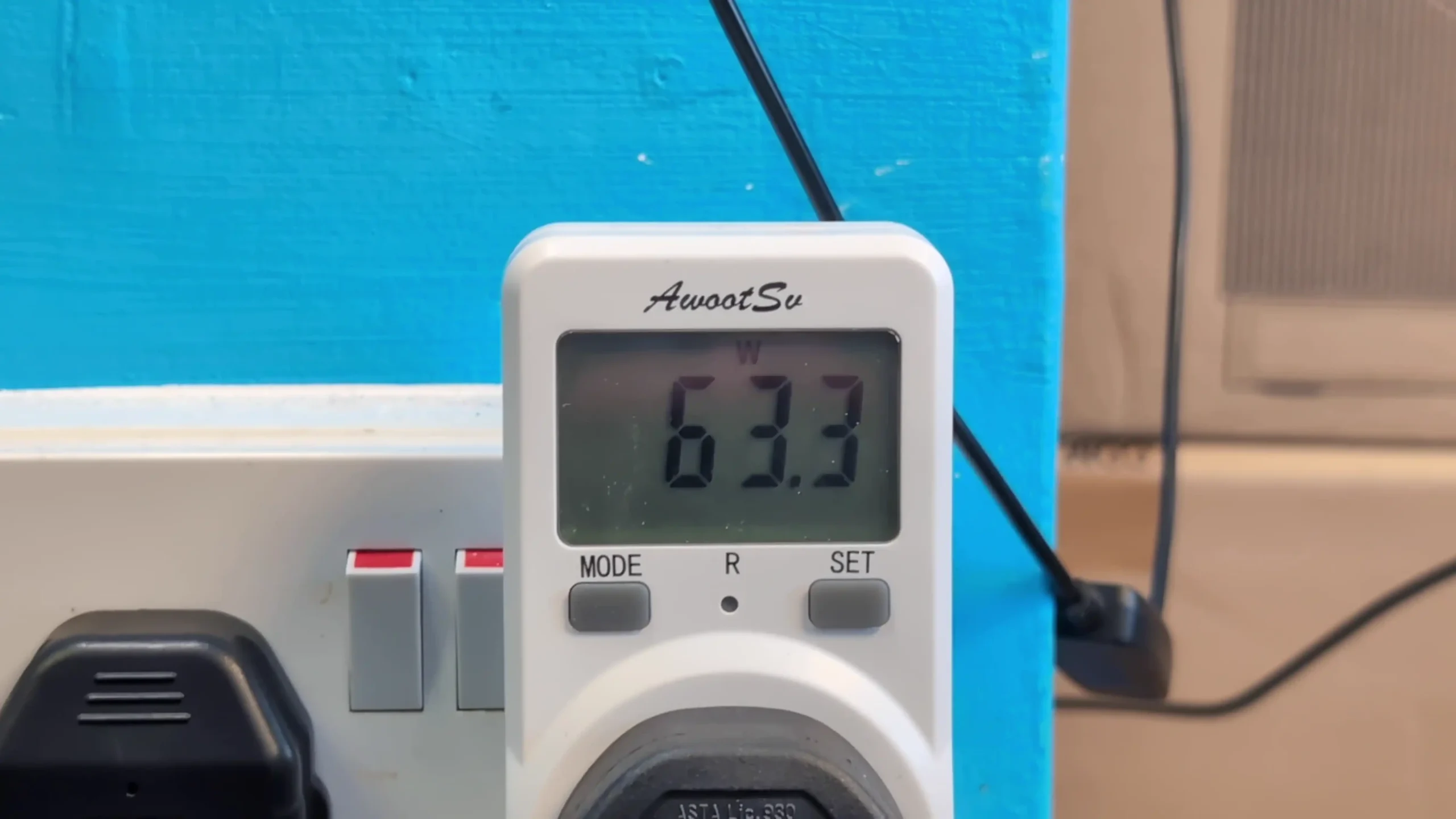 |
Thermal performance remained acceptable, but adequate cooling is essential. The preinstalled copper heatsink provides passive thermal coverage over the SoC, but a dedicated LGA1700-compatible active cooler is required for stable operation. During high CPU utilization tasks (including transcoding and virtualized workloads), the Ryzen 8845HS reached 75–85°C using a standard Jonsbo low-profile air cooler in a ventilated test chassis. NVMe thermals also hovered between 55–65°C under sustained read/write conditions, especially in the rear-mounted slot with limited airflow.
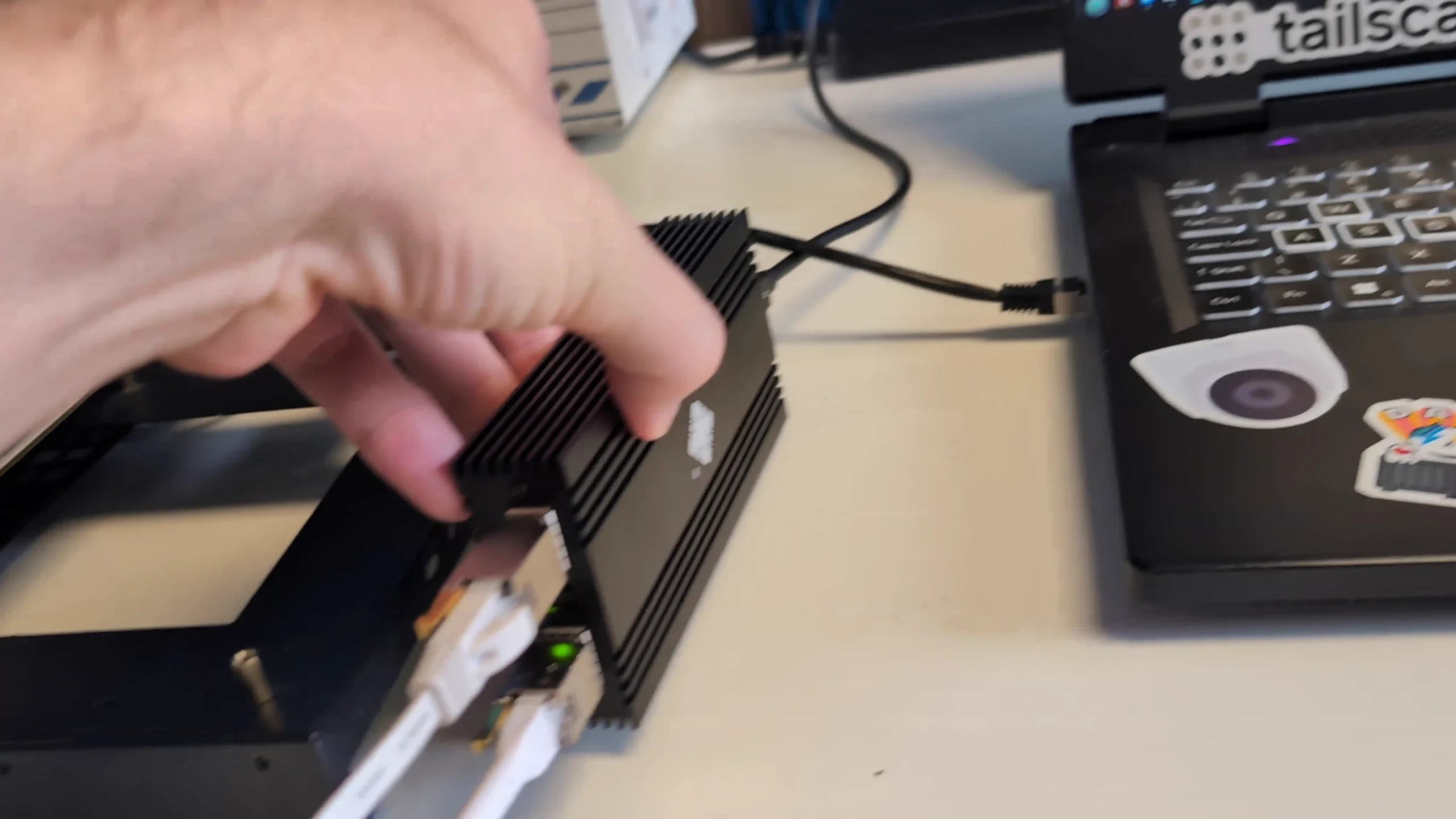
While the chipset and PCIe controllers did not show signs of throttling, compact case designs with poor airflow could reduce long-term reliability unless additional ventilation or targeted airflow is introduced. Thermal probes placed near the SFF-8643 headers showed localized warmth, but no hotspots significant enough to warrant concern, assuming the system is housed in a well-ventilated NAS chassis.
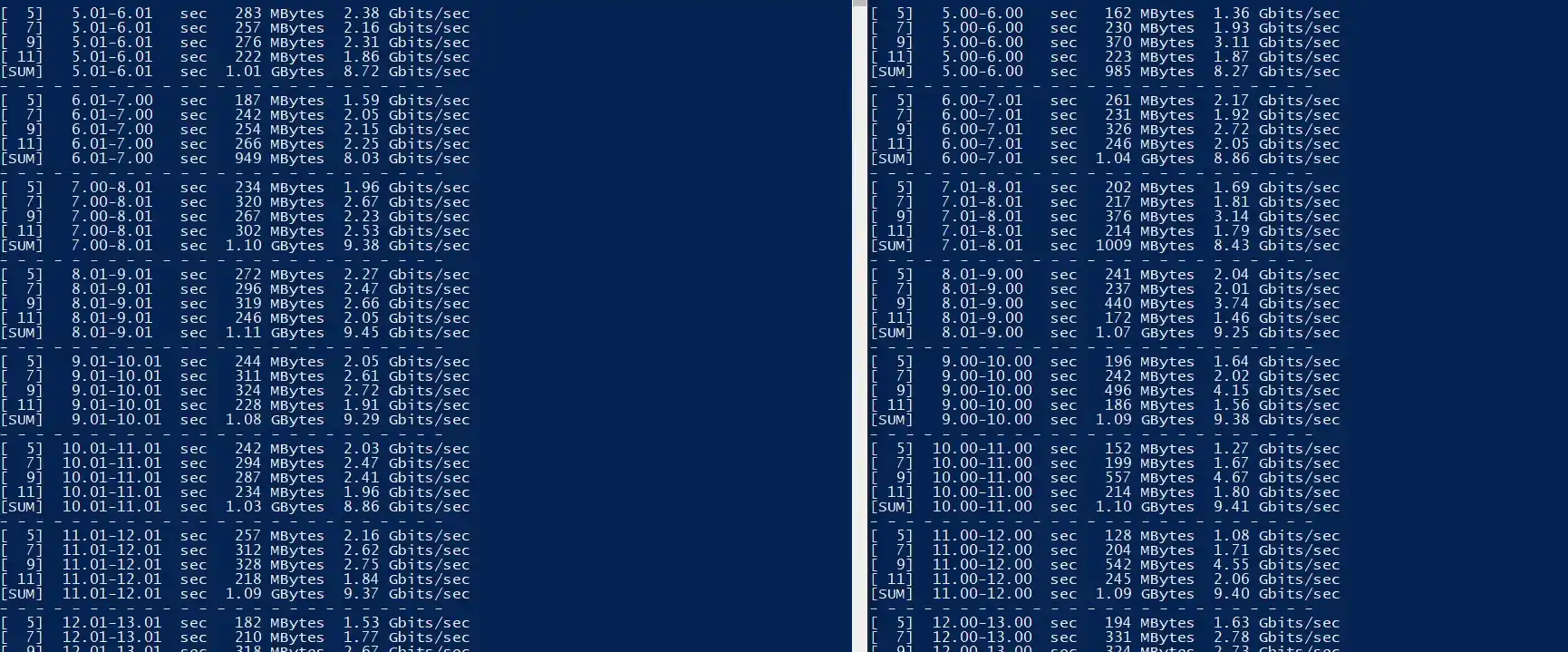
In real-world bandwidth testing, both 10GbE ports were able to sustain near line-rate transfers using iperf3 and large file transfers via Samba and NFS. When paired with two PCIe Gen 4 NVMe SSDs, the system consistently achieved 5.0–5.1GB/s reads and 4.5–4.6GB/s writes under sequential file operations, using CrystalDiskMark and Linux-based fio. When both 10GbE ports were active and transferring simultaneously, total throughput approached 2.8–3.0GB/s across both interfaces, depending on storage configuration and NIC drivers.
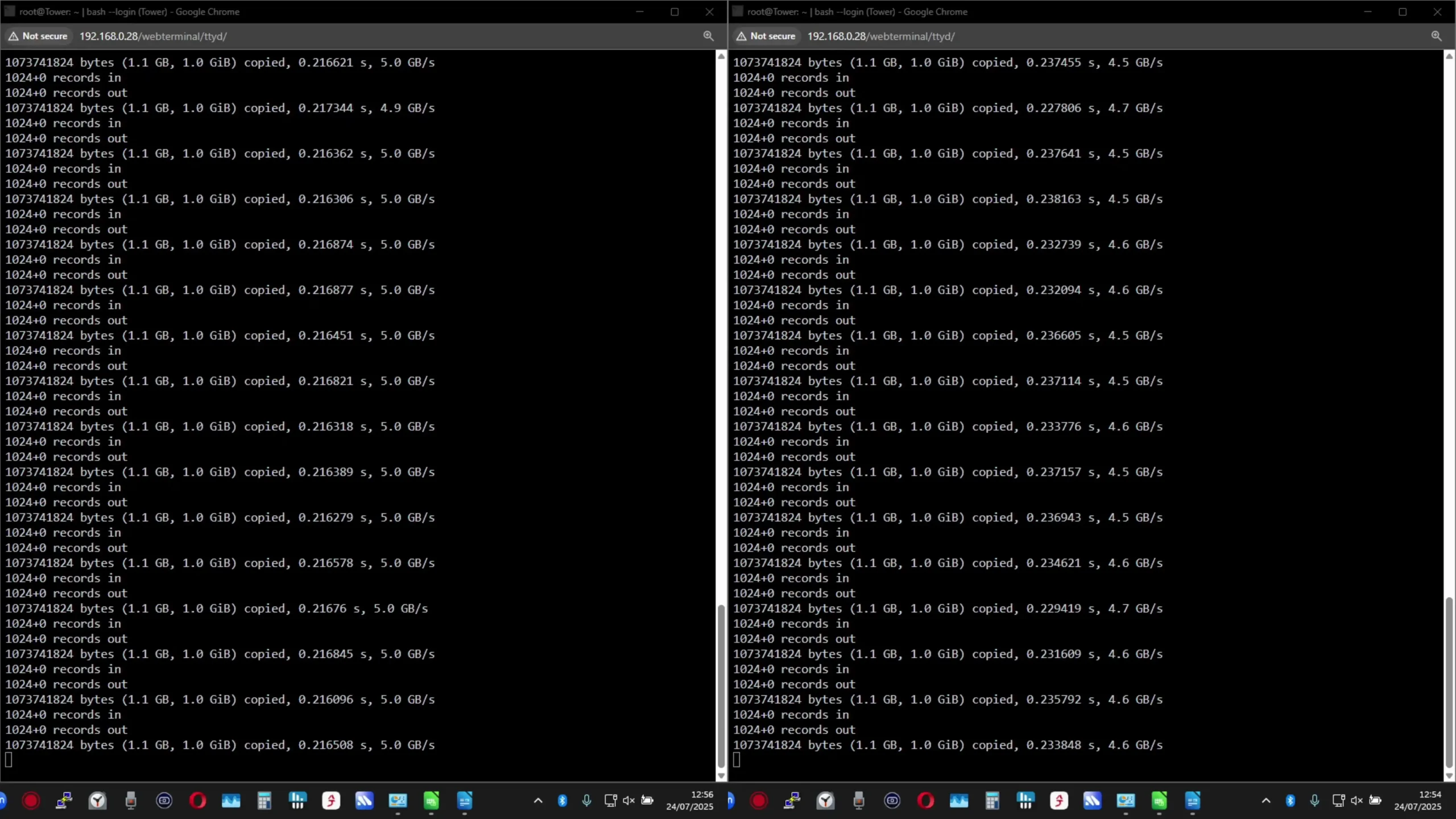
The M.2 slots did not exhibit thermal throttling in short bursts, though write-heavy tasks over time may benefit from passive heatsinks or motherboard padding to manage drive temperatures. Notably, a minor anomaly was observed during direct SSD-to-SSD transfers within the system: despite both NVMe drives supporting Gen 4 x4, inter-drive transfers capped at ~900MB/s, suggesting a potential shared PCIe switch limitation or OS-layer bottleneck. However, this did not impact external transfer speeds or typical NAS operations.
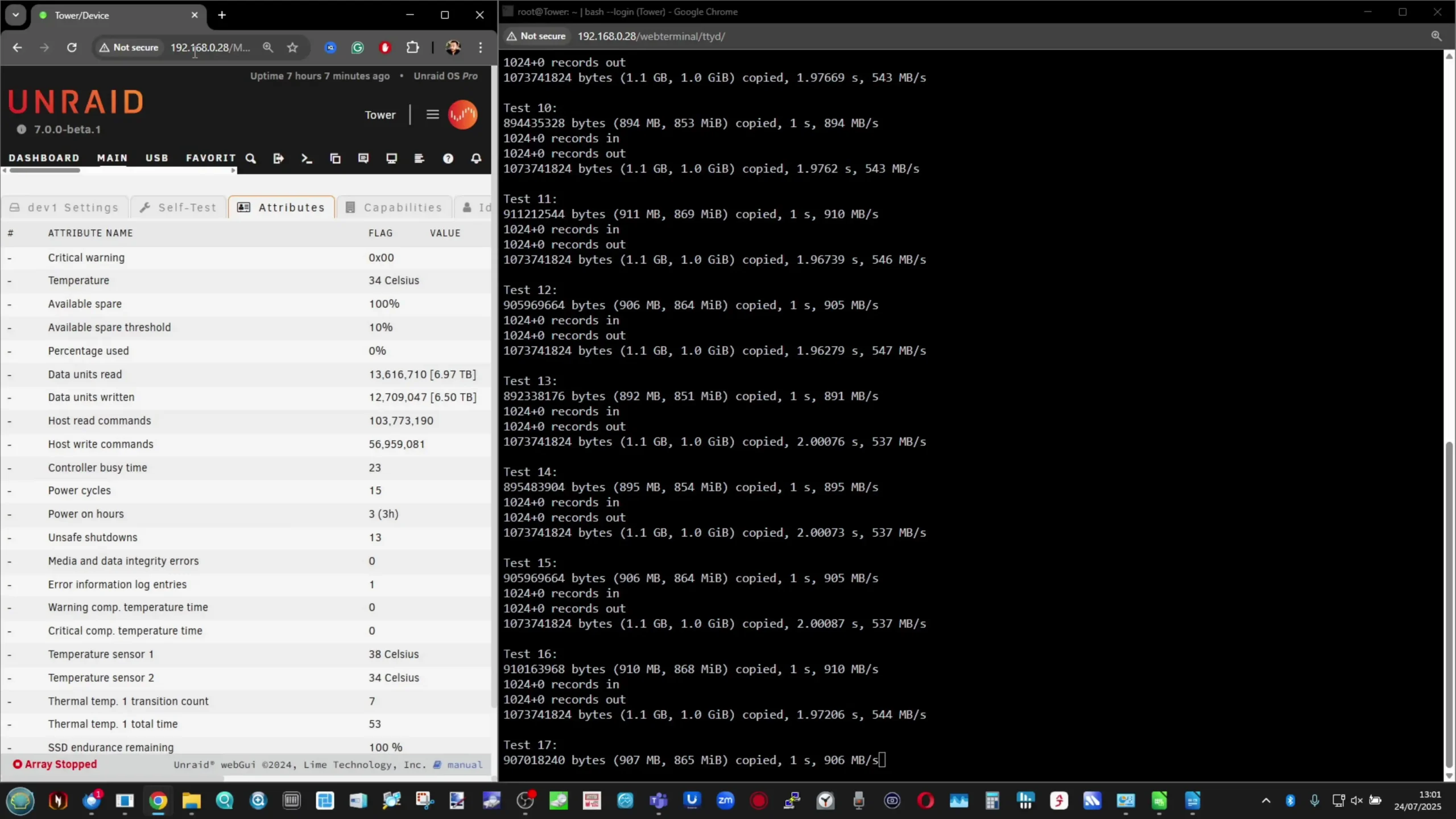
For virtual machines and multimedia, the N7 showed strong capabilities. The Ryzen 8845HS handled 6 mixed windows and ubuntu simultaneous VMs with steady responsiveness and no observable instability in both Proxmox and UnRAID and could very easily have been scaled further, up to double figures with ease. CPU utilization remained below 60% during combined 6xVM and 2x 4K converted Jellyfin media playback testing. The integrated Radeon 780M GPU enabled smooth 1080p and 4K media playback using Jellyfin via hardware-accelerated rendering.
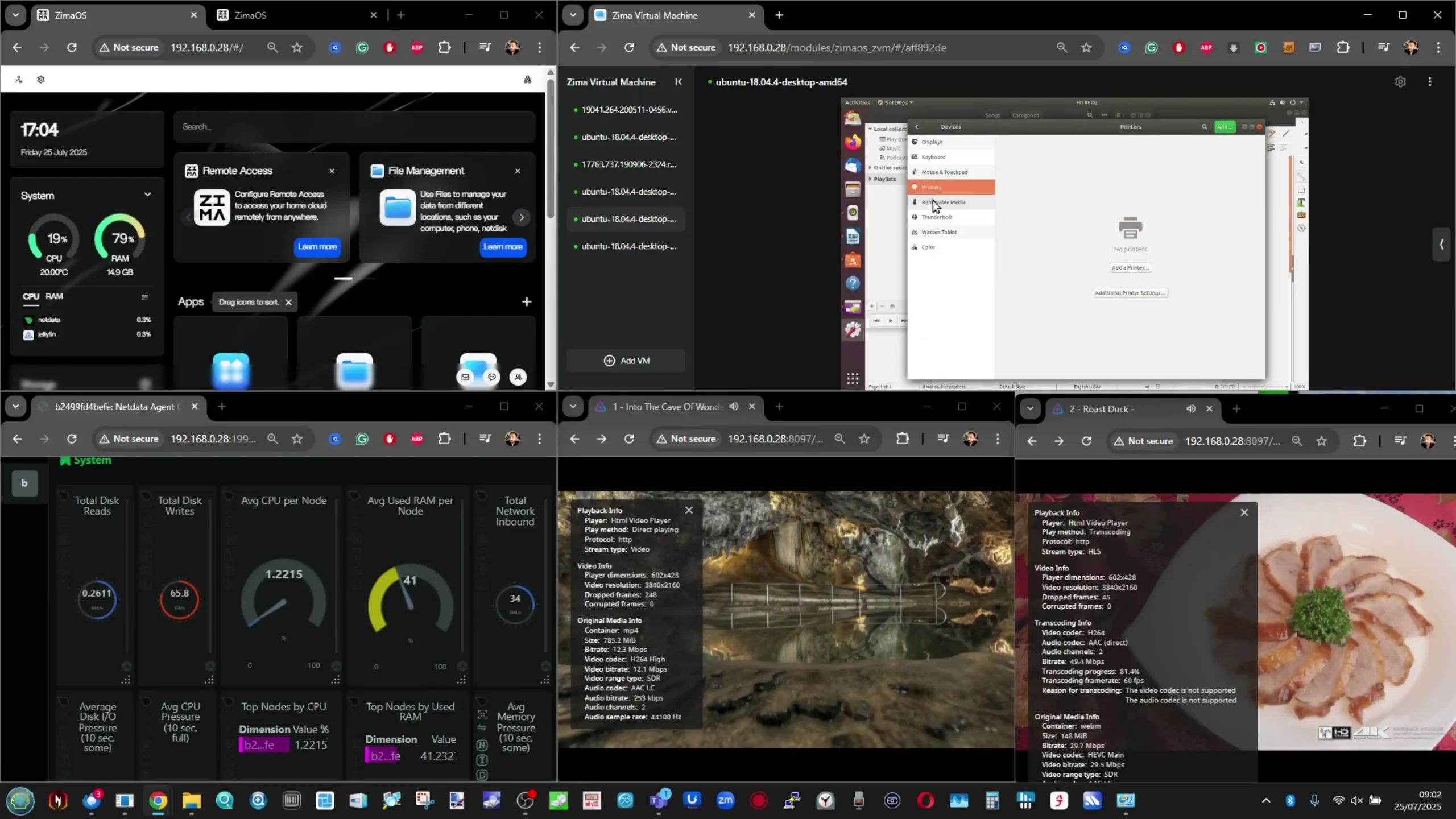
8K native playback was supported, though transcoding large 8K files pushed the CPU above 80% utilization, and real-time conversion proved unreliable. Light 4K transcoding was possible, though not as efficient as Intel Quick Sync or NVIDIA NVENC-based solutions. Still, for native playback and lightweight transcodes in a home or SMB setup, the board performs well. Combined with Docker and AI acceleration for metadata tagging or face recognition, the N7 can act as a capable hybrid NAS/media server platform when deployed with suitable software.
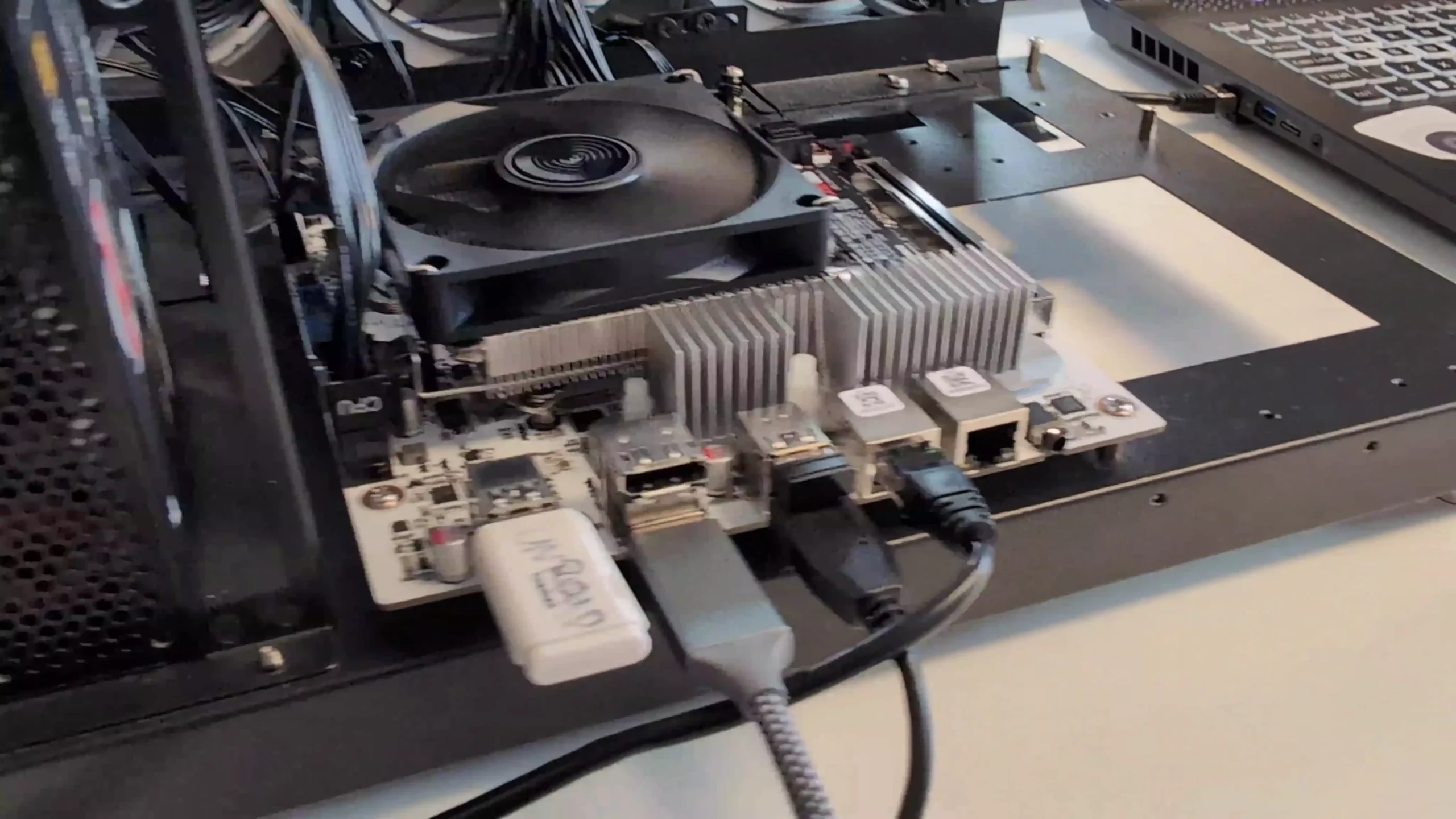
| Metric | Result |
|---|---|
| Idle Power Draw | ~25W (CPU < 5%, 2x NVMe, 1x 10GbE active, no SATA drives) |
| Moderate Workload Power | ~35–40W (light containers, USB, low network I/O) |
| Full Load Power Draw | ~62–64W (2x 10GbE, NVMe access, active VMs, high CPU usage) |
| 10GbE Performance | ~2.8–3.0GB/s aggregate (2x 10GbE fully saturated via SMB/NFS) |
| NVMe Sequential Read/Write | Read: 5.1GB/s, Write: 4.6GB/s (Gen 4 SSDs, CrystalDiskMark/fio) |
| Internal NVMe-to-NVMe Transfer | ~800–900MB/s max observed (possible shared path or kernel bottleneck) |
| Thermal Range (CPU) | 75–85°C under load with air cooler |
| Thermal Range (NVMe) | 55–65°C sustained load (rear slot runs warmer) |
| VM Performance | 5–6 simultaneous VMs stable (UnRAID, Proxmox) |
| Media Playback (Jellyfin) | Smooth 1080p/4K native, limited 8K transcoding |
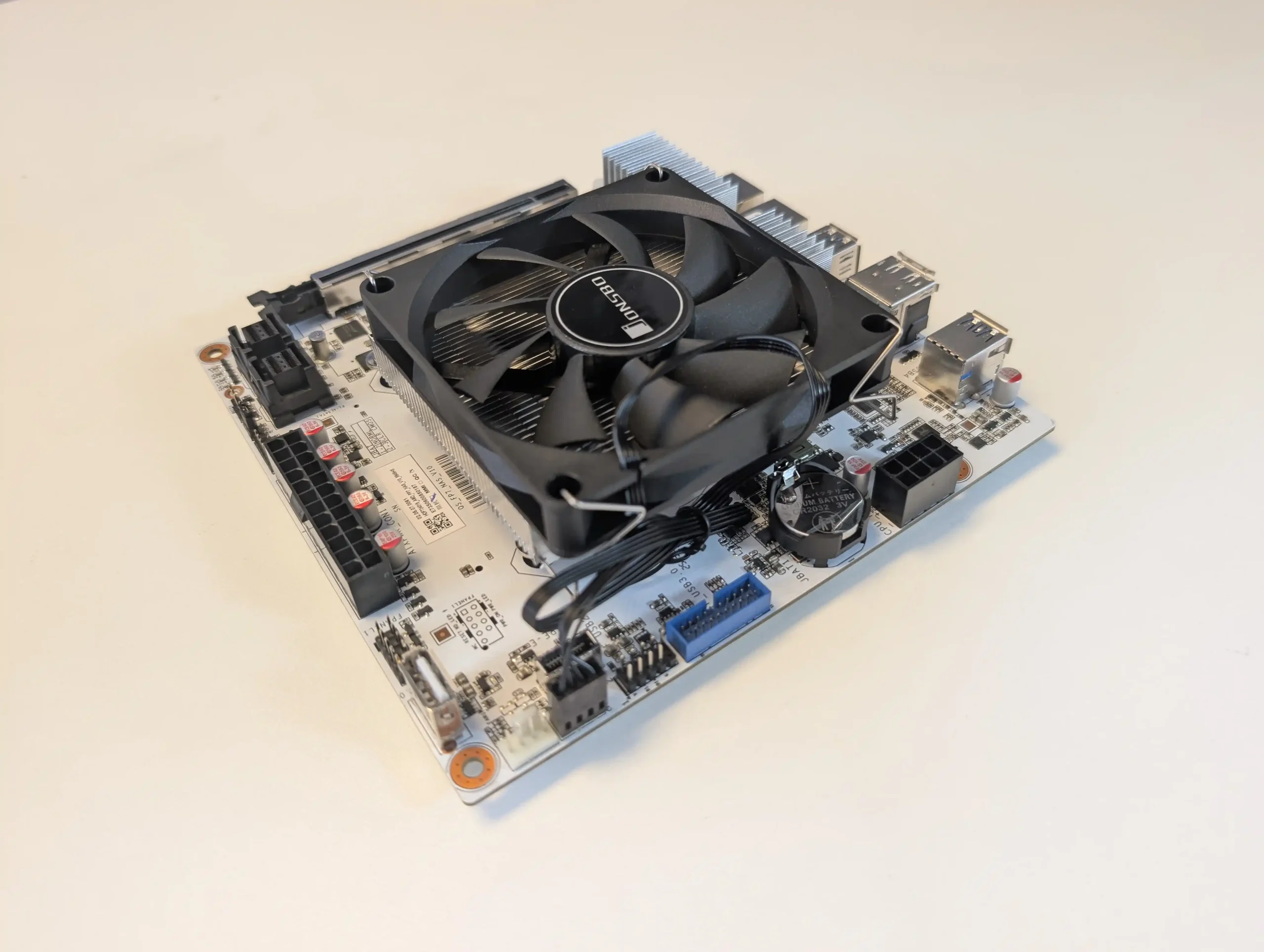
N7 AMD 2x 10GbE NAS Motherboard Review – Verdict and Conclusion
The MINIROUTE N7 (also known as the CWWK N7) establishes itself as one of the most functionally complete and performance-oriented Mini-ITX NAS motherboards currently on the market, delivering a dense hardware feature set typically reserved for much larger or more expensive systems. Featuring the AMD Ryzen 8845HS with Zen 4 architecture, dual 10GbE ports, PCIe Gen 4 expansion, and native support for up to eight SATA drives via onboard SFF-8643, the N7 is aimed squarely at users building serious NAS and virtualization setups from the ground up. The inclusion of dual NVMe slots, USB4 support, and bifurcation-ready PCIe x16 further positions this board as a future-ready platform for mixed storage, networking, and container workloads. Unlike many boards in this category, which sacrifice PCIe allocation or require additional HBAs for full drive connectivity, the N7 manages to deliver everything natively within a compact 17 cm × 17 cm layout. Compatibility with UnRAID, Proxmox, TrueNAS SCALE, and ZimaOS means that users have a wide selection of operating environments to choose from, whether prioritizing containerized applications, VM infrastructure, or ZFS-based data integrity.
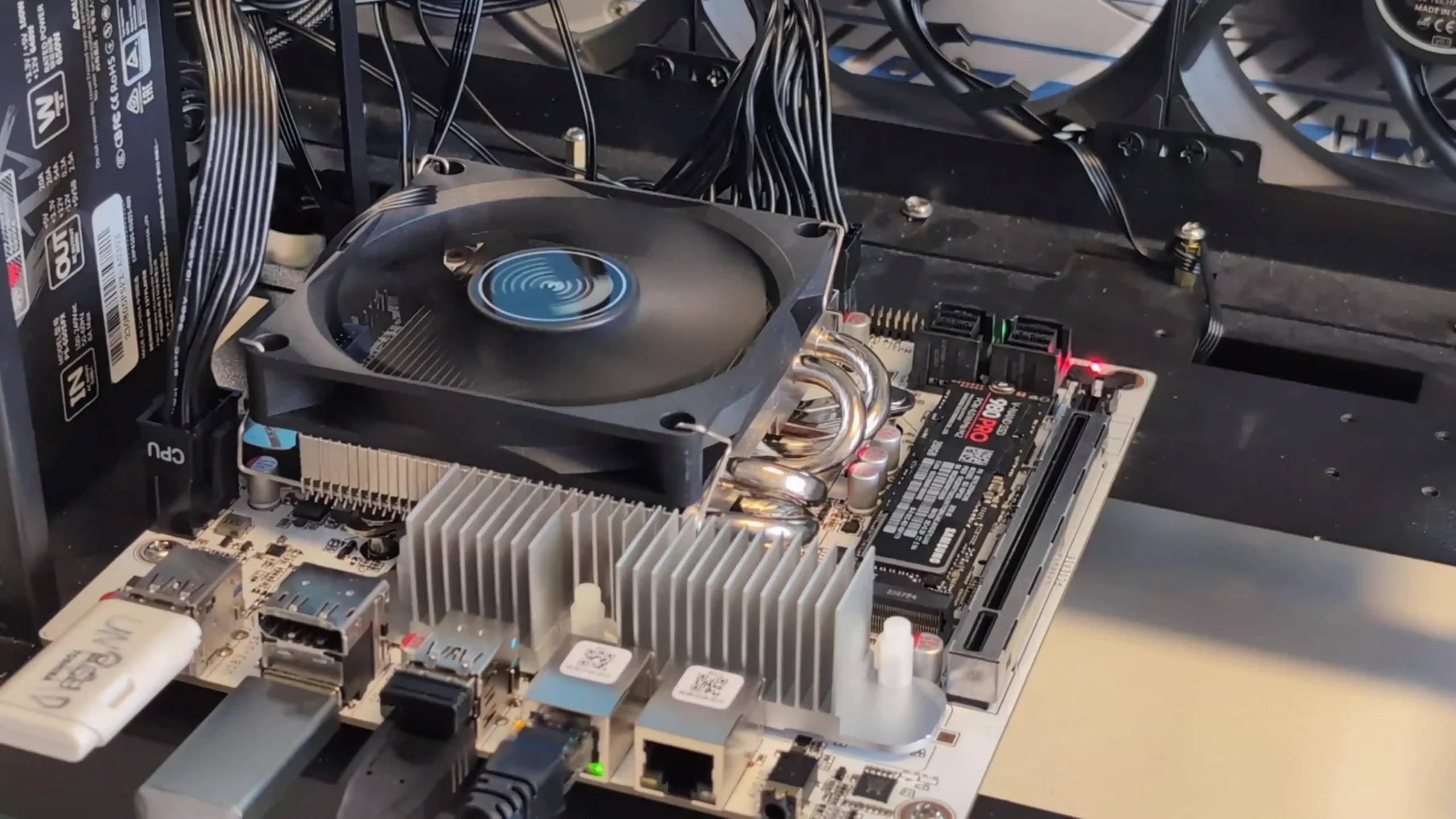
However, the board’s capability comes with caveats that will be more apparent to experienced system builders. Idle and load power consumption are significantly higher than N-series Intel or ARM SoCs, which may not suit deployments aiming for low-energy, 24/7 operation with minimal thermal output. Thermal demands on the CPU and M.2 storage require effective active cooling, particularly in enclosed NAS cases with limited airflow. Officially, there is no ECC memory support, and although the board recognizes ECC DIMMs in BIOS and some operating systems, the absence of validated error correction will deter users in environments where data integrity is mission-critical. Additionally, while the SFF-8643 layout enables clean cabling for up to eight SATA drives, it assumes familiarity with breakout cables or SAS-style enclosures—potentially adding complexity for users migrating from consumer-oriented boards with standard SATA headers. That said, for advanced NAS builders, home lab enthusiasts, or small-scale professionals seeking a board that combines workstation-grade power, native 10GbE networking, and dense storage connectivity, the N7 represents a well-balanced and highly flexible foundation. Its price may be higher than entry-level ITX boards, but for those seeking high-throughput and virtualized workflows in a compact format, it is one of the most capable DIY platforms currently available.
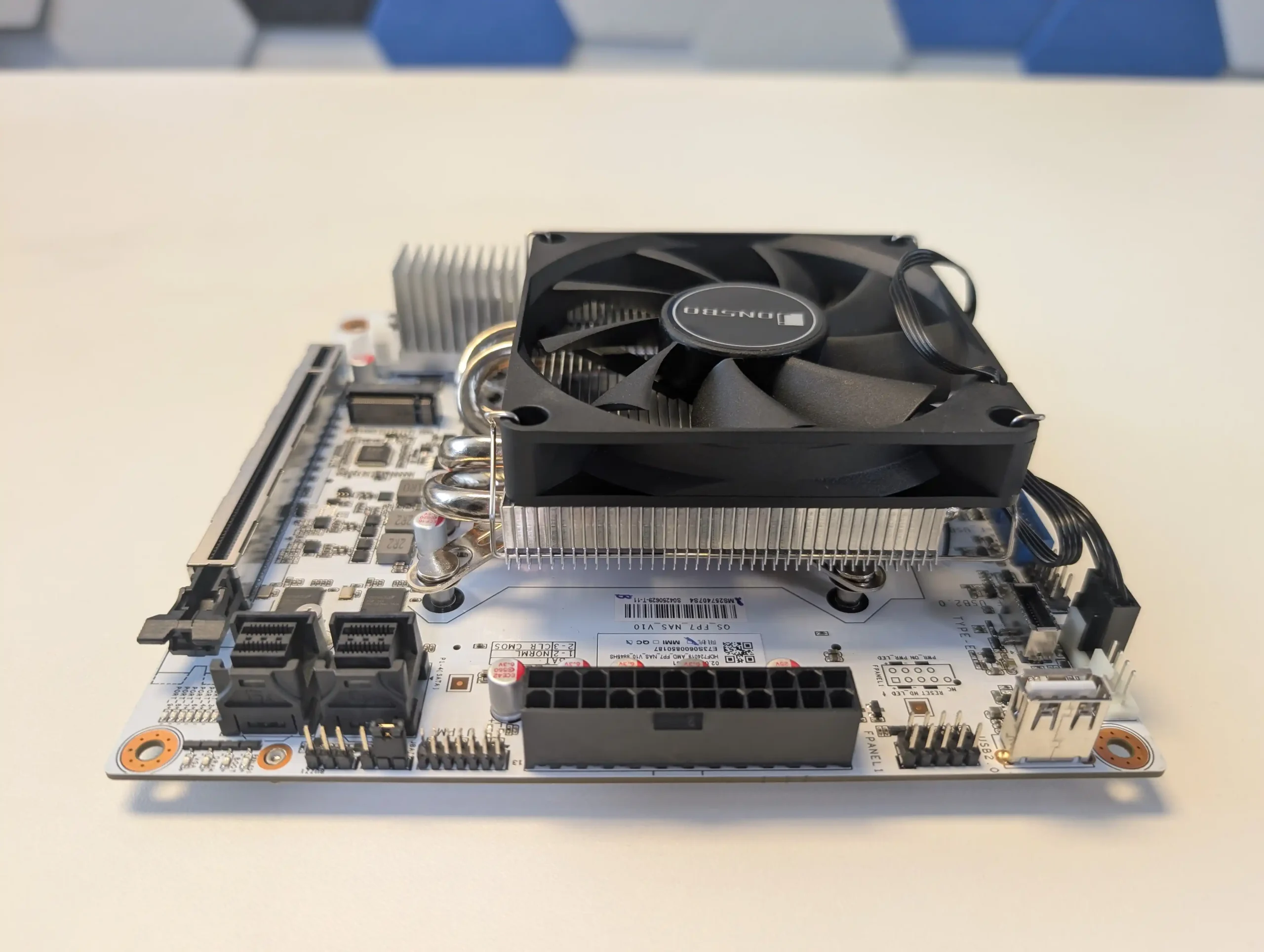
| Where to Buy? |
| PROs of the N7 NAS Motherboard | CONs of the N7 NAS Motherboard |
|
|
📧 SUBSCRIBE TO OUR NEWSLETTER 🔔
🔒 Join Inner Circle
Get an alert every time something gets added to this specific article!
This description contains links to Amazon. These links will take you to some of the products mentioned in today's content. As an Amazon Associate, I earn from qualifying purchases. Visit the NASCompares Deal Finder to find the best place to buy this device in your region, based on Service, Support and Reputation - Just Search for your NAS Drive in the Box Below
Need Advice on Data Storage from an Expert?
Finally, for free advice about your setup, just leave a message in the comments below here at NASCompares.com and we will get back to you. Need Help?
Where possible (and where appropriate) please provide as much information about your requirements, as then I can arrange the best answer and solution to your needs. Do not worry about your e-mail address being required, it will NOT be used in a mailing list and will NOT be used in any way other than to respond to your enquiry.
Need Help?
Where possible (and where appropriate) please provide as much information about your requirements, as then I can arrange the best answer and solution to your needs. Do not worry about your e-mail address being required, it will NOT be used in a mailing list and will NOT be used in any way other than to respond to your enquiry.

|
 |
Top 5 PLEX/Jellyfin NAS of 2025
Seagate Ironwolf vs WD Red NAS Hard Drives
The BEST NAS of 2025
Terramaster TOS 7 Preview - Next Gen NAS Ready?
What is QNAP Planning for 2026? Round Up of the QNAP 2025/2026 Event in London
2x 10GbE to USB4 Adapter - DO YOU NEED THIS?
Access content via Patreon or KO-FI
Discover more from NAS Compares
Subscribe to get the latest posts sent to your email.


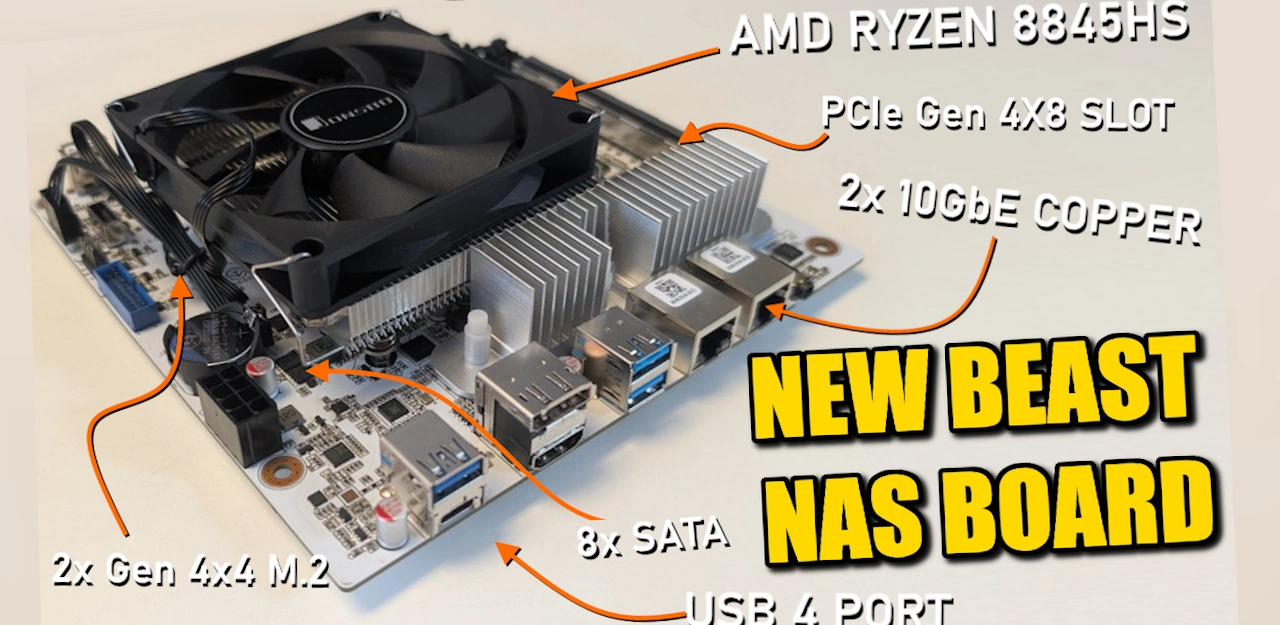
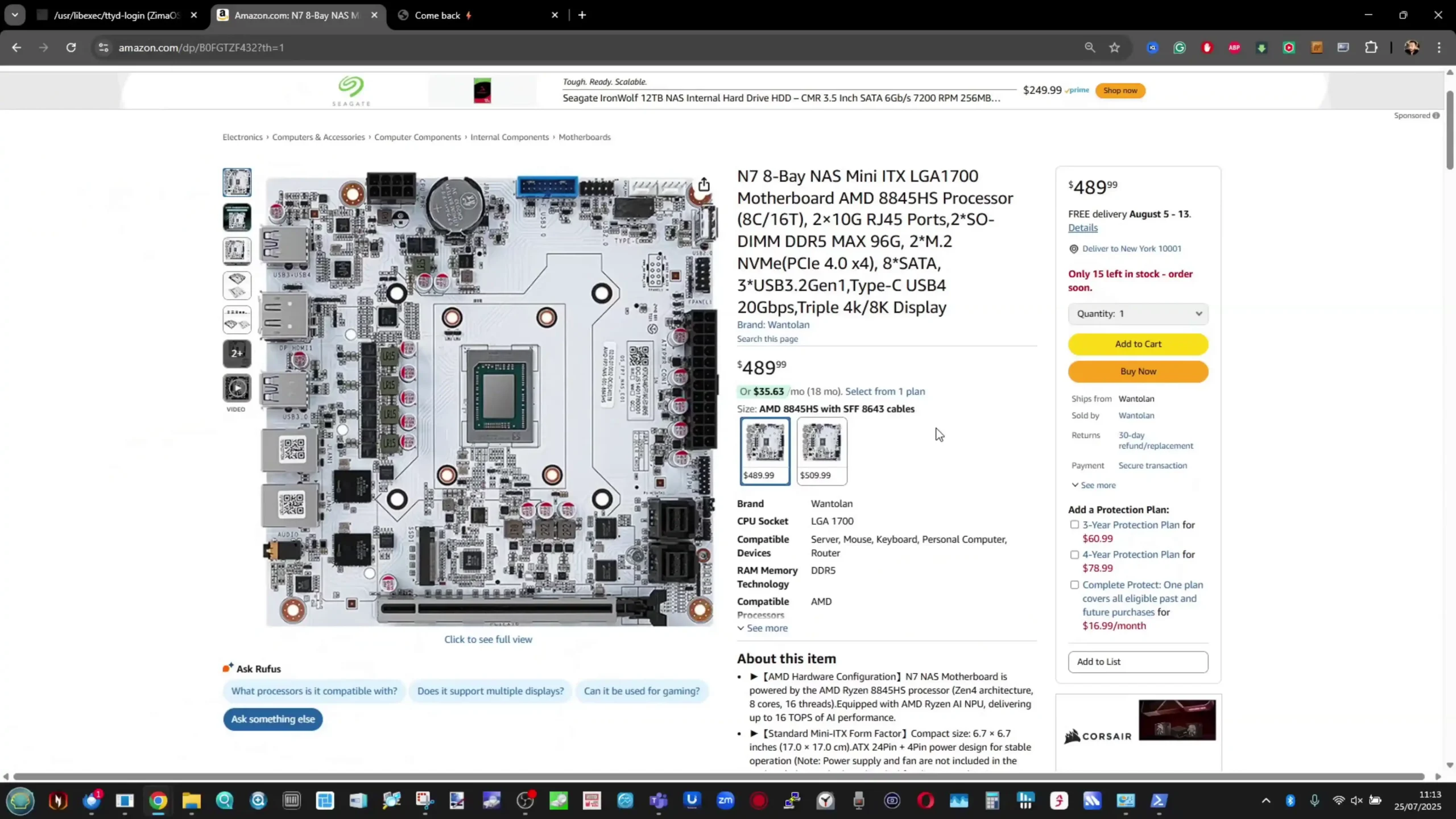



Super micro mini itx motherboards have 2x10G up to 256 ECC RAM and would consume 40-70W on highest load, so why should someone go for this china motherboard?
REPLY ON YOUTUBE
Run the CPU underclocked to the clock speed sweet spot, then run curve optimizer undervolted and it should be good but just remember then 7 watt CPUs are not very powerful,
REPLY ON YOUTUBE
???????????? lovely script keep up the good work
REPLY ON YOUTUBE
*IMPORTANT UPDATE* The Minirouter N7 Motherboard in this video NOW OFFICIALLY SUPPORTS ECC!!
REPLY ON YOUTUBE
Great video
REPLY ON YOUTUBE
I still have no regrets backing my 5-bay and 8-bay UGreen NAS’es during its Kickstarter campaign. I got them both at super early bird pricing too! I run them along with my other Synology NAS’es but I actually like my UGreen ones more now as they have improved their OS a lot. For starters, it’s much easier to set up NGINX proxy manager via docker on my UGreen NAS’es than my Synology ones. They’re a lot more powerful too! ????
REPLY ON YOUTUBE
Yes. I just bought all the components for a TrueNAS system.
REPLY ON YOUTUBE
I’m adult in my mid 50’s Swearing doesn’t bother me at all. Gen X.
REPLY ON YOUTUBE
ugreen language translation is not quite there. 02 05 03 01
REPLY ON YOUTUBE
I went down the DIY route, mainly because I really like playing with PC hardware and building stuff. I went a bit over the top, but the performance is amazing for a home setup. Using Proxmox, with OpenWRT(It’s my router) and TrueNAS as VMs. Mixture of second hand, new and hardware I already had.
AMD Epyc 7k62 48 core
256GB ECC DDR4 3200mt/s (192GB given to TrueNAS)
Asrock Rome D8-2T
2 x 512GB Intel/Adata boot drive
4 x Samsung 970 Pro 1TB (1TB usable, mirrored 3 times as it’s the NAS meta data drive)
12 x Seagate 16TB HDDs (4 x 3 VDEVs)
4 x 10GBe Intel X550 (Star topology for the house)
2 x 2.5GBe Intel I216V (For the broadband)
EVGA 1600w T2 PSU
Phanteks Enthoo Pro 2 Full Tower
Not only is this fast for a NAS, I get 10GB ethernet around my house. It’s not uncommon for me to get 900~1000GB/s over the 10GB network and in Linux VMs doing “local” NAS access I’ve seen sustained read and write speeds up to 1.5GB/s from the mechanical drives.
REPLY ON YOUTUBE
I’ll subscribe if you review the CWWK board with the Core i5 12450H processor. I am looking for a build around the Jonsbo N2 most likely
REPLY ON YOUTUBE
curse more, fuck everyone who gets offended by words.
REPLY ON YOUTUBE
Given the case that I have for my video editing rig I can have 7 3.5″ HDD. With each HDD now having 30tb storage that would equate to over 200tb just for hard drives. I can also have 4 5tb 2.5″ HDD and with a combination of motherboard and 2 add on cards each having 4 M.2 slots that adds up to 10 M.2 with a capacity of 8tb each that adds up to a total of over 300tb storage. From Ethen.
REPLY ON YOUTUBE
Was thinking of DIY but then after reviewing some decided, nope, don’t have time and patience. Thinking of upgrading my current Synology DS418 (before that also had Synology) of switching to UGreen DXP4800 which has strong hardware but middle ground OS/software or the Synology DS425 which has mediocre hardware but strong OS/software. I am more inclined to ease of setup and use across my android mobiles, windows pc and linux notebook, which Synology provides, but then also was wanting strong hardware. Security also matters, especially where AI is local and doesn’t go to internet for its’ computation. Confused.
P.S. Xpenology on DXP4800! Viable?
REPLY ON YOUTUBE
One look at the price for Synology hardware and disk expansion cases, and I went DIY.
REPLY ON YOUTUBE
I have 3 nas. Ugreen 4800 plus, unraid with 10 disks, truenas with 6 ssd. Ugreen is the easiest to use, next unraid, and truenas is the worst in the user interface.
REPLY ON YOUTUBE
4:05 I’m not sure what you mean by the word “intensive” here. It _seems_ that you wanted to imply that CLIs are more complicated and difficult to use, but I think that is disingenuous and misleading.
Command line interfaces should be considered a selling point for novices as well as experienced users since they are invariably more stable than GUIs and much easier to document.
GUIs are better suited to displaying results than as a configuration interface.
REPLY ON YOUTUBE
Team TrueNAS. Got two self-planned and built nodes, with offsite replication and all the bells and whistles. Went full ham on a Supermicro server board with IPMI and AMD EPYC platform for the main NAS. Oh yeah, and cheap 25G fiber aswell.
REPLY ON YOUTUBE
Still cheaper to buy an old pc, add storage and use it as NAS. These pre built systems are very low power and very expensive.
REPLY ON YOUTUBE
Could you do a video on a server for £500?
REPLY ON YOUTUBE
BIOS V1.1 is ready for download – I have a Topton MB and flashed the CWWK-BIOS (1.1) ????
Build Time: 02.08.2025
REPLY ON YOUTUBE
I don’t support Synology and their recent decisions but for someone still looking to buy their first NAS, their software is unrivalled. The dropped drive support is a problem for users that have drives they want to migrate over. Taking away transcoding is just dumb though.
REPLY ON YOUTUBE
I am still running a 12 year old synology 5 bay nas, it’s been running 24/7 for almost the whole time (a few days off here and there when moving house, power cuts, or renovations). It’s got WD physical HDDs in it. The only things I’ve had to do is replace a couple of fans that have got noisy and replace one of the HDDs that failed. The hardware is no longer supported so there has been no software updates for years now. But it just keeps going so I don’t want to spend loads of money replacing something that still does the job I need it to 12 years later. As much as the geek in me would love to build a new nas I can’t justify doing it until the old one breaks ????
REPLY ON YOUTUBE
I am running my own “NAS/Server” for 10+ years… last year Ive switched to Unraid… fk Synology…
REPLY ON YOUTUBE
how is HEXOS now.. IT has been a year since it was reviewed… Anyone has any thoughts here… Time to jump synology..
also has anyone thought about going apple mini and then use it as a NAS? Lot of videos out there for that
REPLY ON YOUTUBE
looking at this video I just can’t help to be distracted by the ugly fingerprint catching shiny mid-2000s-design cheap plastic on the QNAP.
REPLY ON YOUTUBE
I need a stable phone sync app that doesn’t break when syncing a multiple GB sized video or some weird codec. Even QNAP fails there, seems only Synology works. It’s ridiculous really considering phone backup is so important since years.
REPLY ON YOUTUBE
I went DIY simply because it was cheaper. But It seems like I made the right decision with some of the other locked down things. But now that I have my own, I kinda want the other option as a backup of my backup. Some of those have easier sync options. I wont ever leave the DIY option cause I like the freedom.
REPLY ON YOUTUBE
Has the bios options for AMD-Vi/iommu?
REPLY ON YOUTUBE
My old Dell PowerVault uses closer to 800W, so the power draw on this thing is minuscule.
REPLY ON YOUTUBE
I bought a CWWK AMD 8845HS motherboard, slapped on a Noctua tower cooler, 32GB RAM, 2x 512GB NVME for a cache pool and just recently dropped in a 20TB Toshiba N300 drive. On this system I run unRAID, within that OS I have multiple VMs and Containers, including a Sophos Firewall VM and a Unifi Network Controller. Basically I have a full home lab all contained within a Fractal Node 304 case. Power draw is a reasonable (80W including my Virgin Media router, a POE switch and a Unifi AP), sound level is low enough that it doesn’t upset the wife, and more importantly it has more than enough processing power to run my full home lab without breaking a sweat. Plex transcoding is handled by the AMD integrated GPU, but I don’t need any transcoding since this is a Direct Play household!
Overall I am grateful to Synology for no longer supporting 3rd party brands because that was the reason I chose not to go for a Synology NAS, and I was only looking at Synology because of SHR. Once that was no longer an option DIY was my only option.
REPLY ON YOUTUBE
I want affordable DIY cases, specifically Mini ITX or MATX. Why are these so hard to find at reasonable prices?
REPLY ON YOUTUBE
I’m really happy with my Aoostar R1 N150 running ZimaOS. I just had to replace the bottom fan with a Noctua one and put it on felt pads to make it much quieter.
REPLY ON YOUTUBE
I’m thinking about getting one of these N7 AMD 8845HS, or a CWWK W680 NAS with an Intel 14900K to act as a my home server (I currently have an old MATX A320 Asrock with an Athlon 3000G, typically about 50 watts). I’m pretty sure you reviewed the Intel board, but what being as 25watts for the N7 AMD 8845HS is pretty high, how would the W680 NAS – 14900K fare?
REPLY ON YOUTUBE
Power efficiency is always my thing. I did pick up and old PC with a 6700 but its too heavy on thr wattage, assuming i do leave it on 24 7. I do own a mini PC which is great and pulls max maybe 10ish watts at the wall, usually 7w as it’s idle. I’d definitely go prebuilt, but I’d have to buy something that’s power efficient.
REPLY ON YOUTUBE
I’m still looking for a feature rich, AND easy to deploy and configure, AND cheap or open source NVR. It’s the one thing keeping me from scrapping my Synology.
REPLY ON YOUTUBE
Camp BYO:
Being a Windows/Unix/Linux server admin for the last 30 years, I built my own which is smaller and more powerful than the commercial offerings. First with FreeNAS/TrueNAS, then later with Proxmox and a DIY Linux LXC for NAS duties plus a whole bunch of other LXCs and VMs.
REPLY ON YOUTUBE
My NAS is jast a headless Debian server, because I like pain I guess 😀
Actually it’s because I just liked the idea of learning to manage a “proper” server. I started with Ubuntu Server and made a bit of a mess because I didn’t really know what I was doing, but second time around with Debian it really was a breeze. Now it’s a pretty clean setup with lvm, ZFS, a bunch of smb stuff as well as Plex and Jellyfin (testing before I’m confident enough to drop Plex), both with hardware acceleration for transcoding and tone mapping. Sometimes I even run some game servers.
All in all, very educational, but certainly has quite some learning curve. It also puts you in the danger zone for getting into homelab, now I’m playing around with Proxmox and OPNSense…
REPLY ON YOUTUBE
the only reason i may go for prebuild nas , is the ability to use it from outside my network over the internet , i will use dropbox , since the diy route is to complicate i have try next cloud , don t manage to make it work even truenas dose not support it , don t see any other benifits compar to a simple compute use as nas .
REPLY ON YOUTUBE
Absolutely the time for billionaire’s gold Casio
REPLY ON YOUTUBE
I’ve just built a Nas, which involved rebuilding my old PC back into its old case, and the fun of designing and printing my own harddrive rack with side loading bays. So for the cost of harddrives only (and a bit of 3d printing) I got a Nas that allows me to figure out what I need and how I’m going to use it, and to completey change my mind all I need to do is print something else. Truenas has been easy to set up and use, almost too boring really, I thought it was going to be more of a hobby but I don’t have to do anything ????
REPLY ON YOUTUBE
I’m still using my 10yo QNAP Ts-853 Pro, with added 5G network card. For HDD based NAS (which gives you shitload of storage for pennies) you don’t need anything else.
REPLY ON YOUTUBE
This is exactly what I did. Ditched Synology, bought an Intel NUC with Thunderbolt 3 external drive enclosure. Installed Linux with ZFS, NFS, Samba, JellyFin, etc. So much better than fighting with the restrictive options of Synology.
REPLY ON YOUTUBE
Easy options for someone like myself…… internal network use only… I would (now) choose the DIY route. Internal and external use the now traditional NAS solution would be best. I only use my NAS for internal network streaming, I wish I knew this b4 buying a QNAP solution..DOH ????????
REPLY ON YOUTUBE
I am looking for a nas with N355 and at least 32 giga ram. with low consumption. and 6 bay. i want also to have something safe reagrding data. then not ugreen
REPLY ON YOUTUBE
DIY is always the superior option. If you can do it, you should do it.
REPLY ON YOUTUBE
I really don’t understand “nas OS” as Linux or even windows make good nas and have far more apps.
Truenas is nice way to ease into ZFS, but btrfs keeps getting really good.
REPLY ON YOUTUBE
ditched prebuilt a few years ago now.. I’m never going back.. I was planning to move to synology but that idea died when they moved to amd cpu’s without video codecs in them…and I’m glad I escaped before the whole HD lock-in mess
REPLY ON YOUTUBE
Long time fan, first time commenter!
I’m making the move from my DS923+ (it’s been an absolute kubernetes nfs pvc permissions nightmare) to DIY. I know this isn’t discussed much on the channel, but any suggestions on a DIY setup that works well within a homelab/kubernetes setup? I’m moving my cluster to Talos this weekend and want to plan out the storage swap in the near future. Thanks for an suggestions!
REPLY ON YOUTUBE
I’m still enjoying my 1618+ but i feel that after this unit is unsupported, and in light of Synology’s recent ‘business practices’, I will investigate ‘roll your own’ options, as it were. ????
REPLY ON YOUTUBE
Thanks. I am concerned about reliability. My Lincplus N2 had issues losing some ssds, my Minisforum MS-01 is dead for seemingly no reason. All the while my 2 Synologies are chugging along, one of them for 10 years.
REPLY ON YOUTUBE
I used to think Synology for turnkey… but they don’t care about home/small users anymore, removing apps, codecs etc. (and of course their rip off for memory and the mess with disk compatibility). More and more I’m setting up open source, immich, nextcloud etc in docker as I’m in de-syno mode nowadays. When I get my next nas it sure won’t be Synology. Sorry but I’m not paying a premium for your stuff anymore. And my final, they don’t care, when the f are you going to support dark mode (yes I can use a browser extensions, but its not the point). A proper theme management so I can properly see the current line in file manager etc, uck.
REPLY ON YOUTUBE
It is unfortunate that HP stopped making MicroServers. I have a couple from the G7 era that work great as NAS devices, one running Xpenology and the other OMV. Both have Mellanox Connect-X3 10G add-in cards and run cool and quietly. Somewhat larger than a 4-bay NAS but much smaller than a tower.
For services other than network storage, I run Proxmox on a cluster of 3 1L fanless PCs.
REPLY ON YOUTUBE
Went from turn-key NAS products to DIY and will never go back. I run Plex on my NAS which leverages the GPU to handle transcoding since all my rips are 1:1 and sometimes need conversion. I remember running my huge video library through OCR software to extract subtitles because the low end CPUs in turn-key NAS boxes couldn’t even burn the subs into the video stream without the CPU being overwhelmed. With a DIY NAS you can add a GPU/iGPU to do all the heavy lifting.
I just run ZFS on top of Ubuntu server. If you are not familiar with Linux there isn’t much involved with getting ZFS running on it. The precooked NAS solutions like OMV or TrueNAS are great for new NAS users, especially if you want to run stuff in containers. I didn’t bother with those since I wanted something simple that I’m in complete control of.
REPLY ON YOUTUBE
I love the DIY way. Just received a Minisforum N5 Pro, and I also have one of the new Orico NAS in order for off-site backup. Can’t wait to get it going 😀
REPLY ON YOUTUBE
I went diy 6 months ago. Unraid, 12600k, 32GB, 80TB usable sata storage, 3 nvme zfs cache drives, windows gaming VM, plex server. Blisteringly fast and around 60w standby power consumption. Never going back 🙂
REPLY ON YOUTUBE
I’ve dreamt of doing it, but:
1) It’s not hard to bypass the HDD “lock” on turn-key systems.
2) Yes more OS options, but it’s a steep learning curve, and DIY won’t support those machines if there was a build error.
3) Hardware is getting better for DIY, but they always seem to be a larger case for HDD, and takes more PSU power which is a problem 24/7/365
4) Cost is more than just software! Sure DIY “can” be cheaper, but I’m not sure how much I’d have to save to go DIY. When the DIY doesn’t have a warranty or a customer service chat or phone number to call.
REPLY ON YOUTUBE
Are those AI title card backgrounds? I think I’m done watching this channel.
REPLY ON YOUTUBE
Kraftwerk will be coming for you using their samples! ????
REPLY ON YOUTUBE
I’ve been thinking for quite a while about building my own NAS, especially after Synology basically said ‘screw you’ to their customers. However, energy efficiency and the cost of electricity should, in my opinion, be taken into consideration when calculating the total cost. Whats your take on this and how to calcuate this?
REPLY ON YOUTUBE
Making the plunge into homelab myself and hosting my own apps and files on an NAS due to the availability of nice ITX cases and motherboards that make it very do-able without getting locked-in to a subscription or a Synology-type hardware requirement. I ended up building an 8-bay NAS a few days ago with a Jonsbo N3 case and CWWK Q670 board after various build reviews (including yours).
Some BIOS configuration snafus aside, which I was able to resolve, I have it running Linux Mint for testing purposes to verify all the hardware works. So far so good. Planning on installing TrueNAS Scale and adding 4 28TB Seagate Exos CMR drives when I have everything else configured.
Specs:
Jonsbo N3 case
2x Noctua NF-A9 case fans to replace the original case fans.
CWWK Q670 8-bay Motherboard (revised white version)
Intel Core i3 14100T (may or may not upgrade later)
Noctua NH-L12Sx77 L-Type Low Profile CPU cooler
128GB (2x 64GB) Crucial Pro DDR5 5600 UDIMM Memory
Lenovo Intel X710-DA2 Dual Port 10Gb PCIe Network Adapter Half Height (01DA902) (plus a full height bracket to swap out)
1 x Samsung 990 PRO 1 TB SSD NVMe M.2 (future boot drive – overkill but I got it on sale – I had an ancient 128gb NVMe I was going to press into service but it was not compatible)
2 x Sabrent Rocket 2TB SSD NVMe M2 (for apps pool – pulled from my workstation PC during an upgrade)
For testing purpose I threw in a couple of old SATA drives I had pulled from old systems and they were detected. One has Linux Mint installed as the boot. These will be retired eventually once I get TrueNAS Scale set up.
Planned apps:
Truenas Scale (OS)
Nextcloud
Jellyfin
Possibly Handbrake
Calibre-web
Immich
Possibly Navidrome
As far as Synology goes, I am not keen on any ecosystem (however well-designed) that requires proprietary software. The recent decision to require Synology-certified drives just hardened my stance against them. Nope. They just got added to my sh*t list alongside MIcrosoft, Adobe, Google, and Apple.
REPLY ON YOUTUBE
I bought into Drobo 15 years ago. I had a system problem and lost everything as the array broke down. DIY all the way now.
REPLY ON YOUTUBE
I would be wary of starting something then finding out that I’ve messed up and got incompatible parts. Are there any kit options that come with guidelines?
REPLY ON YOUTUBE
I would build my own if I had time to tinker with it. I love to do that. But for my current needs I just need something I can plug in, add drives and it works. That’s why I have my Synology. I plugged it in 5 years ago and it’s never been shutdown other than for cleaning or updates. Whether I’m at home or in another state it’s there when I need it. Replaces any need for Google or other cloud services.
REPLY ON YOUTUBE
Too much distracting arm waving.
REPLY ON YOUTUBE
personally for a nas, ill stick with a pre built like my ds1522+ is just the ease of use and simplicity.
with my data that a value i have zero interest with tinkering, i want stability and zero risk (its why i dont use linux as a desktop os and only use Windows or macOS, and only linux in a server environment) its why i separate the my hosted services onto a 2 node proxmox cluster on a separate system, in case something goes wrong i dont lose my data in general.
i like the low power and efficiency as well
REPLY ON YOUTUBE
Really fair and valid points raised. It boils down to use case and keeping to what your needs are. I have had some big switches and an old blade but they were loud and power hungry. Now I have two pc, 4790k 32gb ram and 7700k 16gb ram, with an array of nvme , sata SSD and HDD. its perfect for me, its quieter, uses less power, smaller foot print, flexible, easy to get parts and upgrade over time. that is what I wanted. Turn Key and going bigger DIY had to big an outlay cost for me, I don’t think negatively of the turnkey stuff due to nice simple layouts and all in one construction. I just love tinkering. I have been really having fun with CasaOS, proxmox etc.
REPLY ON YOUTUBE
What about families in the Apple ecosystem? Do you recommend using a Mac mini? It’s energy efficient, and even has a new native containerization framework. For docker like functions.
You won’t have the build your own joy but it could be a nice way to go?
REPLY ON YOUTUBE
The only thing stopping me from moving (apart from the money already invested in Synology 4 bay + 5 bay expansion box!) is Active Backup for Business – if I could find an alternative solution (that was as easy to use, solid and natively supported Windows & Linux) I would likely move. Really don’t like the way Synology have gone with ever increasing lock in …. 🙁
REPLY ON YOUTUBE
When I was younger I built my own pc for gaming and had a lot of fun tinkering. For a NAS I would rather buy something purpose built whilst accepting that it wouldn’t be as full featured / powerful as DIY.
REPLY ON YOUTUBE
I’m very happy with my 2 drive ugreen. I usually like to diy things but the ugreen solution was exactly what i need.
REPLY ON YOUTUBE
My RAID5 QNAP died with a hardware failure, and now my data is stranded, forcing me to buy another QNAP to rescue my data. I will, and then move to a mdadm that I control.
REPLY ON YOUTUBE
I believe most people don’t really need a 24/7 available nas
REPLY ON YOUTUBE
Try to change trays on ugreen not just every video, but after every b-roll
REPLY ON YOUTUBE
Nope, I just bought a Ugreen – I will never by Synology though
REPLY ON YOUTUBE
Thank you for doing this but you only focus on hardware. What about software? Features? Could you do that? All the backup apps, mail server, file server, Drive Sync, document link sharing, etc … I’m on Synology. Pretty happy with it. Curious on what’s on the other side.
REPLY ON YOUTUBE
Thank you for doing this but you only focus on hardware. What about software? Features? Could you do that? All the backup apps, mail server, file server, Drive Sync, document link sharing, etc … I’m on Synology. Pretty happy with it. Curious on what’s on the other side.
REPLY ON YOUTUBE
I need to know where 04 is!!
REPLY ON YOUTUBE
Yep, as stated the other I tossed my old Synology and built a DIY. Screw proprietary software!
REPLY ON YOUTUBE
My friend, I agree. Zima OS Nas software it’s amazing!, and I have three of them brands Qnap, Synology and Asustor.????
But thanks to Nas Compare???????? I have installed Zima OS 1.44.1
I have it installed on the Beelink Me, and on a PowerEdge r440, they both run flawless.
And the remote access function is awesome???? on the R440, which I have in production. Which I have lockdown for my UniFi network.
Thank you again, Nas Compare????
This video is Top Notch????????????????????????????????
REPLY ON YOUTUBE
That Kraftwerk clip ????????????
REPLY ON YOUTUBE
Cough, cough, never expose your NAS to the world directly… OK go ahead make your day!
REPLY ON YOUTUBE
open-media-vault is the most underated NAS OS BAR non. Unraid is great, TrueNAS/FreeNAS are good but you need to know SMB commands to make it easy to use. OMV is just the perfect sweetspot and even better if you have a cheap Adaptec RAID card to manage your drives.
REPLY ON YOUTUBE
Which NAS OS has flexible drive capacity raid like Synology’s SHR?
REPLY ON YOUTUBE
@NASCOMPARES – What does this mean for ECC NAS RAM ?
Gigabyte’s AI Top CXL R5X4 quietly expands RAM capacity for demanding workstation workloads
The card supports four DDR5 RDIMM ECC modules totaling 512GB of memory
PCIe 5.0 x16 connection ensures direct CPU access for improved performance
REPLY ON YOUTUBE
I am currently parting out stuff for a DIY NAS right now. Rack and UPS included.
REPLY ON YOUTUBE
I built a DIY NAS on a Pi using OMV and a USB drive to solve a short term network file sharing problem one time. Built in short order from bits lying about on the desk, it saved a bunch of passing the shared drive around the various devices on the network. FrankenNAS performance was pretty good actually but not any sort of long term production solution. Hand made is good option for folks who want to mess about and build the thing that matches their vision.
Off the shelf though, generally smaller form factor than hand made, low noise, low power consumption, built for the job, no messing about. Could be pros or cons depending on personal perspective.
REPLY ON YOUTUBE
The problem with turn key solution is once you buy it kind of stuck with it. It may last 5-10 years, but after a while you will have to buy another one. At this point you outgrowing your current setup. With DIY, you can start with modest hardware . Reuse older components and concentrate on acquiring hard drives at your own pace. Eventually, after couple years, the same hard drives can be transferred to a new hardware. I think Synology is preventing it currently on their new hardware.
REPLY ON YOUTUBE
As someeone somewhere between a pro-sumer and homelab-er, I’m willing to take a bit of perf hit for polish and stability… but Synology sure has been testing me on the compromises.
REPLY ON YOUTUBE
I still looking a stupid simple NAS, where I can just plug my disks of different sizes and the data is like 99.9999% safe.
REPLY ON YOUTUBE
Why are u smirking about Charlie Kirk being shot in the neck.
REPLY ON YOUTUBE
The Fuck you mean OMV fell off?
REPLY ON YOUTUBE
I’ve purchased 2 QNAP 8 bay desktop NAS systems. The hardware (CPU/memory) is underpowered from the start and they have very limited RAM capacity/expandability. But what has really annoyed me is that the major OS version updates have not been supported on my systems. I would have liked to build my own, but I am not satisfied with the variety of desktop 8 or 10 bay 3.5″ cases. I backed the Orico Cyberdata kickstarter and plan to test various software platforms.
REPLY ON YOUTUBE
Turnkey are appealing, but I wonder how much fine tuning you can do with the apps when you want the NAS to be your all purpose server (Web server, IMAP server, Home Assistant with Zigbee dongle, File server) ? Apps may also be available in containers, are they fat and does they slow down the system ?
REPLY ON YOUTUBE
For more compact NAS cases!!
REPLY ON YOUTUBE
I got a problem on my “DIY side”: can´t decide between Xpenology and Truenas. I´m using Synology Hardware for a long time and I´ll use my DS1621+ as long as it is supported. But for sure I won´t buy any new Synology hardware unless they drop their restrictions.
For fun and additional roles I´m also using some Xpenology Systems for a long time, which are running pretty well I must admit. But now I tried a Truenas build and I´m amazed how well Truenas runs. Especially setting up Jellyfin and Immich is way more easy than on Synology. I´ll guess I have to run both and maybe get additional hardware. ????
REPLY ON YOUTUBE
For roommate approval factor (5G internet with best signal in the living room), the Ugreen DXP2800 was a pretty compelling solution. Discreet enough to stick next to the AP without drawing attention.
REPLY ON YOUTUBE
You always post the most interesting topics in your channel, keep up the good work. I’ll stick with DIY, more power, more slots, less money spent, and above all, better power consumption.
REPLY ON YOUTUBE
I Ditch Synology for UGREEN 6 months ago. Never looked back ????
REPLY ON YOUTUBE
I don’t understand your argument regarding support. Community support is often way better and faster than corporate support (except for warranty issues)
REPLY ON YOUTUBE
Going DIY right now. Looked long and hard at Synology, Qnap, Asustor. Even bought one, but returned it. It takes a while to collect all the parts but you get much bang for your buck if you shop around and compare going DIY. I get Xeon, hundreds of gigs of ECC memory all for a fraction of what a turnkey solution cost.
REPLY ON YOUTUBE
no more synology for me. I’ve said that before, and I still mean it. I also refuse to watch videos touting synology anymore (including nascompares)
REPLY ON YOUTUBE
Support in turn key NAS is not always the best. For example I tied to do 1:1 copy from old DS1819+ to DS1525+ with no success at all. After 10 days of writing to support and reading how they blamed everything else but not Synology I gave up. I would rather invest time to learn something new with DIY NAS than wait for the crazy answers in support ticket. Restoring task speed 10MB/s on 2000 EUR NAS is no way neither the CPU V1500B with end of life 2028. I wanted to call Synology support but that one engineer who is responsible for 15 mil Czech and Slovak just did not have a time.
REPLY ON YOUTUBE
What options do you have with a turnkey system when the manufacturer decides it is EOL and there will be no more security updates for it? Will you be able to install another OS on it or not? I still have a Netgear RN316 that had some Debian flavor on it and the support stopped with Debian 8.11. Also they made it very hard (no documentation on it at all) to install another OS on it. The system still works fine, but the software is really old. For any turnkey system I would recommend only those that give you an option to install another OS after they go EOL, which they inevitably will at some time.
REPLY ON YOUTUBE
I’ve never owned a turn-key home NAS. About 10 years ago I picked up a Supermicro X9 montherboard, an HBA, an 8-bay hot-swap case, and installed FreeNAS. I started with 3 TB SATA drives but now I’m using 22 TB SAS drives. I have had one motherboard die, but other than that I’ve had no issues with this system. I see no reason to pay a premium to use a turnkey NAS.
REPLY ON YOUTUBE
I hope now is the time since I am half way through building my own.
REPLY ON YOUTUBE
My MicroCeph cluster has two QNap devices running ubuntu. It works, but they’re not the fastest of nodes.
REPLY ON YOUTUBE
I tried a QNAP 4 bay nas a few years ago – compact, easy to setup, nice selection of utilities etc but not that cheap. It started playing up at about 2 years old. 2 bays stopped working, fan was on max and temp readings were all wrong. Believed to be an issue with the intel cpu they used that fail over time. Of course everything was attached to the board so no means of replacing components. 🙁
So went for a mATX intel based board and a 4 core 8 series intel cpu, nothing fancy but has 6 sata connections. Setup in a small cube case with 6 drives and using freenas/truenas and has been working fine for years. Got a couple of external drives I do backups too, just in case. Using WD Red NAS drives, which I’ve had one fail (or at least starting giving smart errors). May look to change to bigger drives or SSDs when prices are a bit better.
REPLY ON YOUTUBE
No thank you, I don’t have time or energy for that, I prefer a Synology.
REPLY ON YOUTUBE
Yup! Self built, still going strong, i’ll never go back to turnkey solutions.
REPLY ON YOUTUBE
Been waiting for a 12+ bay case (hot swappable) that is descent price. Not in love with Jonsbo N5 honestly but might end up going with that if there is not one available soon. I’m coming off of a Synology system because i have lost faith in synology.
REPLY ON YOUTUBE
For Apple fans, there’s also the hybrid option between DIY and turnkey: use an old Mac mini (eg M1 refurb or 2nd hand) with an external drive enclosure (JBOD or RAID for example). MacOS works fine as a server OS for backups, media libraries etc.
REPLY ON YOUTUBE
NAS-devices were correctly priced at the start of -00’s. Then they abandoned EU customers and priced themselves for Americans, Middle-East gulf oil countries and new rich chinese. So fuck’em i say. Never a NAS, never a new PC 2025->.
There are other hobbies one can have that are free.
REPLY ON YOUTUBE
Intel CC150+ 32 Gb ram+sata ssd with openmediavault+ 10g intel+ 2x2tb nvme + 4tb Hdd =30 watts , .more than happy 🙂
REPLY ON YOUTUBE
I keep thinking, if only Truenas would get fleshed out more to compete with turnkey OS’s. The solid ZFS basics are there but… Also I’m not a CLI-warrior. Kudos to those that are, but don’t expect it if every user to be one.
REPLY ON YOUTUBE
I heard the Sultan of Brunei runs a WTR MAX AMD R7 PRO.
REPLY ON YOUTUBE
It is always time to DIY????
REPLY ON YOUTUBE
Hello, I really like your videos and the infromation you provide.
Will you one day make a build of a complete DIY or something like ? OR at least not only show the motherboards, but all other hardware required ? (alimentation, cases ? etc )
REPLY ON YOUTUBE
Start turnkey, migrate to DIY if you feel like you want more.
REPLY ON YOUTUBE
Turnkey is convenient, but has an ongoing cost of having to replace the unit when either the software and/or hardware inevitably goes EOL (assuming you want the latest bug fixes and security patches). DIY can largely eliminate this, but has an ongoing cost of your time and skills. After experiencing my first NAS (WD MyCloud EX2) going EOL, I’m firmly in camp DIY going forward.
REPLY ON YOUTUBE
LOL – I gave up on my DIY disasters and bought a UNAS Pro on Sunday. Of the 8 incidents I’ve had 1 has been actual hardware failure, the other 7 have been some unrecoverable OS management oddity. DONE.
REPLY ON YOUTUBE
Why bother with any NAS OS? Just run any flavor of Linux you like and configure any services you want. The stupid GUIs can all go to hell!
REPLY ON YOUTUBE
Regarding NAS cases: these are not necessarily cheap. Considering today’s drives (up to 30 TB), is not a regular case with 3 drives slots good enough?
REPLY ON YOUTUBE
I’m just building my Jonsbo N2 NAC. That is NAC as Network Attached Computer. Figured out I also need some extra processing cores at the same time when I need larger storage, so R9 5950x with ecc and running Win 11 with a software Stable Bit. Anyone tried this software?
REPLY ON YOUTUBE
For me, Hyperbackup is the killer app. Is there something similar on truenas or any other alternative?
REPLY ON YOUTUBE
I use mdadm and Samba with smb.conf edited using vi, running over Debian.
Can this be considered a NAS software or is this enough to qualify me as a dinosaure? ????
REPLY ON YOUTUBE
Where is the AOOSTAR WTR MAX ?? Any issues with that?
@nascompares
REPLY ON YOUTUBE
It all comes down to one thing for me! Unraid allows you to use different sized and mismatched drives in your Arrays (Pools). Hard drives are the most expensive part of any NAS so it only makes sense to go the route that gives you the most flexibility when it comes to your hard drives. So for me it has to be either a DIY Nas or some kind of a pre-built that will allow you to use Unraid!
REPLY ON YOUTUBE
NAS is a bit of a misnomer these days. What you are buying is a small server. The only real difference between rolling your own and a turnkey solution is the amount of hand holding that you get and the fact that in a turnkey solution the hardware/software/config has been validated to be reliable.
REPLY ON YOUTUBE
Been using local LLMs (AI) to manage data, networking, etc. DIY seems the way to go on that route.
REPLY ON YOUTUBE
Whatever the choice, you should ditch synology proprietary HDD.
REPLY ON YOUTUBE
This is exactly what I did about six months ago. Dumped the contentss of my Synolgoy NAS to a 2TB drive. Then turned it off and put it away. I did pull the disks but used new ones first to set up my new NAS which is a Proxmox box running on a x570 mobo. It runs TrueNAS Scale just fine. Once I loaded the data back I then created a 2nd VDEV of the same size and disks as the first. I also run a bunch of other stuff from this Proxmox server and it runs well. I didn’t like the direction Synology was heading. I have had no problems with them over the years of having two NAS systems from them. They even replaced the mobo on my first as it somehow died. But I like the control I have now and would not go back.
REPLY ON YOUTUBE
Terra-Master is anything but locked in, IMHO. It’s not the highest quality casing, but it’s a standard PC and they run Unraid just fine, even within warranty. With Unraid you get a working real-time RAID system built on top of standard file systems and, if you stay away from their own Docker implementation and run Portainer as your Docker manager you’ve got compact, decent hardware and freedom in terms of your containers and your data.
I’m not arguing against BYO, just saying it’s hard to get something as compact, as power-lean and as “acceptable by your partner” as a small Terra-Master box.
REPLY ON YOUTUBE
What is the trajectory? We have several open source Nas operating systems, and we are seeing more hardware platforms that allow installing those open source solutions.
REPLY ON YOUTUBE
Whereas I can image that turnkey is appealing, if you really want control over how and where you store your data, BYO is the way to go. And honestly, if you can install Windows, you can install TrueNAS. It’s not really rocketscience.
Putting the hardware together can be a challenge but there are plenty of tutorials online. If you are not afraid to dive in, I bet you are done with the hardware part within an hour and move on to the software part.
Also, a lot of those turnkey appliances are chonically underpowered in terms of CPU performance. With BYO YOU can decide what you put in. Do you want to run containers? Aim a bit higher with your hardware. And regarding apps, look at the apps section from TrueNAS. It will get you quite far.
So, I come to a different conclusion; unless you really do not want to spend time on the hardware part and just want the ‘service’ as quick as possible, go with the of-the-shelf brands. But if you value where you invest your money and you are not afraid to get your hands a little dirty, build-your-own is the way to go nowadays.
REPLY ON YOUTUBE
What do you think of onboard raid mirror for the boot drive while using whatever solution for the mass storage? Bleep for emphasis all you want. No ECC on a NAS specific board?
REPLY ON YOUTUBE
i just bought Jonsbo NAS Case for less than $400. and it can hold 12 drives HDD and 4 SSD. to me this is amazing so i jumped ship.
REPLY ON YOUTUBE
Having the option for turnkey or DIY nowadays is just neat in general as you didn’t have much options a decade ago
Also I kept hearing turkey solution so I got hungry ????
REPLY ON YOUTUBE
The issue would be you can’t get free m365/gws backup anywhere else. I still think if Synology enters the space they will beat Synology if they include those licenses and they already beat them on hardware and entry level sufficiency
REPLY ON YOUTUBE
In the past I’ve built like really big storage systems as my job, based on Nexenta Solaris ZFS running on Dell hardware.
Yet, at home is it different, one of the main reasons I’m using Synology (DS1621+, DS916+ and dedicated NVA 1622) is that power usage is so much lower compared to DIY.
Maybe one day I might just be building me a nice Truenas system.
REPLY ON YOUTUBE
If you are not familiar with DIY, or don’t want to dive into the rabbit hole, it’s OK to buy a pre-build NAS and install the OS your want.
If you want to DIY NAS, just one suggestion, don’t think too much on how to build my NAS, just think it like DIY a basic PC, then consider what you you need, like how many disk, how powerful it would be, you don’t have to use a special case or ITX mobo.
REPLY ON YOUTUBE
Wow that’s unexpected. You set up 2″5″31 now lol
REPLY ON YOUTUBE
For me I prefer to build because I get exactly what I want from a performance perspective. But for friends I’ve been recommending Terramaster and then I help them setup unRAID on it. That means all the difficult parts are done and I can even help them remotely using screen sharing for the software configuration.
And my friends (I’ve helped 2 now do the terramaster thing) like two things about these systems, they have a lot of slots (both bought 12-bay units), they’re affordable when it comes to the price per slot and they get an Intel chip to do Plex transcoding. I don’t have any attachment to Terramaster as a brand I just think right now they have good options. If some of these other NAS brands decided to let you boot whatever OS you want and added more slots at a reasonable price I’d recommend them too.
REPLY ON YOUTUBE
kraftwerk is always a great choice!
REPLY ON YOUTUBE
I’m in the pre-built NAS camp. I’m currently running a six and a half year old QNAP TS-1277 with six 10TB NAS drives in it along with four 500GB 2.5″ SSD’s that I use for my Plex and Channels DVR systems, and for sharing data and backing up the desktops and laptops on my home network.
Prior to getting the TS-1277, I tried the DIY route, but kept coming up with hardware compatibility issues with the OS, and the lack of a user friendly OS that didn’t require a lot of babysitting, caused ne to look at QNAP. What I like about QNAP is I go into the OS once or twice a month to check on updates, and the system notifies me of problems.
That leads me to today. In the past few months, I’ve had two of the six 10TB drives start to fail so I decided to do an upgrade to my NAS. I looked at DYI again, but decided to bite the bullet and stay with QNAP. For this system, I wanted to go all solid state in an effort to reduce some of the heat and noise the TS-1277 produces. When the TS-h1277afx, with all of the new SSD’s installed in it is fired up, you can barely hear it.
I recently purchased the QNAP TS-h1277 which can handle twelve 2.5″ SSD’s. Because I have almost 20TB of data on the current NAS, I’ve installed twelve 4TB 2.5″ SSD’s in the unit. When is ordered the drives, I ordered three drives at a time and different times in hopes of getting drives from different manufacturing batches. Also ordered a 10GB network adapter to install in the old TS-1277 so I can connect it to a 10G switch that that is on my network. Both NAS devices will connect to the 10G switch and will help speed up the transfer of the data and settings from the old NAS to the new NAS using QNAP’s HBS 3 app.
Currently prepping both NAS devices so once I receive the new network adapter (UPS is taking it on a tour of the US), I’ll start the transfer process.
REPLY ON YOUTUBE
The challenge of DIY NAS please help with is motherboards have a variety of pcie channels with different but similar connectors? The advantage is huge that I can start at any size and add in any way, using everything from m.2 to ssd to large capacity hard drives. Can use a small case I already have and just get a bigger one or jbod for big drives or mini m.2 setup. But channels??? A 25 years old atx case with dust still fits atx boards off ebay or new and holds tons of drives. Turnkey obsolescence – Ifw have 5 hot swap hard drives and want to replace with SSDs =junk.
REPLY ON YOUTUBE
Also I have to say that most DIY are more power hungry than turnkey and this is important in places where electricity is not cheap.
REPLY ON YOUTUBE
I have been utilizing an Asustor at my company for years. As our data volume increased, the EZ Sync just ended up not being able to operate properly, some computers would sync, some would not, remote sync became sporadic. I recently built a self-NAS solution using an Intel NUC we had laying around, with a Sabrent 5 bay docking station. Using ZFS Raid and 5 2TB Barracudas, loaded the NUC with Proxmox, installed Nextcloud, and setup a clouflare tunnel to the unit. We couldnt be happier. Once we have 3 months under our belt without any issues, I am going to basically convert our Asustor unit to this setup as well and utilize it as a remote backup to our new setup. We didnt really use any apps on the Asustor, but if we ever want to, we can just install an instance of TrueNAS or something similar. The whole Proxmox approach is incredible for our application, and find myself researching new ideas i have for other environments to add to the proxmox setup.
REPLY ON YOUTUBE
If you love Synology and want to go the DIY route you could look at xpenology which allows you to run DSM on any hardware you like
REPLY ON YOUTUBE
time for ugreen nas
REPLY ON YOUTUBE
Recently built a DIY NAS with the Minisforum BD795iSE, a 16i HBA, and a Jonsbo N5. Going strong with unraid.
REPLY ON YOUTUBE
My concern is getting a case that doesn’t suck (e.g. Too cramped, poor airflow, flex PSUS) and that doesn’t take too much space.
Then there is the psychological perception of a small cube being a NAS vs a mini tower being a server… ????
REPLY ON YOUTUBE
I love to see a pcpartpicker style comparison between a DIY NAS and turnkey. I wonder if, beyond 4 bays, the % difference in savings makes DIY less appealing. For instance, an 8 bay system with a i3 or i5 with 20 or 24 TB HDDs. The savings in terms of money might only be like .. 2 to 5%
REPLY ON YOUTUBE
Never bought a NAS, always to expensive and pretty slow internals.
I run OMV on a DIY JBOD NAS, just setting up a backup server with an external USB, on bare debian, but not everyone has the knowledge.
Now there are so many opensource and free os’s, for the home user DIY is the way to go.
REPLY ON YOUTUBE
So Terramaster gave absolutely NO response to security incidents aside from “we’ll look into it”, and that was months ago. Yes, it’s time to build your own NAS, or at least, get one you can install your own OS on instead of their stuff.
REPLY ON YOUTUBE
I’d love to build my own NAS in the interest of re-using old equipment to reduce e-waste (and because I loathe overpriced proprietary systems), but sadly, there is a dearth of good case options, especially for m-atx.
REPLY ON YOUTUBE
I get the attraction of DIY but nowadays I just don’t want to spend the time needed to investigate the right hardware and software, collecting it, setting it up and maintaining it. It is always going to take more time and I no longer want to spend that time if I don’t have to.
REPLY ON YOUTUBE
Synology Drive client and Synology Active Backup for Business are the only reasons I’m sticking to Synology in my home solution. Otherwise I would have moved to home brew already.
REPLY ON YOUTUBE
Most of the turnkey NAS es are underpowered and overpriced to begin with. You are paying mostly for the support and software which with few exceptions(Qnap and Synology which granted had a long time to polish it)) still feels like a beta version. on pretty much all the new players (Terramaster, UGreen etc) For most people are ok but still overpriced and like you said you are very limited in terms of upgrade and expansions. The options for DYI are now now far more than they were years back. If you add to that the OSes that keep on popping up I don’t see any reason why a person with decent PC building skills wouldn’t build a NAS.Or just ask your more savvy friend to build and install the OS. But also like you said the learning curve deters people to go this way but on the long run the skills acquired in the process will be very useful. But to each his own, some look at this and think it’s some sort of sorcery for which they do not have the patience nor the knowledge to tackle and prefer to buy a prebuilt solution, some are more technically inclined and would love to tinker with the hardware and the software. Now we have a lot of options for sure ????
REPLY ON YOUTUBE
I am ditching my synology platform because of the locked in hard drive. I have a U3, 3d printed case with hot swapping hard drive bays. I have 10gig and 1 gig internet ports. I am currently making a clone of my system to place at another location so I can have a safe backup.
REPLY ON YOUTUBE
Hahaha, got you… Kraftwerk we are the robots.
Awesome video, thanks. Our office has an older computer that will be turned into a NAS after the new one arrives. Your video his helpful for us to choose its system.
REPLY ON YOUTUBE
Thanks!
REPLY ON YOUTUBE
Camp Turnkey:
1.) I start things, but tend not to finish all of them.
2.) I
REPLY ON YOUTUBE
If anyone has a link or suggestion on building a quite 1U Plex server with hardware transcoding I would love to hear from you.
REPLY ON YOUTUBE
How many cores should i be looking at when building one? Please recommend some CPUs
REPLY ON YOUTUBE
Though I think it might be fun to build a DIY NAS, it seems like most of the cases are huge when compared to Synology, Ugreen, and others in the turnkey category. I like the idea of buying from Ugreen or Minisforum because you get the ability to install the OS of your choice, but still get a hardware platform that doesn’t make you feel like you’re using a full-blown PC as your NAS.
REPLY ON YOUTUBE
The general advice I have is: are you suggesting a build to a family member or a business? Then go turnkey every time. Remember, if you build it and they break it, guess what, you’re on the hook for fixing it. It’s much better for your own sanity and reputation if you can hand over a problem to a vendor who knows their product stack really well.
If it’s for yourself, consider if you like spending your weekend away somewhere or troubleshooting an issue. If it’s the latter, then DIY is for you. In the world of DIY, there’s probably very few who have the exact same configuration as you for the motherboard, cpu, memory, SSD/HDD, OS, containers, app versions, or who followed the same guide online to set up your services.
REPLY ON YOUTUBE
I just love the door selection on the Ugreen 4 bay. 2, 5, 3, 1. The man has a sense of humor!
REPLY ON YOUTUBE
These proprietary systems are so expensive and lack the flexibility, so I bought a secondhand Hp elitedesk, stuck a Nvme and 2 hard drives in it and added ZimaOS and Jellyfin, never done it before, a couple of hiccups but ZimaOS was so simple and Jellyfin gives me a basic system to load up my dvd discs. Happy days.
REPLY ON YOUTUBE
There is no right or wrong answer. It all depends on the person, what they want to deal with, and their usage situation. As are so many things.
REPLY ON YOUTUBE
Trolling so hard you found a 05 tray on a 4-bay NAS. I think HexOS is mostly selling itself on future promises, mostly buddy backups. I think the only reason anyone pays $200 now is cause they don’t want to pay $300 when it’s actually ready.
REPLY ON YOUTUBE
I started cheap building my first NAS myself while learning to homelab… then I outgrew this and wanted a second NAS for backing up the first one, but needed something efficient, so I got a Ugreen 4800 plus during their kickstart. Can’t be happier (after I installed TrueNAS, ofc)
REPLY ON YOUTUBE
I got my ugreen dxp 8800 plus it’s my first nas and I got to thank you for this. Your video gave me alot of confidence sinking this much money and I love it every single bit. Overkill yea but having the performaces is so nice to have
REPLY ON YOUTUBE
Ditching Synology would only be fair, as they themselves ditched everyone who doesn’t either have the most basic or a high-end use case.
Unfortunately, Synology is not able/willing to openly communicate (or admit) that they apparently don’t care about enthusiasts/homelab’ers/prosumers and even small businesses anymore
Not only in the NAS space, the Wi-Fi router line is pretty much abandoned as well.
REPLY ON YOUTUBE
IMO if you have experience in Linux and building PCs there is not much of a compelling argument to use turnkey NAS solutions especially if you need a lot of drives.
REPLY ON YOUTUBE
I hope ASRock rack ships a few of their w880 options soon. I think I want a reliable brand for this kind of money even though this is very compelling.
REPLY ON YOUTUBE
Everybody seem to forget XigmaNAS is an Open Source Storage NAS (Network-Attached Storage) distribution based on FreeBSD.
REPLY ON YOUTUBE
Bought a few Hard Drive RAID Enclosures 2bay and 4 bay, use an old PC/Laptop, all you need. NAS devices are starting to price themselves out of the regular home users price ranges.
REPLY ON YOUTUBE
I am currently building a system around a gigabyte mz32-ar0 and an epyc 7282, but its gonna have way more stuff on it than a NAS 😉
REPLY ON YOUTUBE
It states that ecc is not supported in Chinese. so I asked the seller if it would be easy to support ECC by simply replacing the 8845HS with the 8845HS Pro version, so how about making a version that supports ECC? I got the following answer from the seller:
Based on information from our company’s engineers, the CPU equipped on the Miniroute N7 motherboard is indeed the 8845HS Pro. While AMD’s official documentation states that the 8845HS Pro supports ECC memory, our initial understanding is that this requires the CPU to be in the FP7r2 package. However, the unit we are using utilizes the FP7 package. We are currently investigating the possibility of adjusting the package type. Please stay updated by following our store or channel. Thank you once again for sharing your insights!
REPLY ON YOUTUBE
Do all N7 units ship with the 8845HS PRO CPU, or is it possible that some come assembled with the standard 8845HS (non-PRO)? I’m asking because, as far as I know, the PRO version supports ECC RAM, right? Thanks!
REPLY ON YOUTUBE
My N7 system arrived two days ago. It has AMD Ryzen 7 PRO 8845HS w/ Radeon 780M Graphics, which supports non-registered ECC. The ECC SODIMMS are a bit tricky to source and the biggest kit you can get is 2 x 32GB for a max of 64GB. Available ECC modules are also slower than non-ECC memory. So, same experiences as some other commenters.
The BIOS has settings to configure the TDP. Disabling the NPU can lower the power draw, if that’s your thing, though I would not bother as it is low enough when compared to standard consumer motherboards. I ended up ordering this board as an alternative to a ASRock Taichi Lite, so in terms of power consumption, this system is a lightweight.
My goal was to get a system that will support 12 SATA drives now, 14 in near future and 16 drives down the track. The full size x16 PCIe slot with x8 or x4/x4 capability was a must as I wanted to keep using my LSI SAS 9211-8i HBA. Unfortunately the LSI HBA would not work out of the box, due to buggy BIOS/UEFI module from LSI/Broadcom/Avago. The trick was to wipe the entire flash of the LSI card, then ONLY program the firmware, but not the BIOS or UEFI module. Now the system boots much faster and everything works.
REPLY ON YOUTUBE
I ordered this motherboard from AliExpress for around 350 euros (different brand, but in the end all boards are manufactured by CWWK anyway). My motherboard actually has the Ryzen PRO 8845HS soldered on, so ECC would in fact be possible. However, I suspect it’s more or less random which CPU gets soldered. Unfortunately, ECC SO-DIMM is quite expensive…
REPLY ON YOUTUBE
I got this board for review on my channel (actually as CWWK brand), and sadly (so far) I couldn’t make it work on Proxmox 8 or 9 and successfully passthrough the on-board SATA controllers to a TrueNAS VM. Have you had any luck with that?
REPLY ON YOUTUBE
The board is made by CWWK and also available on their website. CWWK also released a W680-based microATX with 12 SATA that looks even more interesting.
REPLY ON YOUTUBE
8 those poor ports
REPLY ON YOUTUBE
Any plans to check out they Erying 14500hx board? I’ve been eyeing it but haven’t seen it pop up anywhere online. 4 m.2 slots 3 sff ports 2 PCIex16. Almost to good to be true.
REPLY ON YOUTUBE
I bought the board and the extremly low transfer between the m2’s really suck if you add them to a unraid cache like i did … for me in the pool they have 500mb/s thats like pcie 3.0×1 …
REPLY ON YOUTUBE
Steam Link on a NAS would be perfect. Keep it in the living room next to the router. 10gb ethernet port and a decent CPU.
REPLY ON YOUTUBE
ECC is something I’m really wanting in an ITX board, this ticks all other boxes, 8 sata, 2 nvme, fast nics (though, tbh, 5ghz is fine for me for the foreseeable) and enough grunt to transcode some video – price is ok, and happy to pay a bit more to get ECC but just can’t seem to find something that does everything in a small form factor.
REPLY ON YOUTUBE
Aquantia crap, too bad.
REPLY ON YOUTUBE
Please please please continue to name it mother*****
REPLY ON YOUTUBE
What is that controller your using?
REPLY ON YOUTUBE
Useless because
ECC support: no
I want to run a ZFS pool without breaking the bank. Why has even AMD stopped supporting ECC on affordable cpus
REPLY ON YOUTUBE
any recommendations for a similar board but atx size with a few pcie slots? i run a gpu, 4x m.2 drives and potentially a hba in the future for more drives
REPLY ON YOUTUBE
I have mine on the way. Would you say that the stock cooler, Miniroute provides, is a good choice? I would prefer one by Noctua, but I am not sure if its a good pairing with a Jonsbo N2 case. I’m stuck between the safe choice with a Noctua NH-L9i low profile or the risky one at 66mm with a Noctua NH-L12 Ghost S1. Can recommend any cooler with the Jonsbo N2 and the Miniroute N7 or is stock just fine?
REPLY ON YOUTUBE
Garbage. OK so they got 8 SATA ports… if you have 8 drives, you aren’t exactly going in a small case so you might as well have a full sized ATX motherboard at that point. I see combo deals in the $300ish range for 12700k motherboards, CPU, and RAM. For the price of just this motherboard, you can have the whole system minus the drives. And on a 12700k, you get decent transcoding, a 16x PCIe 5.0 slot for 100GigE, and a 4x PCIe 4.0 slot for your 16 port HBA, not to mention more slots for memory.
REPLY ON YOUTUBE
$500?
REPLY ON YOUTUBE
Thank you for this review. I will say, while the power consumption is higher than ideal, if you’re looking for this to be your all-in-one storage+compute solution for your homelab (NAS, Media Server, Various Web Services via Docker, etc.) I don’t think that power consumption is really ‘that’ bad, and a pretty good trade-off for the massive x8/x4/x4 or x4/x4/x4/x4 of expansion with dual 10Gb NIC already included! If you JUST want a NAS though… probably better to look at something else.
REPLY ON YOUTUBE
First glance – good.
Second thought – crap, again
PCIe x16 slot, but only capable of 2 x 4 or 1 x 8, that’s bullshit, cause not everybody is still relying on thos obsolete spinners and many people want to use NVME ssds, but because of the limitation, a PCIe x 16 card for four SSDs isn’t usable, not even those with integrated switches.
Regading this, the price is WAY TOO high
REPLY ON YOUTUBE
I’d pay an extra $100 for it to have 4 of those sas connectors
REPLY ON YOUTUBE
you have to remember that AMD segments all of their APUs, anything that doesnt have “Pro” in the name, doesnt support ECC, and doesnt support DASH/other OOBM features. The little ARM processor on board i think is fused off and cant be re-activated (yes AMD has invisible ARM cores on their x86 APUs, at least they did for their 4000G and 5000G when i looked into it)
REPLY ON YOUTUBE
Stop those annoying beeps.
REPLY ON YOUTUBE
nice! But u lost me with the price around 500€ 🙂
REPLY ON YOUTUBE
Does the BIOS allow undervolting? That’d help with the power usage some, and probably not really hurt overall performance for 99% of usages.
REPLY ON YOUTUBE
I’ll wait for ECC and SFP28.
REPLY ON YOUTUBE
Bud I watch your videos all the time on random stuff dating from the time i even started using NAS’s – about your should you keep it clean. Absolutely not, you made your channel and you have your personality. You have your followers, and you will never please everyone. Just keep making the videos you make and keep talking the way you want to talk. You do awesome reviews and no one will stop watching you
REPLY ON YOUTUBE
The high idle power consumption is because this is AMD. For some reason AMD has never managed to get their idle power consumption under control. You can have a 14900K that can chew through 250 watts under full load, but idles down to 8 watts. It’s really insane.
REPLY ON YOUTUBE
excellent motherboard… and then it falls flat on it’s face in idle power usage…
and the 10G is nice… but SFP+ please… uses way less power
REPLY ON YOUTUBE
For NAS use, there’s really no need to spend that much on a motherboard. Also, this particular board seems like it will definitely have thermal issues — it’s crammed with all sorts of miscellaneous components. I honestly can’t tell what it’s supposed to be targeting. Also, be mentally prepared: the motherboard firmware will likely never get updated.
REPLY ON YOUTUBE
those 10G RJ45 really suck the electrons, 8845HS idles at 10W+-2W
REPLY ON YOUTUBE
So we need a proper benchmark wit fio and iperf3. I hope it is not bugged like some other Chinese products.
REPLY ON YOUTUBE
Interested in seeing the results of your ECC testing.
REPLY ON YOUTUBE
Not freebsd friendly as far as I can tell.
REPLY ON YOUTUBE
For swearing: just be yourself, talk how you normally would and if that includes some swearing then no worries 🙂
REPLY ON YOUTUBE
There are two different use cases which come to my mind:
– You can stick a simple HDMI-2-USB-adapter onto it, leave it connected to another PC. So, if you can’t reach your NAS, you can see if it is maybe stuck during boot, without needing an extra monitor.
– If your NAS supports it you can use the HDMI as an oudio-out, to use this device as a audio sink in your network, or install something like a music player daemon.
REPLY ON YOUTUBE
????????????????????
REPLY ON YOUTUBE
cool mb, but for 500$ must have ipmi and ecc, maybe sfp+ would have been more power friendly but they have a larger footprint
REPLY ON YOUTUBE
Does Plex work with AMD for transcoding?
REPLY ON YOUTUBE
As usual great review .You are so active ! I don’t know how you consistently bang out so many reviews .Have been watching you from the beginning and I really like the way your channel had evolved. Hope you can keep up the rate and the great work as your videos are a very positive point in my very stressful day .Thank you thank you and may gd bless you with continued success.
REPLY ON YOUTUBE
I don’t mind the cursing, I really enjoyed this bleeping though.
REPLY ON YOUTUBE
LOL, ????????????????????
REPLY ON YOUTUBE
by chance are there any good options to tune the cpu for power consumption like are there any options for undervolting and lowering the idle clock multiplier etc?
REPLY ON YOUTUBE
lets crowd fund our own product
REPLY ON YOUTUBE
11:40 you can set the base power consumption down to 15 W in the BIOS, according to Geer Seakers in the video “This Mini ITX board is a homelab dream! // Miniroute N7” at 8:58. this is a really interesting board
REPLY ON YOUTUBE
Lol, my diy nas _idles_ at like 200W! Yes two hundred
REPLY ON YOUTUBE
Samuel Jackson would be moth..beep.. proud
REPLY ON YOUTUBE
Lovely board, but at that price I can’t justify over the aoostar wtr max.. but getting there
REPLY ON YOUTUBE
please no beeeeps 😉
REPLY ON YOUTUBE
if you got a phone you should be old enough to hear the f word.
REPLY ON YOUTUBE
This is a funny video thanks for the laugh ????????????
REPLY ON YOUTUBE
Ths vi*beep*deo i*beep*s ful*beep*l of be*beep*es…. I LUV it
REPLY ON YOUTUBE
Was there any swearing in the previous videos? Never noticed that.
REPLY ON YOUTUBE
Too bad they didn’t go with one of the Ryzen PRO chips for the official ECC RAM support. That saied they use the same memory controler as the none PROs…
Edit: I like the SFF ports as it makes no sense to me to connect individual drives when you can easily connect to a reasonable backplaine.
Edit 2: Maybe I should mention that my current homeNAS also runs a AMD Ryzen 7 8845HS great CPU to run a bunch of VMs and containers with.
My system has 2 x 48 GB DDR5 5600 ECC SODIMMs from innodisk. it works for me but I can’t garantee that it will work for you as my machine doesn’t use this board/BIOS.
Edit 3: Idle power seems too high. My system is at about half of what you are seeing in balanced mode. Probably the UNRAID kernel isn’t using the CPU right and probably also the NIC. Have I mentioned I hate unraid.? I guess I have.
REPLY ON YOUTUBE
I find the self-censoring bullshit annoying as fuck.
REPLY ON YOUTUBE
F the bleeps m8. You do you <3 Thanks for the video. Very interesting board and review!
REPLY ON YOUTUBE
It’s shame these low power measurements you are doing is kinda meaningless -> Too low wattage for the PSU to hit efficiency, there is confounding factors.
There are measuring devices on aliexpress to get better readings.
REPLY ON YOUTUBE
This would be nice with a intel a380 singe slot in a jonsbo n2
REPLY ON YOUTUBE
OMG. This looks amazing.
I’m wondering/thinking about the daring idea of mounting this N7 motherboard directly on a ventilated 1U shelf using PCB standoffs, so without a case (rather than into a CS3702 for example and then THAT into some sort of Rack on wheels) for home.
I’m thinking about PCB standoffs or an acrylic tray to mount the N7 board securely…
a glass-front rack, visible motherboard with fans, LEDs, for all the world to see.
… I really loved your Project MINI RACK from back in January,
but would want it done with something like this N7 :-).
Is the “Naked Rack” concept… with all the innards visable, a thing?.. or are non-conductive rack trays, dust, vibration, noise all hurdles I don’t want to deal with?
I currently run Proxmox baremetal on a repurposed MBP2015 (don’t hate me for it!) with external DAS passing through 5x HDDs into a TrueNAS (Scale) VM serving slow storage and backup… and pihole, tailscale, homeassistant, Jellyfin, Navidrome, Prometheus etc. I think I’m ready to move on&up (despite how I love that a MBP wins me an unintentional native UPS builtin for the VMs although useless for the external DAS I admit) on the hardware side. Your presentation of the N7 is inspiring.
REPLY ON YOUTUBE
At this rate you are going to have to age gate all your content for UK based viewers 🙂
REPLY ON YOUTUBE
The beeping was a bit annoying, but the main thing I want to say is that the idle load is rather disappointing, and the low transfer speed between those drives was a bit strange.
REPLY ON YOUTUBE
I thought sff8643 was limited to sata, is it possible to run m.2 or u.2 from sff8643? Even in cwwk website they give different numbers for the m.2 and i assumed there was some kind of incompatibility
REPLY ON YOUTUBE
It would be interesting to see a suitable mitx case that pushes some air through in case you’d really want to run a lot on it, can keep those NVME drive cool. I was kindof expecting a PCIE board with several NVME drives to happen, just to see how those lanes are handled.
REPLY ON YOUTUBE
I guess it comes down to if this mobo plus a psu, plus a case with 6-8 hdd bays, and a cooler etc works out cheaper than a all in one solution like the Aoostar WTR MAX at 699.99
REPLY ON YOUTUBE
Cursing were it is justified to convey the intent/idea/opinion is a must!
REPLY ON YOUTUBE
Casual swearing is normal in life.
Excessive or inapropriate swearing is where it really upsets the norm.
REPLY ON YOUTUBE
Nope, stopped viewing at 0:46
REPLY ON YOUTUBE
Tell us about miniroute. How old are they, where are they based, can we expect any after-sales support?
REPLY ON YOUTUBE
Imediately stopped watching after hearing the price
REPLY ON YOUTUBE
Hi Gerard!
REPLY ON YOUTUBE
Been researching and keep caught up to date with the current tech of NAS – my last build was almost 9 years ago and it’s struggling now and had a quick question about something you brought up in this about the SFF port, is there an SFF protocol that will support 6 sata as opposed to this one that only supports 4 sata? Because using one SFF to 6 sata would absolutely help out so much in my mini itx build in cable management.
REPLY ON YOUTUBE
swear as much as you want
REPLY ON YOUTUBE
It is funny the way some of those parallel heat sinks remind me of the large variable capacitors in old vacuum tube radios.
REPLY ON YOUTUBE
For a time the limited bandwidth available to the SATA controllers made me wonder if was time to start playing with low level formating and changing the sector interleave of HDD’s. It was some time in the 80’s that I last had to do that to optimize drive performance. But as a single Gen 4 PCIe lane can handle about 2GB/s not even four the fastest HDD’s are able to top that.
And for those to young to have had to change the interleave of the sectors on a HDD it’s exactly what it sounds like. Instead of writing the sectors in the order 1, 2, 3, 4, 5, 6 and so on on each cylinder you insert a number of sectors between them, so a drive with interleave 2 and 16 sectors per track has the sectors in the order 1, 9, 2, 10, 3, 11, 4, 12, 5, 13, 6, 14, 7, 15, 8, 16.
This way if you start reading or writing on sector 1 the controller has the time it takes for sector 9 to pass under the head to handle input or output so it is ready when sector 2 is clear to read or write. If the controller and computer is to slow for this the disk can be formatted to use interleave 3 or even 4, giving the controller more time.
Increased interleave does make the drive slower as it takes the interleave number times of revolutions to read the entire track, so 2 revolutions for IL2 and three for IL3. But it’s still faster than if the computer can’t handle the necessary data fast enough to read and write to the drive with no interleave. If it always failed IL1 then it would have to turn once between every read or write of a sector. So with 16 sectors per track the disk would have to rotate 16 times before the computer would have read or written all the sectors. So using the correct interleave was very important back in the day. All drives also came with written information on a paper or a sticker on the drive that listed all bad sectors. When doing a low level format you entered the list of sectors that were known bad and those were marked bad in the low level format.
Using HDD’s was a bit more involved back then. I even had to do the occasional head alignment on older Shugart drives. That involved adjusting the head alignment using screwdrivers and running a diagnostic software to see that the alignment was good.
REPLY ON YOUTUBE
So, it cost $500 + case + PSU + fans = around the same price as AOOSTAR WTR MAX
REPLY ON YOUTUBE
Hey man, that was fu**ing awesome intro!
Just a small question, I am about to build my first NAS and thinking is 2.5G enough for 4k editing in Adobe Premiere Pro or not? Couldn’t find videos showcasing that.
I installed HDD right into the PC to test, and it seems that it works pretty fine with that ~250MB/s I am getting from it, but I heart that NAS could be slower than that
REPLY ON YOUTUBE
After buying RAM (which DDR5 SODIMM’s are freakin expensive), an SFF or Flex ATX PSU, SSD’s and Hard drives (if you don’t have any), you are looking at well over a grand. At that point an appliance NAS seems kind of cheap in comparison. The price of DIY is getting so far out of hand these days.
REPLY ON YOUTUBE
DIY is the way!
My pref way is to run NixOS with flake Xen VM setup on any hardware.
With purpose designed/configured apps.
This way is sort of harder then using a pre built NAS OS “but” the benefits are amazing.
REPLY ON YOUTUBE
1:51 – Preparation H feels good?
REPLY ON YOUTUBE
Love all your content!
I wonder if you had the chance to look at the CWWK I5-12450h?
It seems very similar on paper and might even be less power hungry and cheaper. Could be nice to see a comparison of the two.
REPLY ON YOUTUBE
hahahah omg Im dying of laughter.
… and now Im curious what the plague will be.
REPLY ON YOUTUBE
I’m looking motherboard where I can put more then 128GB or 256 GB RAM any hint ?
REPLY ON YOUTUBE
About the power consumption (because it is my main consideration nowadays for my home lab servers) – so I guess the PSU was eating about 5-10 W alone.. I have a HP EliteDesk 800 G6 with i7 10700, 64 GB of DDR4 running at 2133, 2x NVME, 2x SSD, 1 HDD X20 20TB (for my numbers it is in idle), and a additional 2.5 Gbe network card on PCIE, another 2x USB network cards for OPNSense, it is running the 6+ VMs incl. OPNSense and on idle it consumes 18-20W of power with occasional peaks. The full utilization is a different thing (120-140W even). Also under linux it is super easy just to limit the cpu freq using cpupower (eg: sudo cpupower frequency-set -u 3000000 # under 3GHz) and have additional (sudo powertop –auto-tune) power tweaks enabled which cuts the power consumption substantially.
This new board looks great in terms of spec and performance except the double sided layout as for me. And the whole system will be much more expensive than the used machine that I currently have and probably I will buy at least one more.
REPLY ON YOUTUBE
These things are so overpriced. I have no idea why you simply wouldn’t add-on to your main PC. With something like a modern Threadripper or EPYC system, you have no shortage of PCIe lanes, and if you really want to, you can offload all of the CPU overhead to a DPU. $500 buy’s quite a bit of flash storage. It’s nowhere near the realm of HDD’s but it’s faster, and far more reliable.
REPLY ON YOUTUBE
Swear more
REPLY ON YOUTUBE
I would love it if you could *beep* out Synology every time that you mention it. ????????
REPLY ON YOUTUBE
Will it fit into a 1U case with the supplied heatsink/fan option?
REPLY ON YOUTUBE
Looks like a good idea but not enough lanes and for that power bracket you would expect more imo thanks for the review ????
REPLY ON YOUTUBE
Mine says AMD Ryzen 7 PRO 8845HS, so it supports ECC?
REPLY ON YOUTUBE
Frag and smeg are F’NA.
REPLY ON YOUTUBE
lol
REPLY ON YOUTUBE
My friend, please please stop talking about power consumption when you seem to have ASPM disabled on all devices.. Can you spend a bit more time optimising to make sure c-states are enabled, ASPM L1/L0 enabled, powertop –autotune run, etc ?
Thank you for covering this board… sadly it won’t ship to my country GG
REPLY ON YOUTUBE
8:31 How does the secondary card with 4 NVMe SSDs work? I imagine it uses a PLX chip to split the 4 PCIe lanes into 4 x1, right? Can anyone confirm?
REPLY ON YOUTUBE
Would this make a control board for a stack of optical drives? ????????
REPLY ON YOUTUBE
I’m so into bleeping right now.
We love it!
REPLY ON YOUTUBE
Bleep the swear words with a seagull sound. That would be funny…if you know you know. ????
REPLY ON YOUTUBE
The beeps are hilarious, though, when used right. Like in the beginning. ????
But I personally don’t like the swearing at all (low levels like hell, dammit, etc. are fine). Profanity (especially S and F bombs) is just toxic behaviour and even rude, since, let’s be frank, it’s unnecessary content. I’m a fan of this channel for the information and deep look into all these hardware beauties.
As for the…mother*****, dang, no thanks. Too much power draw! Unfortunately, the N100 in my system is not enough for me. Still gotta wait for a true successor, but I’m patient.
REPLY ON YOUTUBE
Change the bleep to caw of a seagull.
REPLY ON YOUTUBE
Too bad they didn’t release the pro version…
REPLY ON YOUTUBE
Beeps lmao
REPLY ON YOUTUBE
If you swear, swear in Russian ))
It will be cool !
REPLY ON YOUTUBE
Here’s the problem with a board like this and why I don’t recommend them. Soldered CPU and memory, and no upgradability. If a single capacitor, IC, or heavens forbid, the CPU or memory dies, you lose the entire board. The argument of “what about laptops?” doesnt apply here because you’re not traveling around with your NAS. Server ITX motherboards exist; most are cheaper than the “AIO” solution, and you can pick and choose your CPU and memory.
REPLY ON YOUTUBE
For $500 I’d look for something used that officially supports ECC and IPMI.
REPLY ON YOUTUBE
The beeping is BLOODY annoying.
REPLY ON YOUTUBE
So glad that we’ve been warned about the plague, thanks Gerrad! Very interesting board for a compute cluster node too.
REPLY ON YOUTUBE
Real swear words or the words the Brits pretend are swearwords?
REPLY ON YOUTUBE
You’re talking about the SFF connectors, but they are only sata on this board, they have no pcie support, so you CANNOT use one of CWWK’s boards, they are made for PCIE, and also requires specific boards and special bios since it requires some rare bifurcation settings
REPLY ON YOUTUBE
Very interesting review.
I have the CWWK with the 8845HS and have had some (minor) problems. I tried to install a GPU RTX A2000 12GB and another A4000 16GB to 2 NVMe SDD. I happen to have found it impossible to install the GPU in the PCI-e 8X slot next to both SSDs at the same time. The motherboard just won’t power up. I have tried everything and just gave up. I don’t know if it has been some incompatibility with some SSD, but simply 1 SSD + 1 GPU has been functional for me.
I would like to know if you could perform this test, or if possible, some configuration in BIOS to somehow solve this problem (I did not know how to solve it).
REPLY ON YOUTUBE
Some people don’t get us eeeeeeeenglish.
I mean, we might not be scooorrrrrrrteeesh … but we don’t alf fackin swear a lot … i mean … see you next time/tuesday is quite often a term of endearment over here.
REPLY ON YOUTUBE
I love those sff-8643 adapters. I use 2 in my main rig. Got 2 U.2 ports (x4Pcie) running an NVME Micron 7300 SSD and a PCIe slot adapter for an Optane Add in Card (960GB ). Just converting nvme slots is used in 1 system as well. M.2 to U.2.
REPLY ON YOUTUBE
What power would it use at idle without those 2 10G nics, say 2 intel 226V’s. I could not care less if a file transfers with “just” 250MB/s.
REPLY ON YOUTUBE
LMAO love the new style
REPLY ON YOUTUBE
Is this just another sub brand of cwwk? Expensive, given there’s no warranty at all?
REPLY ON YOUTUBE
those mini-ITX boards are getting somewhat boring, especially when for lower price one can get something like Gigabyte B850 AI TOP (dual 10G, 2x PCIe 5.0×8, 2x M.2 5.0×4…)
REPLY ON YOUTUBE
ROFLMAO
REPLY ON YOUTUBE
20w idle is fine? and only 63w on load? That all seems fine for me?
REPLY ON YOUTUBE
Holy cow very cool!
REPLY ON YOUTUBE
Is there some sort of way to have a nas with hdmi connected to a TV that would just output Jellyfin automatically when turning on the TV, but otherwise is just a regular NAS in all other aspects? I have a geekom mini pc acting almost exclusively as a Jellyfin client (and steam in home streaming occasionally) for my TV. It would be nice If I could just connect a nas (be it unraid, or OMV, or TrueNas) to the TV without the need to have an extra machine connected to the TV.
Edit: in this case, I don’t mean with a turnkey NAS. I have a Synology, and I’m thinking of transitioning to a more DIY approach in the future.
REPLY ON YOUTUBE
A word of warning… I’ve had problems with HDMI from my QNAP NAS. When plugged through an AVR Surround Sound system I could hear the drive noise through my speakers (not just when switched to the NAS input, but all the time), because of something called Ground Loop. It wasn’t practical to connect the NAS to the TV through any other method due to the proximity of devices to the TV and all the cabling being inside the wall. My only solution was to unplug the HDMI or spend quite a bit of money on a ground loop isolator. I chose the free option!
REPLY ON YOUTUBE
When you talk about Unraid and a 1-9 menu, you show on screen the TrueNAS menu. Unraid doesn’t show that – it gives you either a logon to the Linux command line (alt-1, alt-2, etc for multiple logon sessions), or as you mentioned, from the boot menu you can choose to have a local web-based UI (that also allows you yo open command line windows). The resolution depends on graphics hardware, etc. My U raid box uses an old Ivy-bridge Xeon cpu with embedded graphics rather than a separate GPU, and run at the UI at 2560×1440.
REPLY ON YOUTUBE
What would be nice is if it was easier to make use of the HDMI ports with a flavour of Android TV or whatever nvidia Shield uses. That would remove yet another device in your home.
REPLY ON YOUTUBE
Lot of us bought the Ugreen DXP4800+ due to the flow of great hardware reviews. And most reviewers recommended third party OS like proxmox or truenas.
However with proxmox we’ve lost the easy ability to output to HDMI port. VM and LXC container GPU passthrough is possible, with iommu settings it’s providing jellyfin GPU acceleration.
However HDMI output for intel integrated GPUs are quite hard to figure out. I wasn’t able to make it work.
Could you make a guide how to make a Kodi/coreelec, Ubuntu VM in proxmox or truenas, that will have the HDMI output as well? Preferably both with audio and video output for HTPC and other purposes shown in the video.
REPLY ON YOUTUBE
My main disappointment with the UGREEN system is that th e output is not activating dolby vison/HDR. It is also not able to passthrough atmos so I am not sure if thia could get fix with update but I don’t think it will happen anytime soon…
REPLY ON YOUTUBE
Many years ago I used a Flirc usb to allow my existing remote to be used on my Kodi/LibreElec install, the CEC usb adaptors were a bit to pricey at the time but they would be a great integration item also
REPLY ON YOUTUBE
5%off code:05NASKTC
https://bit.ly/462IgwD
REPLY ON YOUTUBE
Very informative, thank you!
REPLY ON YOUTUBE
Missing the old studio still….
REPLY ON YOUTUBE
What to do with an HDMI? Well you can plug it in a monitor or tv.
Done 20 mins saved.
REPLY ON YOUTUBE
It’s actually pretty neat if you have a NVME based media nas in your living room that could play your media with a supported gpu directly to HDMI via an App. No worry about re encoding as long as the gpu is fast enough to run 60Hz 4k in all major mpeg formats.
REPLY ON YOUTUBE
If you use a hypervisor like proxmox, you can do things the other way around: add a NAS to your workstation.
REPLY ON YOUTUBE
Why on God’s green Earth would anyone use their NAS as a gaming console?
I wish this video goes into more detail of using the HDMI on the UGREEN NAS given that it is the hot item right now.
REPLY ON YOUTUBE
Some NAS softwares might also support HDMI CEC which can use your existing TV remote to control it
REPLY ON YOUTUBE
Unfortunately, with the TerraMaster’s F6-424 MAX the HDMI is a total waste of decent on chip graphics.
REPLY ON YOUTUBE
I guess it’s good enough, but if you’re using your NAS to hoard movies and shows you’d probably want the added quality of a dedicated device upscaling the video, supporting Dolby Vision etc.
And if you’re one of those people who invested enough money in a TV to get all that without a Shield/Apple TV/whatever else, you’d probably want a more complete and polished user interface for the money you put into the setup.
REPLY ON YOUTUBE
There it is again, the Beelink ME Mini laughing at me, taunting me. One day my friend, one day ????
REPLY ON YOUTUBE
Kodi is 100% legal it’s the addons/extensions people put on that are illegal. If it was not 100% legal it would not be on Raspberry Pi Foundation web site.
REPLY ON YOUTUBE
17:14 – with a 6800, not working in my case. I have a blank screen when I try to see a mp4 file through my Android UGreen App…
REPLY ON YOUTUBE
I’d plug a JetKVM into one maybe. That’s about it.
REPLY ON YOUTUBE
Still no new Aoostar max vid
REPLY ON YOUTUBE
Interesting …
REPLY ON YOUTUBE
Wow. I must have it
REPLY ON YOUTUBE
I want a mobo with support for 12 sata drives, 2+ nvme,10gbe networking and an n150 or better integrated cpu. I have no need for more than a single ethernet port. IPMI would be the bees knees. It would be a perfect upgrade for my rosewill 4u chassis.
REPLY ON YOUTUBE
OT: gorgeous teapot! I love celadon glaze
REPLY ON YOUTUBE
No Ryzen?
REPLY ON YOUTUBE
I already have the SFF8654 daughter board, but it does not work. I’ve reached out for help to CWWK, but I’ve gotten no response. If you do find a fix for it, please do share!
REPLY ON YOUTUBE
I took a cwwk Core 8505 with the 8654 adapter to 4 nvme 1x they work very well. For now I put 2x1tb in mirror for the VMs. I 3d printed a support for the adapter so that it can be mounted in place of a 3.5 disk inside the Fractal Design Node 304
REPLY ON YOUTUBE
Are these connectors an industry standard or something specific to CWWK?
REPLY ON YOUTUBE
Mr Holleran. Which school were you at? We had a Mr Holleran too.
REPLY ON YOUTUBE
I don’t see any retailers in my country stocking them so my biggest concerns will be supply and support. Will I have to order from china whenever I need to replace these things and if I need support of warranty, will there be any?
REPLY ON YOUTUBE
I just built my first real NAS in a jonsbo n4 after experimenting in a old SFF workstation for a good while and quickly outgrowing it. With solutions like these in the pipeline (especially the 12-lane, 6-sata 2 m.2 board), I could really see my next build happening inside a custom print case. The n4 is a fine case, but the weird drive layout, low airflow, and lack of backplane for 4 of the drives is less than optimum, and I didn’t have room where I was deploying it to go with an n5. I really wanted the mATX form to utilize additional m.2 slots and have a few spaces for PCIe connections for future expansion. Moving forward, I could easily see a sweet setup using that board I mentioned in a print with a 6-wide raidz2, nvme cache, boot partition all in the space of a n2 case or smaller depending on how you power it. The mATX build would be much less necessary.
REPLY ON YOUTUBE
What about the cases/housing for the drives? It’s great to finally be able to just buy backplanes for drives though, maybe we’ll soon have DIY equipment to cobble together redundant hotswappable PSUs setups as well.
REPLY ON YOUTUBE
Sorry, but going have to stop watching this channel, getting too annoyed at Youtube putting members only videos from this channel to my feed.
REPLY ON YOUTUBE
That intro was funny mate ????????
REPLY ON YOUTUBE
Looks cool. Too bad US in trade war and the tariffs will boost the price through the roof for tech items…
REPLY ON YOUTUBE
Its weird how many different cabled and connectored PCIe bus connections are becoming available, including EDSFF and fundamentally U.3
REPLY ON YOUTUBE
Those multiple m.2 slots at x1 speeds sound interesting.
You don’t need bifurcation for them as far as I know.
The speeds aren’t great, but better than sata drives and needs less cables.
REPLY ON YOUTUBE
This is fascinating. I’ve never heard of a lot of things in this video.
REPLY ON YOUTUBE
Stuff like this is why I’m only disappointed in Syno’s new polices not saddened.
REPLY ON YOUTUBE
wish they would make that 6 x m.2 board with the longer m.2 form factor for larger capacity, two of those for 12 drives would give you tons of bandwidth to saturate a qsfp+ 25Gbps connection.
REPLY ON YOUTUBE
Good trip! The entire video was just perfect. With SYNOLOGY going closed eco-system, I’m looking for alternative hardware. Fun times.
REPLY ON YOUTUBE
This is very exciting. Kind of reminds me of building a NAS with a Pi.
REPLY ON YOUTUBE
Mr. Hollerand was absolutely right about swearing by the way. It shows a limit to a person’s intellignece and ability to articulate. With that said, what you have shown is so cool. I’ve wanted easy to use, inexpensive backplanes for DIY NAS for a very long time. Nice to see a company finally making this happen.
REPLY ON YOUTUBE
Now, where to get the cases to stuff all that new kit into. Are there chassis already available? That is a huge blind spot for me.
REPLY ON YOUTUBE
Sorry but this is a BS video. The main point to all storage expansion is missing, the „storage controllers“. Where are these 6 sata data connections go, where are the bifurcation chips located, are there pcie splitters involved. Who’s does this all work on the data and electrical side. All the boards and connectors are basically just copper wires and useless without the additional chips.
REPLY ON YOUTUBE
which board model is that with two SFP+ ports (or it is SFP28)?
REPLY ON YOUTUBE
can’t wait to see a step by step video of you installing these, especially the backplanes.
Would love to see a CEPH ready build someday~
REPLY ON YOUTUBE
you ain’t foolin anyone – because I can fuckin lipread
REPLY ON YOUTUBE
Very very very promising!
REPLY ON YOUTUBE
Avoid these boards, it doesn’t matter what boards they build or bios updates these boards just won’t have the pci lanes. In short you are likely to see no better speeds than a hard drive. If they update the CPU you pay more money. I think these boards are terrible and just cause more issues unless you understand your pci express lanes.
REPLY ON YOUTUBE
I Design and sell 3D Printed NAS cases, these new boards will open a broad range of new possibilities ❤
REPLY ON YOUTUBE
Are you going to check out the CWWK Q670 12-Bay Motherboard? It has 3x 8643.
REPLY ON YOUTUBE
Fascinating. Thanks for the update on the future NAS market . . . coming soon. Would be interested in a cost effective solution for a 8-bay NAS . . .
If it provided some server capability as well that would be a welcome bonus. With 8-bays of more – an HDD upgrade becomes easy.
Looking forward to a future build series . . .
REPLY ON YOUTUBE
Nice overview. Now, what would be awesome is to have an overview of which (jonsbo) nas cases have back plane that support these sff connections directly.
REPLY ON YOUTUBE
Very interesting developments. A couple of notes with all due respect,
1. You’ve briefly mentioned it but it could be worth noting for each one the bottleneck in the line. So for example if you have 4 NVMes and max throughput is 75% that’s notable. There are usecases where that’s fine, but it’s notable.
2. I don’t know about these specific boards & manufacturers, but at least in the past there were all kinds of breakout boards which were quite shoddy and you’d either lose data or incur a significant hit in performance from data verification trying to fight for a subpar board.
Due to both of these I’m quite wary these days from going for too good to be true breakouts. Quite often, at least from what I’ve seen, if a reputable brand doesn’t provide it, or provides it at x5-10 the price, or at 1/2-1/4 the slots – there’s a practical reason.
REPLY ON YOUTUBE
I wish there are more some nice compact NAS Case
(Jonsbo how about a 2HDD Drive and 4 SSD ????)
REPLY ON YOUTUBE
What is the name of the board at 1:36? look forward for 3 ports of sas (12 sata ports)
REPLY ON YOUTUBE
As cool as these are, there’s still no getting around CPU pcie lane limits
REPLY ON YOUTUBE
I want a replacement motherboard for my older synology nas’s with modern parts.
REPLY ON YOUTUBE
Hope there some new mini-itx mobo coming out for AMD and Intel platforms
REPLY ON YOUTUBE
An expansion card with multiple U.2 ports would be fantastic. For me it can even be x1 connection per u.2 ???? 6x 122tb U.2 instead of 6x 16tb ssd ????
REPLY ON YOUTUBE
1:43 SFP+ cages finally?? Be still my beating heart
REPLY ON YOUTUBE
The seagulls have invaded the studio, they’re knocking things off the shelves now ????
Interesting gadgets. Do these backplanes follow a standard size and screw placement for NAS type cases, analogous to ATX?
REPLY ON YOUTUBE
but these things are already possible no ? when slotting in one of those x16 to 4 nvme like asus hyoer m2 and from there you can choose what you want to do because you can go 4 ways
REPLY ON YOUTUBE
Wow. @6:34, will that tiny PCIe x4 card fit in the otherwise useless slot on the Terramaster T12-500 Pro? That now looks like a very promising possibility for using that slow.
REPLY ON YOUTUBE
Interesting video.
REPLY ON YOUTUBE
Great video. Very informative. Really makes me dive more into the DIY NAS world.
REPLY ON YOUTUBE
Swearing is the best. How else are we expected to discuss US politics?
REPLY ON YOUTUBE
My trobule with all those solutions are usually the case itself, Yes I know that there are many nice computer cases to use as a NAS, but some of us got a rack because we didn’t wanted to have a pile of computers in a corner of the room in a mess of cables.
REPLY ON YOUTUBE
i like these adapters but do they work with non CWWK motherboards? It seems they’re somewhat proprietary?
Don’t they need pcie switch chips to work with non CWWK motherboards? Like the sff-8654 to 6 x m.2? Does it work with an AM5 motherboard that only has X8/X8 or X4/X4/X4/X4 bifurcation? Or even the dual SFF-8654 to 4 m.2, isit a standard adapter?
Great video btw
REPLY ON YOUTUBE
These boards bring expandability to a whole new level!
REPLY ON YOUTUBE
Nice intro man. ????Your videos inspired me to build my own NAS.
REPLY ON YOUTUBE